Australian
and international
exploratory
performance and
media arts
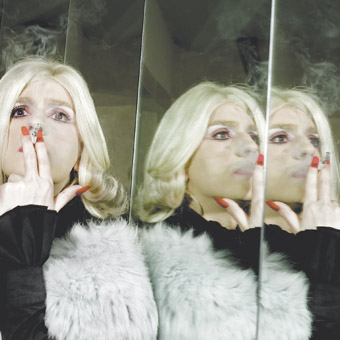
Regina Fez, Regina vs Contemporary Art
photo Rafael Gavalle
Regina Fez, Regina vs Contemporary Art
THE POLITICS OF THEATRE ARE RARELY MOMENTOUS, YET THEY ARE ALWAYS OF THE MOMENT. REGINA VS CONTEMPORARY ART IS A TRANSPLANTED PERFORMANCE, FROM ANOTHER TIME AND PLACE. FIRST PERFORMED IN PORTUGAL IN 2007, THE PIECE IS STYLED AS A PRESS CONFERENCE OR DEBATE, AN ENTERTAINMENT OF TALKING HEADS. BUT IT IS ALSO A BODILY ENCOUNTER, A PHYSICAL CONFRONTATION OF IDEAS, SIZE AND SEXUAL POWER.
Paulo Castro, as “master provocateur Doctor Ribeiro” in hipster jeans and shoulder-length hair, is compact and dynamic. Towering over him is Regina Fez; an immensely tall yet shy, retiring drag queen, she wears a figure-hugging black satin dress, her blond locks coyly covering her face. We applaud their entrance. Castro dances a little for us. Leafing through a newspaper, he presents the news of the day—or yesterday. “It’s Sarah vs Condi”, shrieks a headline. But now it’s late November, post-election. A new politics awaits.
Castro is a theatre director and performer from Portugal, now based in Adelaide (RT88, p37). Regina Fez, from Spain, presents a mysterious figure, hailing from some European border zone between the high seriousness of performance art and the avant garde of underworld porn. In her signature piece—offered to us upstage on hazy video—she vomits goldfish in a car park. As they flip-flop on the concrete, I care about their fate—more, perhaps, than I should.
The subjects of Regina vs Contemporary Art are sex, art, war, activism and terrorism. These are subjects of great moment and passion. But here in Adelaide’s tiny Bakehouse Theatre, at the end of the month-long celebrations of Feast Festival, their passion has all but dissipated, their moment seems displaced.
The tone is confrontational, unreasonable and excessive. The audience is edgy and uncertain, reluctant to respond. There are open-ended offerings in this work, and something quite freewheeling about its form. Castro strips off his shirt and dances with self-erotic pleasure. Regina pulls a tub of Yoplait from her handbag and eats it with a spoon. Invitations are extended to partake.
There are some fellow travellers in the audience—directors, performers and other artists. One reads a passage from Pinter’s War, while another wins a kiss with Regina. A third offers, upon request, his “most bombastic” sentence: “My cock is a weapon of mass destruction.” But I don’t believe his ego. I prefer the soft-edged irony of Regina’s “Lick my Gaza Strip.”
In one fond moment towards the end, Castro and Regina dance in a ballroom embrace, having wrapped themselves in such sentence-signs which they gently shed as they rotate. The sweetness of the moment is sharpened by a pervasive current of sexual aggression. At other times, they argue and they fight. They take their violence offstage and bring it back again. But Regina seems to lack the energy or inclination to offer much in the way of fighting back.
This jangling, nervous elegy to the politics of elsewhere recalled for me the past rhetoric of futurist performance, its audience anxieties elusively translating the dislocation of European desires.
Regina vs Contemporary Art by Paulo Castro with texts by Pinter, Houellebecq, Pasolini with Regina Fez and Paulo Castro, presented by Feast Festival & Castro Stone Productions, Bakehouse Theatre, Adelaide, Nov 25-29, 2008
RealTime issue #89 Feb-March 2009 pg. 36
© Jonathan Bollen; for permission to reproduce apply to realtime@realtimearts.net
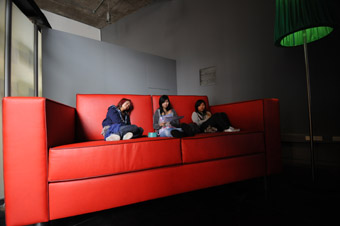
The Room (1994/2007) exhibited in Gravity Be My Friend (2007-2008), Pipilotti Rist. Viewers of Rist’s video works sit on outsized lounges: “When we watch TV the reality around us shrinks or disappears.” (Catalogue)
THE CULTURAL MAGNET WAS IN FULL FORCE DURING LIVERPOOL’S YEAR OF CULTURE 2008. WITH AN IMPRESSIVE PROGRAM OF EXHIBITIONS, PERFORMANCE, DANCE, CONFERENCES AND ASSORTED EVENTS THE LURE TO LIVERPOOL WAS FELT FAR AND WIDE. ONE OF THE EPICENTRES OF THIS CULTURAL LOVE-IN WAS FACT (FOUNDATION FOR ART AND CREATIVE TECHNOLOGY), THE MOVING IMAGE AND NEW MEDIA CENTRE ESTABLISHED IN 1988 AND CURRENTLY UNDER THE ENLIGHTENED DIRECTORSHIP OF MIKE STUBBS.
Many in the Australian cultural sector would know Mike Stubbs from his time at Melbourne’s ACMI (Australian Centre for the Moving Image). As Head of Exhibitions, Stubbs skilfully developed a range of programs that brought together sonic arts, moving image and new media. Now at FACT and working with a savvy team he is developing FACT as a focus for interdisciplinary practices in the UK.
The FACT building itself is surprisingly discrete and tucked away. Situated in the historic Ropewalks area of Liverpool and nestled in amongst warehouses and disused shops, the glass façade offers a stark contrast to the dark hues of Liverpool’s cobbled streets. In many ways the building, opened in 2003 and designed by architects Austin-Smith:Lord, is the direct opposite of the architectural signature style of most contemporary museums and galleries. Rather than screaming, “look at me I’m an icon of art and design”, FACT’s impact is integrated into the scale and history of its surroundings. It is this embedded approach into the fabric of the city that makes it an inviting and popular place for both locals and visitors.
With a café, cinemas, bookshop, black box performance space and galleries, FACT is always busy. There’s a sense that anyone can drop in at any time, have a coffee, read a book, check their email and see a film or exhibition. This welcoming approach in itself provides a gentle introduction for the general public to emerging forms of practice. New media and interactive artworks are often maligned, especially in the media for being user-unfriendly or inaccessible. FACT in many ways works to dispel this myth by directly engaging a wide public with the broad depth of contemporary art practices. The foyer entrance area is constantly in use as an exhibition space, providing an effective lure to explore the gallery, other spaces and ideas generated through FACT’s integrated programming strategies.
Having established itself as a centre for a range of audiences, the populist nature of the Liverpool Capital of Culture additionally provided FACT with a platform to raise its profile and to introduce a range of new programming and curatorial directions. A new director in any arts organisation will work with the team to shake things up, consolidate and develop an artistic vision for the future. With Mike Stubbs taking up his appointment in May 2007, the 2008 Capital of Culture provided an opportunity to introduce a series of annual themes that would engage with and create debate around wider cultural, political and social issues.
The first of these thematic directions, running throughout 2008 was Human Futures. The aim of this year-long program was to create an opportunity for prolonged and sustained debate about complex issues facing the future of humanity. In a series of exhibitions, performances, film programs and debates, questions were raised about how we deal with change, the impact of technology, the ethical and moral issues of scientific research, the limits of the body. The program brought together a broad range of international artists, thinkers, writers and critics to directly engage the public in often difficult and challenging debates. In the publication accompanying the program, Stubbs and Laura Sillars (Head of Program) wrote, “Through actively encouraging experimentation, provocation and interference, we acknowledge that it is artists who have repeatedly provided early warnings to the cultural, economic and political ramifications of new technologies through a variety of mediums, tactics and gestures.”
In developing a thematic discourse, FACT provides a platform for a broad spectrum of artists and positions new media and sci/art practice as a compelling genre from which to question the issues and challenges of the 21st century. With commissioning, exhibition and publication artists are provided with opportunities to expand their practice and develop new bodies of work. For Human Futures, the renowned Swiss video artist Pipilotti Rist premiered a new work Gravity, Be My Friend with additional new elements designed especially for FACT. The international group exhibition Sk-Interfaces, curated by Jens Hauser, explored the idea of skin as a technological interface with installations by Orlan, Stelarc, the Arts Catalyst group, Tissue Culture and Art, Zane Berzina and Julia Reodica. In a very memorable and confronting performance on the opening night of the exhibition, Swiss artist Yann Marrusich sat perfectly still in a perspex box, having ingested methylene blue which, over the course of an hour, slowly seeped from the pores of his body. A symposium was also staged in October and BBC Radio 3 and Radio Merseyside’s Festival of Ideas focused on the broader themes of Human Futures with speakers such as novelist Will Self and the KLF’s [Kopyright Liberation Front] Bill Drummond exploring the 21st Century Brain and The Value of Experience.
In 2009, the thematic thread is Unsustainable and is a response to Liverpool’s 2009 Year of the Environment. A major thrust of this overarching theme is to engage the audience and throughout the year the Climate for Change program will involve workshops, residencies, labs and debates. In responding to the city-wide focus on environment, FACT will open its doors to school groups, students and local residents to become actively involved in the generation of an arts and cultural dialogue around questions around leading an ‘unsustainable’ lifestyle.
A highlight for the year is Abandon Normal Devices, a new festival of cinema and digital culture launching in September, which goes beyond Liverpool with events in Manchester and other centres in England’s northwest. As part of AND, Thai filmmaker Apichatpong Weerasethakul will present a new installation Primitive, exploring further his preoccupation with myth, dream and memory, recounting the last 48 hours in the life of Boonmee, a passionate yogi who is able to remember his former lives.
This integration of cinema, digital media, interactivity and audience engagement is at the heart of FACT’s programming directions. It situates the building as a site for exploration and engagement, but also as a base to extend its reach into new arenas. The team at FACT is acutely aware of the rise and impact of the YouTube generation, DIY media and social networking, and in 2008 established FACT TV. This is an online channel dedicated to broader discussions of FACT’s programming, an outlet for showcasing film and video by artists and an opportunity for the local community to feedback and provide comment on events and exhibitions. FACT TV also provides an increased online presence for FACT’s resident community TV station tenantspin.
FACT is an example of an institution acting as an ‘agent of change.’ In its programming and curatorial approaches it aims to provide a platform for artists and audiences to respond to the transforming landscape of our society, environment and culture. As a regional centre it emphasises local involvement with an outwardly national and international focus. It takes seriously the challenge to our cultural institutions to be pro-active and engaged in the urgent debates of our time.
FACT, Foundation for Art & Creative Technology, Liverpool: www.fact.co.uk
RealTime issue #89 Feb-March 2009 pg. 28
© Julianne Pierce; for permission to reproduce apply to realtime@realtimearts.net
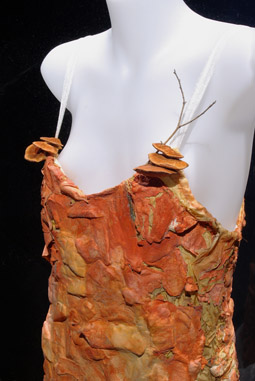
Fibre Reactive (2004-08), Donna Franklin, Coded Cloth
photo Mick Bradley
Fibre Reactive (2004-08), Donna Franklin, Coded Cloth
ROBERT COOK’S MELANCHOLIC MUSING ON THE PASSING OF THE ONCE BRIGHT CYBORG FUTURE (RT61) TRIGGERED MY OWN. AT A CERTAIN MOMENT A CYBORG TRANSFORMATION SEEMED INEVITABLE. SECURE IN OUR SLEEK, IMPENETRABLE SKINS WE WERE TO BE HYBRID, MUTABLE AND INVINCIBLE—HARDWARE TO THE CORE.
Amongst the beautiful but resolutely soft and human objects of Coded Cloth at the Samstag Museum, it’s apparent that we’ve abandoned this dream of glossy exteriors for ones pervious and porous, acknowledging the permeability of skin and cloth. Clothing, always intimately coded with social meaning, continues to offer itself as the interface, the second skin, between body and world. More flexible and adaptable, these skins in Coded Cloth are for weaving code into, transmitting, embedding and wiring.
And so the cyborg has been stripped down through the development of what started variously as installation art, game theory, design, computing, engineering, textile work and science of every description into wearable computing, locative media, bio art, cyborg tech, bio-tech, portable platforms and social networking, dispersed into tags, locators and nodes—pliable, conformable to our bodies and brushing up against our skin.
Coming out of ANAT’s reSkin 2007 wearable computing lab [RT78], Coded Cloth exhibits diverse objects that initially, aside from their material base, seem unconnected. There are few embedded devices here and the connectivity is unwired. The show is, in fact, a sampler of the huge web of intersecting transdisciplinary fields of enquiry around bio art, wearable computing, intelligent textiles and so on and on. What these objects share are operational logics and particular modes of use that extend beyond the interaction of individual and object. The coding here is not necessarily in the weave of the cloth.
Elliat Rich’s Yala Sofa (2008) is made of simple plywood forms. The Yala flowers are invisible until the heat of a seated body makes them bloom—the upholstery is richly printed with thermo-reactive ink. Gathering the Yala, a type of sweet potato, is a communal event for the Pintupi people of the Western Desert that symbolises the connections between people coming together for an action as simple as drinking tea. Even without this knowledge, the flower’s blossoming in the body’s heat suggests a trace of habitation and an intimate event.
Alice Springs-based Rich creates objects and spaces around which events can occur and social practices be sustained. Her Urban Billy (2006) is a self-contained glass billy can that makes a tea event possible anywhere. Rich’s utilitarian objects focus on the spaces and connections created in social moments. In their creation of memory maps and ephemeral traces, her works are themselves a kind of locative media.
Woven of 50% cassette tape, Alyce Santoro’s 2008 Sonic Sails (The Tell-Tail Thankgas) are coded at many levels. The Texas-based artist integrates an almost obsolete technology into the very fabric, doubling the coding with a personally significant sound collage. As the sails lift and shimmer the collage of samples on the tape are played with a tape head decoder producing a densely layered sound tapestry.
In the making of her Sonic Fabric Santoro activates networks keeping skills and tools alive, from the rescue of a specialised loom to cloth production by Tibetan women. Like Rich’s practice, sustainability here goes beyond material choice and connectivity is achieved via eloquent objects.
High Tea with Mrs Woo is a cult Newcastle clothing label with a distinct, almost Edwardian fashion aesthetic. Hidden (2007) is a modified coat dress for the intrepid female, equipped with invisible pocket warmers to enable the wearer to travel light and warm. There’s a touch of steam punk about Hidden, both in the style and in the expressed love of design, innovation and over-engineering. Unlike other wearable computing where integrated devices embed the wearer into the network, Hidden is a very self contained, private kind of wearable connecting only to the body of the wearer. Creating a closed loop, Hidden hints at the hermetic world of the traveller and historical ideas of the properly feminine—stitched down and hidden from view.
Fibre Reactive (2004-08), by Perth-based Donna Franklin, is a simple organza evening dress that provides the base for a tactile skin grown out of the orange bracket fungus. Its unusual elegance overlays a subtle and sophisticated examination of the bio-technological manipulation of living things. Wearing it is a complex act that places the wearer in the position of guardian of this fragile living thing and creates a relationship of equivalence between both lives, questioning, through our relationship with clothing, the commodification of and disposability with which we treat nature.
All of the works in Coded Cloth mine and are part of rich fields of enquiry that are fluid, overlapping and driven by experimentation. Clearly, in the video clip of the ReSkin lab, the participants were having serious fun, yet that sense of productive play hasn’t translated here, due largely to a traditional installation. Located in a dimmed room with spotlit objects on plinths and polite “Please do not sit” signs, Coded Cloth presented as very serious indeed. The show isn’t really about the objects but about their potential in connection with the body. However, interactivity here is limited to just one square each of the Sonic and Yala fabrics. A less reverential presentation might have made for a more engaging experience with what is fascinating work.
Writing about why technology hasn’t democratised the blogosphere, academic Saskia Sassen argues that it’s not the internal logic of the technology that matters but the social logic of the users (Networked Publics Symposium, California, 2006). That social logic changes and subverts the inbuilt logic of the technology. It’s not the wires or the technology but the unwired invisible logic embedded in our brains that counts. Understanding this, the artists of Coded Cloth seamlessly harness and connect internal and external worlds through our second skins.
Coded Cloth, New Media Textiles, curator Melinda Rackham, Anne & Gordon Samstag Museum of Art, University of South Australia, Adelaide, Oct 30-Dec 19, 2008
RealTime issue #89 Feb-March 2009 pg. 29
© Jemima Kemp; for permission to reproduce apply to realtime@realtimearts.net
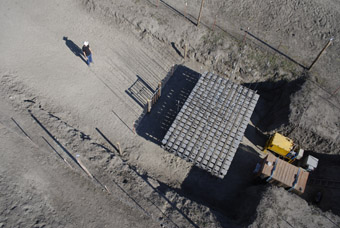
PIEQF, Parkfield Interventional Earthquake Fieldwork taken by Kite Aerial Photography,
photo Scott Haefner, U.S. Geological Survey
PIEQF, Parkfield Interventional Earthquake Fieldwork taken by Kite Aerial Photography,
PARKFIELD IS A STRANGE PLACE TO HOLD A PARTY. THE CENTRAL CALIFORNIAN TOWN, POPULATION 18, HAS ONE RESTAURANT AND ONE SMALL INN, AND GETTING THERE TAKES SOME DOING. IT’S IN ROLLING-HILL RANCH COUNTRY HALFWAY BETWEEN SAN FRANCISCO AND LA, FAR FROM THE SEA.
But what happened here on a warm Sunday morning this past November was definitely a party. Dozens of people—young and old, hipsters and housewives—crowded the rough-hewn tables of the Parkfield Café, loading up on half-pound burgers and big country breakfasts. Others lounged on the oak-shaded lawn just outside, eating picnic lunches, drinking beer and watching someone’s golden retriever splash about in the café’s fountain. Still more milled around in a dusty lot next to the lawn, staring down into a pit that could bury a brontosaurus.
At the bottom of this hole sat an ungainly contraption, a chest-high platform the size and shape of a tennis service box. But any association with tennis was fleeting, because the thing was not genteel. It was all sharp corners and rugged bolts and cables and hoses. Thirty 10-foot-high metal rods rose from its steel-slat surface, scraping the blue Autumn sky. It looked like a giant mechanical spider lying on its back in an open grave.
And everyone was here to see it. The machine was the Parkfield Interventional Earthquake Fieldwork (PIEQF), a melding of science and art. Sydney-based artist DV Rogers set it up in Parkfield in August, after more than a decade of planning, recommissioning, tinkering, and scrounging for funds. This was its last day of operation, and the gathering, at least 75 strong, was a send-off.
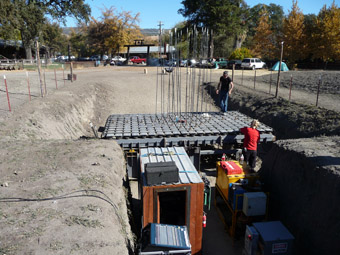
PIEQF, Parkfield Interventional Earthquake Fieldwork, DV Rogers
photo Mike Wall
PIEQF, Parkfield Interventional Earthquake Fieldwork, DV Rogers
The PIEQF is a modified shake table, which engineers use to test how buildings handle earthquake stresses. Rogers linked it up with a network of United States Geological Survey (USGS) seismic sensors across the state. Any time a quake above magnitude 0.1 struck anywhere in California—and this happens about 40 times every day—hydraulic pistons made the PIEQF shudder, rattle and clank. The steel rods bent and swayed like coral polyps in a current. The more intense the quake, the longer the shake.
Rogers put it here, in this tiny town two hours from anywhere, because Parkfield is the earthquake science capital of the world. It sits directly on the San Andreas Fault, a 1300-km-long gash in the ground where the Pacific and North American tectonic plates meet. If California ever cracks off the West Coast and sinks into the Pacific, the San Andreas will likely be to blame. Slips of the fault caused both the 1906 San Francisco earthquake (magnitude 7.8, 3,000 dead) and the 1989 Loma Prieta temblor, centred just north of Monterey Bay (magnitude 6.9, 63 dead).
Parkfield itself gets hit hard and often. Since 1857, seven magnitude 6.0 quakes have hit the area every 20 to 30 years, the last coming in September 2004. Scientists reckoned they could learn a lot about quakes—and maybe even improve their predictions—by studying a place with such regular, repeating ones. So in 1985 the USGS established a massive monitoring presence in Parkfield, and the agency has been here ever since.
The PIEQF—“part machine, part earthwork, part performance”, according to Rogers—was like a seismic antenna, transforming subterranean shock waves into machine-mediated sound and motion. And it was here to give anyone who stopped by, or visited Rogers’ website with its live video feeds (http://pieqf.allshookup.org/), a glimpse of the earth’s churning, straining heart. The PIEQF was very much a site, in the sense articulated by one of Rogers’ biggest inspirations, the American land-art pioneer Robert Smithson. That is, it drew a great deal of its power from being here, in Parkfield, on one of the planet’s widest, longest wounds. All this activity is right under our feet, and we never think about it. Forty quakes a day. Listen to your earth. And watch it move.
The PIEQF made visual the buried dynamism of the landscapes in which we live. It firmed up our sense of place, and our sense of time. For this force, 40 quakes a day, may destroy our buildings, our roads, our bridges, but at heart it is generative. It raises mountains and clears paths for lava to rise from hot, hidden depths. It has shaped the Earth steadily, constantly, over billions of years, and seeing those rods dip and sway reminded us of this fact.
This was a message Rogers wanted the PIEQF to get across. “We engage with geological time in a very shallow way”, he said. “I’m interested in introducing a human timescale to geological time.”
At 12:30, Andy Michael clambered atop the PIEQF, trombone in hand, joining two cellists and a vocalist on the mechanical beast’s back. Michael, a USGS seismologist, initially got Rogers interested in Parkfield a few years ago. And he helped get Rogers the official-sounding (but unpaid) title of USGS artist-in-residence.
The four musicians played two short songs Michael composed: “Earthquake Quartet”, written in 1999, and “Fanfare,” conceived the night before at the party in Parkfield. “Earthquake Quartet” incorporates actual seismograms as percussion, and it is the reason Michael and Rogers first touched base: Rogers heard about the piece and dropped Michael a line.
At the end of “Fanfare”, as the vocals died and the keening of strings leached into the dust, the PIEQF got a solo. For 30 raucous seconds it clattered, clanged, and shuddered, its metal slats rising and falling. But then the pistons stopped pumping, and, after 91 days of continuous operation, 43,000 webcam frames, and more than 4,000 earthquakes, it too was silent.
Now the PIEQF sits in secure storage, waiting for its next curtain. In many ways, Parkfield was just a warm-up. Rogers wants to install it in an urban setting as soon as he can raise the funds. He’s thinking LA, 2010. It’s another earthquake-prone city, and one that desperately needs an appreciation of deep time.
DV Rogers, PIEQF, Parkfield Interventional Earthquake Fieldwork, Parkfield, California, Aug 18-Nov 16, 2008. http://pieqf.allshookup.org
RealTime issue #89 Feb-March 2009 pg. 30
© Michael Wall; for permission to reproduce apply to realtime@realtimearts.net
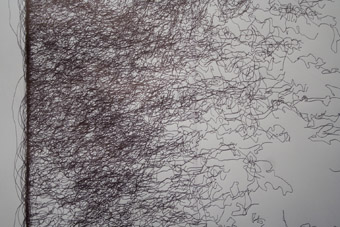
Benjamin Forster, PROCESS=ARTWORK
photo Alexandra Gillespie
Benjamin Forster, PROCESS=ARTWORK
FOR THOSE UNFAMILIAR WITH THE DORKBOT CONCEPT, IT CAN BE THOUGHT OF AS A COLLECTION OF COMMUNITIES AROUND THE WORLD WITH A COMMON INTEREST EXPRESSED THROUGH THE MOTTO “PEOPLE DOING STRANGE THINGS WITH ELECTRICITY.” ESSENTIALLY DORKBOT PROVIDES A LOOSE NETWORK AND STRUCTURE TO FACILITATE ACTIVITIES OF THOSE INTERESTED IN THE FUTURE OF ELECTRONIC ARTS. STARTED IN NEW YORK BY DOUGLAS REPETTO, THE DORKBOT IDEA HAS SPREAD AROUND THE GLOBE. THERE ARE NOW DORKBOT CHAPTERS IN ALMOST ALL AUSTRALIAN CITIES.THE CANBERRA DORKBOT, ESTABLISHED IN EARLY 2008, FINISHED THE YEAR WITH AN EXHIBITION OF WORKS PRESENTED AT THE CANBERRA CONTEMPORARY ART SPACE IN MANUKA IN NOVEMBER.
The immediate impression on entering the exhibition space was of a generous collection of creative practices reaching out into the physical world. The locus of this initial impression was Alexandra Gillespie and Somaya Langley’s collaboration, Collars, with electronics and programming by Ben Lippmeier. This minimal installation, comprising shirt collars on stands with electroluminescent strips of text showing through the material, symbolically questioned power, control and social status. The sound component, based on collected stories from those associated with the shirts, added a further tangible dimension to this installation.
The two other works that functioned in time were by Josh Wodak and Michael Honey. Wodak’s new wave cinema work, Powers That Be, brought together a collage of four voices and associated images into what Wodak described as a “synaesthaic audiovisual relation.” In this instance, one sensory mode triggers or illuminates the other. This synaesthetic experience was interactive in the sense that it is activated by the position of the viewer in the gallery. Honey’s interactive work, Eigenstate, inverted the idea of interaction by generating algorithmic visualisations when the presence of a viewer was not detected by the system. This was a work with explicit reference to scientific concepts, yet the evolution of the imagery had a singularly poetic quality.
In Estuarine Flows, Tracey Meziane Benson presented a series of solar-powered backlit transparencies. These digitally manipulated map images of the boundaries between land and sea reflected the beauty in the structural intricacies of vast environments. The presentation format also seemed calculated to inspire intimacy or personal reflection on the images.
Nathan McGinness’ Leaves was generated through the Processing programming environment. The outcome was visually intriguing and on reflection seemed to question the nature and implications of process in art. It was interesting to consider that although an almost infinite number of outcomes are possible through such a process, the final selection for public presentation is an aesthetic decision made by the artist.
Mitchell Whitelaw’s Limits to Growth reflected a much longer association with generative systems. The elegant prints (about 15) of growth in a model world have a convergent organic and visual information quality. Like the early 1920s works of Mondrian, this collection has the viewer drawn to certain structures without quite knowing why. It would be interesting to correlate a viewer’s focus with the constraints under which the engaging prints were generated. Whitelaw’s second work Watching the Street, was another time-based outcome through the use of slitscan, a time stretching technique using a long series of time-lapse images where narrow slices of each image are extracted and recompiled. The outcome was a visualisation of a scene with curious patterns and an objectivity that we would not appreciate as direct witnesses.
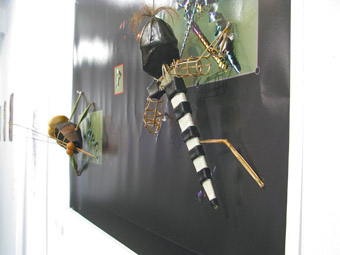
Miles Thorogood, The Developers
photo Mitchell Whitelaw
Miles Thorogood, The Developers
Using recycled materials Miles Thorogood also explored the idea of growth. In The Developers, a three-dimensional construction made from various materials could be seen as an instance from an Artificial Life simulation. Attached to a vertically mounted image were insect-like objects, which seemed to have emerged from a two-dimensional space. One reading of the work is suggestive of our unrelenting expansion and exploitation of the natural environment.
In PROCESS = ARTWORK, Benjamin Forster presented productions from his “drawing machine.” As a triptych of three long “prints”, these reflected an intriguing mechanical insight into interpretation. The work drew on text from Walter Benjamin’s The Work of Art in the Age of Mechanical Reproduction, writings of the Marquis de Sade and images of the grass in Forster’s backyard from the machine itself. The works had a more immediate sense of process when suggesting action and the characteristically nervous scrawl a compelling naiveté. It would have been interesting to see the work generated in real time along with some completed outcomes.
Clem Baker-Finch took a quite different approach in Congregation of the Index with three print works based on the New Testament. Three square prints represented three concentrations of word order: alphabetical, frequency and occurrence were generated. The compelling effect of these lexicons on the viewer was to induce a desire to scan for words and ponder their use and association. This very act prompted curious and often humorous remarks from viewers.
On reflection, the Dorkbot cbr exhibition exemplified the diversity of creativity in electronic arts that is an inherent, long standing and clearly continuing part of the Canberra contemporary art community. To this end, support for the exhibition by David Broker, the director of the Canberra Contemporary Art Space, is to be commended. As with such exhibitions of hybrid practices, diverse formats and sound, the challenge continues for effective presentation with limited time and resources. The complexity and subtlety of each work demanded attention, analysis and reflection and while this could be a challenge for any viewer on a single visit, the overall impression was inspirational.
Dorkbot cbr: Exhibition, People doing strange things with electricity, artists Clem Baker-Finch, Benjamin Forster, Alexandra Gillespie, Michael Honey, Tracey Meziane Benson, Nathan McGinness, Miles Thorogood, Mitchell Whitelaw, Josh Wodak; CCAS (Canberra Contemporary Art Space) Manuka, Nov 7-15, 2008; http://dorkbot.org/dorkbotcbr; International Dorkbot group, http://dorkbot.org
RealTime issue #89 Feb-March 2009 pg. 31
© Alistair Riddell; for permission to reproduce apply to realtime@realtimearts.net
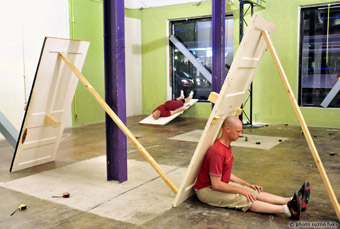
James Cunningham, Jondi Keane, Tuning Fork
photo Suzon Fuks
James Cunningham, Jondi Keane, Tuning Fork
THREE STANDOUT WORKS AT THE JUDITH WRIGHT CENTRE IN BRISBANE LATE LAST YEAR HAPPENED TO RUN CONCURRENTLY. SEEN CLOSE TOGETHER, WHAT STOOD OUT ABOUT THESE PERFORMANCES WAS THAT IN WILDLY DIVERSE WAYS THEY APPEARED MORE OR LESS CONSCIOUSLY TO BE MINING VEINS FROM THE 1960S AND 70S, NOT IN A RETRO SENSE BUT THE BETTER TO LEAP FORWARD. EACH CAN BE SEEN AS CONTINUING INVESTIGATIONS INTO “THE INTER-IMPLICATIONS AND MATERIAL PROCESSES THAT CONNECT ART TO DAILY LIFE” (JAMES CUNNINGHAM, JONDI KEANE) THAT PREOCCUPIED THE EARLIER PERIOD. THIS APPARENT RETURN TO THEORETICAL AND FORMAL CONCERNS OF A SEMINAL EPOCH SEEMS TO ME TO BE OPTIMISTIC RATHER THAN A GESTURE OF HELPLESSNESS IN THESE TIMES, AN ATTEMPT BY THOUGHTFUL ARTISTS, IN TS ELIOT’S PHRASE, AT “PURIFYING THE LANGUAGE OF THE TRIBE.” GOD KNOWS WE NEED IT.
This was most clearly the case in Tuning Fork, created and performed by James Cunningham and Jondi Keane. Theirs was a work that deliberately engaged with the new performance parameters propounded in the 60s by the likes of Kaprow and Cage, lending them an elasticity that authentically stretched to the present. Tuning Fork was a time-based performance which took place in the shopfront at the Judith Wright Centre and was thus visible to passersby. Monitors displayed time-lapse footage of the erection and dismantling of the work.
Discounting good natured exhibitionism and the odd caustic critic (“art wankers!”), this out of sync discrepancy with the live action proved a beguiling hook for many onlookers, while others apparently succumbed to that most peerless of activities: watching others work. Watching the audience inside too, working at being an audience. The performance, however skewed and unrelated to any pragmatic function, nevertheless resembled a construction site. Common construction materials—wooden doors, beams, steel, carbon fibre rods, tape measures, electrical tape—were all utilised to reconfigure and suggest new links between the height, length and breadth of the original site subdivided by I-beams and three large window boxes set into the shopfront. Carbon rods described parabolas within the space, imperceptibly suggesting the metaphysical tension of Cunningham’s lovely, Leunig-like image of a room as a little box (cube) on the curved surface of the round world. Held aloft, they shimmied together, emitting a susurrus from the natural world. At other times, rods were used as chitinous antennae. Steel rods slid along the floor smashed into walls, decrying limits. Cunningham leans backwards supported by the combined tensile strength of rods. At one point, Keane inserts rods through Cunningham’s clothing, transforming him into a weird kind of kinetic sculpture, a grunge creature reminiscent of Kurosawa’s Macbeth in Throne of Blood stuck like a porcupine with arrows. In the end, more rods connected the performers’ heads to the ceiling as they slowly revolved like a model of the Copernican universe.
Tape measures were given an anarchic life of their own in order to function as agents of misrule. Or else to pinpoint minute aspects of the space, as when suspended from a hitherto invisible nail or crevice in the wall. In this way attention often shifted from minutiae to larger dimensions of action in the space, lending the space itself the characteristic of a breathing animal. At other moments the silence and absolute stillness made it seem as if it was the space holding its breath. This tallied with the stated objective of trying to reverse the figure-ground relationship so that the site might come to the fore and take on new meaning. Moreover, the performers’ proposition that “a tuning, attuning, or retuning of the base-line of perception and action is the next productive (versus reactive) step” was more than ratified by moments I relate to the Buddhist idea of tathata, suchness, the recognition of the irreducible, indescribable nature of an object, a sound, a person. From this perspective, the work might be seen as incorporating a powerful environmental politics.
There was an obvious dialectic between the approaches of the two performers. Coming from a dance background, Cunningham seemed more focused on objects as extensions of the body, or touching other objects to elicit the life of the object itself. At the same time his movements were more abstract, more concerned with exploring the space as a performer. By contrast, Keane was task-orientated. As he says, he operates within a field of consciousness that is related to professional sports, performing actions with an awareness of how they are both backgrounded and foregrounded. While the architectonic result was a well mapped out composition, the process was not directed towards the creation of a work of art. Rather it was a case of enacting embodied moments that join the common world. As Keane expresses it, “we’re not doing art and we’re not doing non-art. We’re doing stuff together.” Sculptural and other elements in the course of the performance remained separate—constituting a performance of resistance where the dialectical process proceeds and contradictions are synthesised, only to break out again into contradictions. Tuning Fork was a valid demonstration of the concretisation of meaning and material processes as an essential element of the dialectical process itself. A source of quiet marvels. The good stuff.
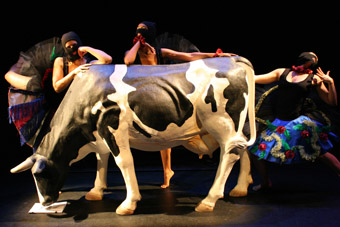
Phluxus , The Opposite of Prompt, Dance Collective
photo Marisa Cuzzolaro
Phluxus , The Opposite of Prompt, Dance Collective
The Opposite of Prompt, a collaboration between the independent artists of Phluxus Dance Collective and dancer-actor Brian Lucas, happily took on the self-critical and Brechtian strain of the 70s along with madcap elements of Dada. It delightfully deconstructs and demystifies, playing a tricksy match of handball with the audience, positing “the inescapable solid reality of performance versus the wildly imaginative and unpredictable thing that is reality.” A life-sized model of a black and white cow plays a prominent role in this regard (“Stop looking at the cow!”). Originally it was meant to be a real cow, but I can see the problems…Life, after all, is artifice, and Art? Well, Art has abandoned itself. Or at least abandoned us. Art occurred offstage, behind drawn curtains; we were only witnesses to the exits and entrances. To the hysteria. To the needs. We ourselves enter and exit OP side. Stuck in life. As Lucas says, “I’m in my apartment, in a wheelchair. I’m crippled, and I see a lot of suspicious things happening. But I connect the dots, I work out what’s happening. Or perhaps not.”
Certainly the Luciferian Lucas has the ability to pull the carpet from under our feet, revealing the abyss. He told the story of a woman who had a sick friend whom she helped to suicide to avoid needless suffering. She was convicted and sent to prison. But the woman was terminally ill and, terrified of dying alone in prison, in turn killed herself. The story is repeated several times during the performance, accompanied by a sequence of dance gestures. Finally it is the gestures themselves that tell the tale, in a characteristic Lucas move. It was pure pleasure to be reminded that Lucas is such a superb dancer, particularly in the beautifully clean, incredibly controlled, hence expressive and humorous duet performed with an equally polished Chaffia Brooks—all within the constraints of aircraft seats.
The Opposite of Prompt was a participatory sport. And there was so much more. It seduced the audience without resiling from the questions it blithely threw up in the air. Largely this was attributable to the quality of inclusiveness Phluxus extended, translating into a uniquely grounded collective style—seriously funky.
Jacqui Carroll’s To Have Done With The Judgement Of God for the Bell Tower 11 Series 2008 espoused the roots of Artaud’s Theatre of Cruelty first introduced to the Anglo-Saxon world by Peter Brook in the 1960s. Based on a 1947 radio performance by the man himself, this work-in-progress goes somewhere else in terms of Ozfrank’s previous work. Carroll’s investigation into the male psyche was shocking, scatalogical, darkly liturgical. I loved it.
Tuning Fork, created and performed by James Cunningham and Jondi Keane; Shopfront, Judith Wright Centre, Brisbane, Nov 19-23 & 26-29; Opposite Of Prompt, artists Phluxus Dance Collective (Nerida Matthaei, Chafia Brooks, Skye Sewell) and Brian Lucas, lighting design Keith Clark, soundscape construction Brian Lucas, costume design Rosa Hirakata, set construction Corrin Matthews, Shane Rynehart; Judith Wright Centre, Brisbane, November 26-29; Ozfrank, To Have Done With The Judgement Of God, creator, Jacqui Carroll; Theatre Rehearsal Room, Judith Wright Centre, Brisbane, November 27, 2008
RealTime issue #89 Feb-March 2009 pg. 32
© Doug Leonard; for permission to reproduce apply to realtime@realtimearts.net
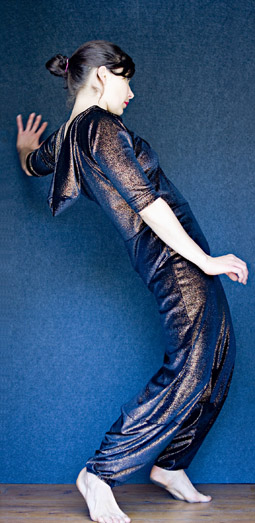
Deanne Butterworth, Vianne
photo Rohan Young
Deanne Butterworth, Vianne
“THE EMERGENCE OF THE ‘FRAME’ IS THE CONDITION OF ALL THE ARTS AND IS THE PARTICULAR CONTRIBUTION OF ARCHITECTURE TO THE TAMING OF THE VIRTUAL.” ELIZABETH GROSZ
In Chaos, Territory, Art (New York: Columbia University Press, 2008), Elizabeth Grosz writes of the frame as a basic element of the artwork. The frame provides an edge. It separates so that we can experience that which it frames. Shelley Lasica’s Vianne institutes many kinds of framing. Physically it is set inside a large, downstairs city theatre space, flanked by laneways on two sides. We can see out onto the laneway. Its fading, crepuscular light establishes the interiority of the room. During the course of the performance, a large light illuminates the lane. Later, another arises inside, shifting the origin of light—fashioning a series of emerging and dying suns. What we see, we see in virtue of these tangible sources. Their emergence and diminution draws attention to the relation between each light source and its zone of illumination. Looking beyond the room (into the laneway) circumscribes the room. It is not the world, rather it is a world within the world.
And within that world is constructed an even smaller world. This small world is a cube made of soft plastic (by Anne-Marie May). Hoisted into position by the dancers, it frames an inner space, another space of action. Some of the dancers traverse that space, others stay inside it for a while. This small world collapses, breathes out, flattens. Spatial boundaries are thus fluid. Like the lighting (Ben Cobham), the physical objects and their manner of framing are subject to change. A liquid-like sculpture is suspended from the ceiling towards the back of the room, flowing into the floor. Later, a related soft, plastic, linear thread is suspended between two dancers. In each case, we are invited to watch the action within, across and according to these shifting frames.
The room itself calls for choices on the part of the audience. Since the action moves across and between large steel poles that support the roof, we have to decide who and what to watch. The action does not entirely dictate these choices, for there is more going on than we can see. Our focus variously engages the shifting points of action, lighting and construction. That movement between structural, shifting elemental qualities, including the roving perceptual field of the audience itself, constitutes an ongoing framing and reframing process. This is permeated by the shifting rhythmic qualities of the music (Milo Kossowski and Morgan McWaters). The music moves imperceptibly between a range of tones and qualities: ambient, insistent, thumping, stellar, epic, abstract. It is evocative but not dominating.
Five dancers march into the space, all dressed in sparkling jumpsuits. One (Deanne Butterworth) stands out, rendered different by the colour of her costume, orange. There is a sociality to this nexus of human interactions, though their meaning is not obvious. Over the course of time, a narrative of sorts unfolds, suggestive of some kind of drama, though remote at the same time, as if its canvas has been painted over, sanded back and bleached (but not emptied) of emotion. Movement phrases are individually executed, alongside the formation of duos and trios. The partnering evokes a range of feelings: tender, aggressive, intimate, depending on who we watch and how they work together. However interpreted, we see dancers move together, push against each other, give weight, circle each other, execute phrase materials, and return to repeat the exercise. A mini-world is created, with boundaries that some respect, and others transgress. Sometimes everyone comes together in a row, shifting weight back and forth, a Greek chorus compared with so much atomic and molecular (inter)action.
If Butterworth is Vianne, she is not the central figure of this work. She orbits and enters the action as a human amongst others. There is no hero here, rather a complex mingling of physical subjectivities in a range of shifting formations. There is a play between the ways the bodies are shaped by their context and the agency of those bodies. The audience is also held accountable for its engagement with the work. The dancers are crisp and clear, responsible and reliable. If I could add my own preference, it would be to make of their own bodies another interiority, to take more time to feel that which occurs within in the context of their moving. The collaborative texture of Vianne suggests that no one person holds the key to its interpretation.There is no bird’s eye view, just the feeling that there is more to be revealed of this intricate composition.
Vianne, choreographer, director Shelley Lasica, dancers, Deanne Butterworth, Timothy Harvey, Jo Lloyd, Bonnie Paskas, Lee Serle, music Milo Kossowski, Morgan McWaters (PEACE OUT!), design Anne-Marie May, costumes Shelley Lasica, Kara Baker (PROJECT), lighting, design consultants Bluebottle/Ben Cobham; fortyfivedownstairs, Melbourne. Dec 3–14, 2008
RealTime issue #89 Feb-March 2009 pg. 33
© Philipa Rothfield; for permission to reproduce apply to realtime@realtimearts.net
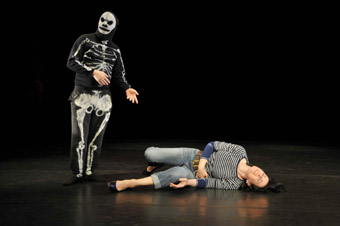
Robin Arthur, Claire Marshall, Spectacular, Forced Entertainment
photo Hugo Glendinning
Robin Arthur, Claire Marshall, Spectacular, Forced Entertainment
A MAN (ROBIN ARTHUR), IN A CRUDELY PAINTED SKELETON SUIT WHICH LOOKS A LITTLE TOO SMALL FOR HIM, WALKS OUT ONTO A BARE STAGE, GLANCES AROUND HIM, RUBS HIS CHIN. HE’S PERPLEXED. IT’S EVERY ACTOR’S NIGHTMARE: THE SET ISN’T WHERE IT SHOULD BE, NONE OF THE OTHER PERFORMERS ARE THERE, THE WARM-UP GUY HASN’T TURNED UP…NORMALLY, HE INFORMS US NERVOUSLY, NORMALLY THERE ARE POTTED PLANTS…IN THE ABSENCE OF THESE NORMS, HE RUMINATES, “AM I REALLY THE RIGHT PERSON FOR THIS POSITION?” HE FRETS ABOUT THE RIDICULOUSNESS OF HIS APPEARANCE (“THIS ISN’T HALLOWEEN”); HE SIGHS, “IT’S A STRANGE WAY TO EARN YOUR LIVING.”
Eventually a woman (Claire Marshall) appears, dressed in jeans and a T-shirt, and announces into the microphone that she has come to do her death scene. This is a parody of all death scenes—something like a cross between a fatal poisoning in a Victorian melodrama, a soldier on the battlefield or a re-enactment of the infamous Alien stomach explosion. Her violent dying takes her across the width of the stage; it moves but is not moving. Arthur starts to critique her technique, offer suggestions: the sobbing is good, it’s subtle; but what does a dying person need with a microphone stand? And so Spectacular continues exactly along these parallel lines of enquiry for an hour and 15 minutes.
Throughout, Arthur tells us how we would have been reacting if we were watching the other show, the show that should have been. This absence is something of which we become increasingly aware. There’s the absence of the rest of the collective, the absence of any development. Conceptually, this could be interesting. Instead of passive spectators, avidly consuming spectacle, we are required to become co-creators, using Arthur’s descriptions of the mythical lost performance (one in which he makes his entrance on a staircase, in which there is a band, and girls who dance in figures-of-eight, and flickers of ticker tape) to create our own private shows. (Mine is sheer vaudeville; Spectacular Spectacular as the Moulin Rouge song goes.) This ploy is not unlike that of a Croatian arts critic who used to write reviews of performances without seeing them. Unaware a concert was cancelled at the last minute, he wrote his review as usual and was rumbled. His response to complaints? He’d seen the work in his head so, as far as he was concerned, it happened. It’s not new to Forced Entertainment’s practice either; it has often relied on our participation. (If you were bored after a couple of hours of their show 12am: Awake and Looking Down it meant you weren’t working your imagination hard enough.) Actually, in many ways Spectacular is more accessible than previous Forced Entertainment shows. We are watching an actor coming to terms with the loss of his play and this self-reflexivity is familiar territory for theatre audiences (Pirandello explored this terrain in the 1920s).
The difficulty I have with it in practice is that the absent show in Spectacular is also the ghost of shows past. Spectacle is something Forced Entertainment used to do so well: television screens, paper crowns, animal masks, cardboard signs, neon text, bad wigs, velvet capes, John Avery’s music, a whole starry universe, physical exertion, text like poetry that overlaps and contradicts and refuses to cohere…I’ve followed their work since 1990 but there is Robin Arthur, patting his belly, telling us his age (45), reminding us the collective have moved on. There has been a stripping down of their aesthetic, a desire to push audiences further. During their 25 years, preoccupations have changed. Forced Entertainment member Cathy Naden once said the Gulf War occurring during the making of Marina and Lee “crept into the text and little parts of the show” but was never explicitly referenced; here the Iraq War is. Why do we want to see death in the theatre when we are surrounded by it, Arthur asks? Yet death has always been a preoccupation (shootings, hostages held at gunpoint in apocalyptic newsrooms), so the question is perhaps self-directed.
The performers are still incredible. Claire Marshall has the kind of presence that means she could just sit there and you would want to look at her. (In fact, she did just sit there in Hidden J, in1994, with a sign around her neck saying “Liar.”) Robin Arthur’s actor in the skeleton suit is a tour de force. Except this time it isn’t enough. We are supposed to be watching two deaths: Marshall’s physical one, Arthur’s metaphorical one (‘he died a death on stage’, we say of an unfunny stand-up comedian) except that neither one dies. Marshall may only have a few lines but she has a guttural repertoire of grunts, groans, screams and heavy breathing and, like the bogeyman in a slasher horror, she too just refuses to die. This is the paradox: in a show about absence or space, there is no space. (Arthur even says so: “There’s no space here.” Barely a hiatus in his monologue. It’s as if he’s scared of the silence.) Despite the humour, it’s relentless. Not even painful. Just boring.
Lights go on and off, on and off, Arthur says. A reference to Michael Creed’s infamous Turner Prize installation? I begin to feel excited by spotlights wavering on empty spots (again like actors with no roles), or alternating between pink and yellow. Is this the point? That if you remove everything, we will invest whatever you give us back with more significance and delight? I can’t help feeling David Weber-Krebs’ This Performance set up expectations and frustrated them in a more elegant, minimal way (see Virginia Baxter’s review).
I don’t doubt the boredom is intentional. “It’s a little bit disappointing”, Arthur says. It takes guts to drag your audience with you, to challenge their desire to be stimulated, to almost goad them into walking out and maybe it’s something Forced Entertainment can afford to try. (Is this the first time the collective lives up to its name?) The company has, deservedly, a loyal following. And when the mid-life crisis passes, we’ll all still be here, looking forward to something spectacular.
Forced Entertainment, Spectacular, director Tim Etchells, text Tim Etchells, Robin Arthur, the company; performers Robin Arthur, Claire Marshall, design Richard Lowdon, lighting design Nigel Edwards, Riverside Studios, London, Nov 6-15, 2008
RealTime issue #89 Feb-March 2009 pg. 34
© Marie-Anne Mancio; for permission to reproduce apply to realtime@realtimearts.net
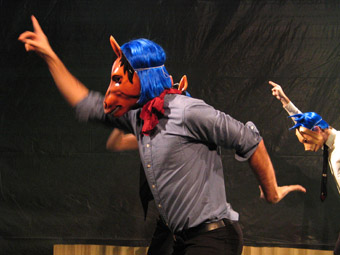
The Bluebird, Witness Relocation
photo Jonathan Slaff
The Bluebird, Witness Relocation
DAN SAFER, ARTISTIC DIRECTOR OF NEW YORK BASED PERFORMANCE COMPANY WITNESS RELOCATION (FOUNDED IN 2000) APPROACHES PERFORMANCE MAKING AS AN ATTACK—MORE AKIN TO A BOXING MATCH OR A SPORTING EVENT. THE WORK AND HE ARE “PLAYING AGAINST EACH OTHER, COLLIDING WITH EACH OTHER, FACING EACH OTHER IN THE EYE.” IT IS THE STRUGGLE THAT IS IMPORTANT—A SERIES OF PROBLEMS TO BE SOLVED. AS A RESULT, MOST OF HIS SHOWS HAVE THE WORD ‘VERSUS’ IN THE TITLE: DANCING VS THE RAT EXPERIMENT OR DANCING VS BLOOD ON THE CAT’S NECK (NOTE THE ANIMAL THEME).
While in New York, thanks to the Victoria University Solo Residency Program, I‘m lucky enough to be invited into rehearsals of Witness Relocation’s most recent work, The Bluebird, a play by Mikuni Yanaihara of the acclaimed Japanese dance company Nibrol. The work premiered in January 2009 as part of the Spotlight Japan Festival of new Japanese work. The Bluebird is Yanaihara’s first play and the first time in years that Safer has worked on a script rather than a devised work. It’s partly inspired by a 1980 Japanese anime series, is set (possibly) in a psychiatric institution, and revolves around “scientific conundrums, the rescue of endangered species and the search for one’s personal blue bird.”
Before entering the studio for my first day of rehearsals (they have already been working for one week), I meet Safer at a nearby coffee shop. He is a wonderful mass of contradictions. His tight black jeans, chains and tattoos belie a fiercely intelligent and passionate graduate of New York University’s Tisch School—where he is now also a sessional teacher. Over a typical New York ‘bowl’ of coffee, we talk ideas and theatrical obsessions. We concur on our love of Tim Etchells, DV8, Wiliam Forsythe, and David Lynch. He is a big fan of nightclub cabaret where he used to perform as a go-go dancer. He also appeared in shows with Antony (of Antony and the Johnsons) and his group Blacklips. Safer’s work is very influenced by punk/drag/cabaret/night club genres.
His mission for Witness Relocation is to “combine dance and theatre with the energy of a rock show—to explode contemporary culture into intensely physical, outrageous, poetic, and sometimes brutal performance.” He tells me that all his work is about violence and the end of the world. I ask him how he came up with the company’s name. The answer: when someone asked him where he recruited people willing to do ‘such things’ on stage he jokingly replied that they were part of the government witness relocation program—and it struck him that this was the perfect name for his new company.
Before entering the studio, Safer warns me he thinks that most of the work he does can be on the edge of being incredibly awful. Inside, the 10 performers are warming up—preparing for battle stations. The spirit of the rehearsals is playful, yet incredibly focused. They start with a barrage of dirty jokes. The rivalry has begun as they verbally spar with each other.
They are called to arms—soldiers on the front line of contemporary performance—and begin with a ‘dance’ choreographed out of their initial response to the script. It is fast paced, humorous and refreshingly original—the search for the ‘bluebird’ of the title. Safer asks his performers to give him a shell of a choreography that he can then “fuck” with. He doesn’t go for perfection. Although the choreography is strict, he is more interested in the diversity of the individual characteristics of the performers—their personality quirks, performance styles and body types. And these particular performers are variously small, thick set, young and old, traditional dancers and straight actors.
Safer’s directing style is wild and discordant yet still exacting and precise. His motto is “faster, louder, funnier” and the word “uncomfortable” is often heard in rehearsal. He gauges the workability of a piece by his own ‘boredom’ tolerance. He says: “If I get bored, I change things. If I am bored then the audience is bored.” And change happens swiftly as a result. He pushes his performers to the extremes, challenging limits and playing with what he can get away with. In one Witness Relocation show, Vicious Dogs on Premises, he randomly changes, nightly, the order of scenes as well as the performers’ roles.
And the performers never flinch. There is an unmitigated ‘yes’ attitude in the rehearsal as the performers up the ante by challenging and daring each other. The ultimate winning moment in my weeks with them was a spontaneous feigned act of cunnilingus—creating a pause of disbelief, then fits of laughter.
Rehearsals continue with regular script editing (at least one third of the text is cut), music (which plays a central role) and vocal and physical play. Much like a film director, Safer works on random parts of the script, eventually weaving them together. He creates ‘movie swipe’ style transitions—four performers crossing the space, perhaps looking for the lost bluebird species—to magically reveal the next scene. Shells of scenes are built with gestural choreography and heightened language. The tragic last scene, where the inmates all realise the futility of their existence, emerges as Safer clashes epic Michael Nyman music with the text—forcing the performers to rise to the challenge.
The deadline looms. How does it all fit together? I leave Witness Relocation on the last day before the New Year break and before the first performance. Back home I wonder how I can continue this relationship with a company whose extreme performance style resonates within my own core. The season starts and they play to full houses. I ask Safer about the response to this wild piece. He tells me that someone said they thought it was so funny but then suddenly they realised how sad it was. He‘s happy with that, and with another response (and his favourite): “That was amazing and a total mind fuck”.
www.witnessrelocation.org
RealTime issue #89 Feb-March 2009 pg. 26
© Deborah Lieser-Moore; for permission to reproduce apply to realtime@realtimearts.net
IN BACK OF BURKE, SALLY LEWRY SPINS US A YARN, A TRUE STORY, OF HER FATHER AND HIS ANTICS, TOLD WITH HUMOUR UNDERLINED WITH UNEASINESS. LEWRY IS ALMOST NEVER HERSELF: SHE IS FLAG-FOLDING EXPERT, FATHER, LOCAL JUDGE, BUT MOST OFTEN SHE IS A SHEEP. IN WOOLLY HAT AND FIRST PERSON SHE TELLS OF THE UNTIMELY DEMISE OF A NUMBER OF SHEEP EMPLOYED AS PART OF HER FATHER’S ECCENTRIC VERSION OF BACKYARD BLITZ. IT SEEMS IT WAS A ROUGH LIFE FOR THESE SHEEP IN BLACKTOWN, AS WE MAY ASSUME IT WAS FOR THE ARTSY-FARTSY DAUGHTER (THE BLACK SHEEP), NOT TO MENTION THE MOTHER, SHIRL, WHO IS ONLY MENTIONED IN PASSING BUT WHOSE IMAGE IS LEFT FOR US TO CONTEMPLATE AT THE END.
Back of Burke has some good writing, and Lewry is a truly engaging and edgy storyteller. An overhead projector is a neat device for DIY imagery particularly well used when she ‘illustrates’ stories. My niggling issue with the piece is about the flag-folding sections that bookend the show. Though these allow for the manipulation of the ‘flag’ as projection screen, it feels like a near-miss metaphor. Flying your flag, your past, your allegiances, or “putting them in the bottom drawer”, kind of works, but the flag is also a strong symbol of nationalism and militarism, a far cry from Lewry’s portrait of her fiercely individualistic father. These overtones muddied the metaphor and as the idea is only alluded to at beginning and end, with no presence in the central body of the work, it felt like an attempt to wrap up the work too tightly—to fold it too neatly perhaps. Metaphoric debates aside, Lewry is a skilled writer and performer and I look forward to more work from her.
The Paper Woman is mostly a physical performance, a form in which XX has been developing her own vocabulary: angular and suspended yet undercut with moments of frantic frustration, sometimes abject and always curious. The Paper Woman’s world consists of a bed, some suitcases, falling grapefruit, an industrial fan, various sound transmitting devices and a shopping trolley. X squat walks, crawls and gallops around this world interacting with the objects and the architecture of the space creating curious images that don’t strike immediate resonances: she holds a grapefruit under her chin, she carries a mattress up the staircase, she dribbles milk in front of the fan. These images are not from our world, but the Paper Woman’s and they all make complete sense to her. The Paper Woman is perhaps the closest to a performance of dream logic I have seen. Actions are started and stopped with equal abruptness, but undertaken with complete absorption. Within this logic the Paper Woman’s world is strangely complete yet devastatingly fragile—balancing awkwardly like X on her tippy-toes. I don’t really know where I am in this and as a viewer perhaps it is best not to impose waking rules but rather see where X takes you. What I do know is that only XX can make this world, and that renders it something quite special.
Two New Solos: Back of Burke, Sally Lewry, mentor Deborah Pollard; The Paper Woman, XX, mentor Regina Heilmann; PACT presents… initiative, Sydney, Jan 23-Feb 1
RealTime issue #89 Feb-March 2009 pg. 35
© Gail Priest; for permission to reproduce apply to realtime@realtimearts.net
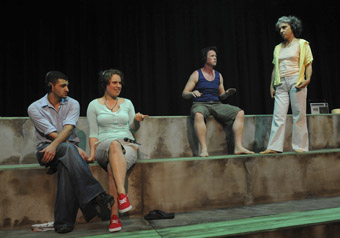
Mohammed Ahmad, Janie Gibson, Roderic Byrnes, Katia Molino, Stories of Love & Hate, Urban Theatre Projects
photo Heidrun Löhr
Mohammed Ahmad, Janie Gibson, Roderic Byrnes, Katia Molino, Stories of Love & Hate, Urban Theatre Projects
IT IS A DUBIOUS GENRE TO HAVE WITHIN THE NATIONAL REPERTOIRE BUT THERE ARE NOW SEVERAL PLAYS WRITTEN IN RESPONSE THE CRONULLA RIOTS IN 2005. THESE INCLUDE SUZIE MILLER’S ALL THE BLOOD AND ALL THE WATER, NOELLE JANACZEWSKA’S AND ATYP’S THIS TERRITORY, LAURA SCRIVANO’S THE CRONULLA PROJECT, AND BIGHART’S JUNK THEORY. AMONG THE MOST RECENT AND MOST ACCOMPLISHED OF THESE IS URBAN THEATRE PROJECTS’ STORIES OF LOVE & HATE.
Rather than confronting the Cronulla riots directly, director Roslyn Oades comes at the issue from an angle, stating in her program note that the play “is not a work about the riots, but rather a work about the ordinary people who were there.” As with her previous effort, Fast Cars & Tractor Engines (RT 70, p41), Oades has interviewed dozens of people in order create an audio-script, which is then played through headphones to actors, who repeat the lines as they hear them.
The first voice we hear is Oades’, piped in over the loudspeaker. She is in the process of setting up an interview with a young man and asking him for a definition of love. He offers one before endearingly asking “Is that alright? Do you agree?” We also meet a middle-aged couple, whose love is such that he still buys her flowers: “the other day,” he says; “the other month”, she says simultaneously. For others, love is less about a person and more about an activity such as surfing—“It’s like being in the fallopian tube again, I reckon”, “It’s a whole-body out-of-body experience”—or driving. One of the young men finds the sound of the bass literally heart-stopping—“It’s true!” he exclaims, “You can die from bass!” From here we segue into Love Song Dedications and as the strains of Kenny G’s saxophone waft through the space, Richard Mercer takes a call. These love song dedications scenes recur throughout the production to lessening effect—they seem a touch contrived and too easy to parody. Nevertheless, they provide sound artist Bob Scott with the opportunity to air a few old favourites including “Sexual Healing”, “Under the Bridge”, “O What a Beautiful Morning!” and “I Wouldn’t Trade You For the World.”
Having circled around the topic of love, the play slowly spirals inwards towards issues of hate and eventually to the events themselves. Intriguingly, divisions emerge within as well as between communities. One character is careful to point out that Punchbowl is no Mount Druitt and three young Lebanese men jokingly refer to their “ghetto” and debate whether or not they are Lebanese, wogs, Middle Eastern Australians or Middle Eastern wogs. Likewise, surfies are dismissive of those who have Southern Cross tattoos that mean nothing whereas they have scars that tell “ridiculous stories.” When the discussion finally moves to the day of the riot, the surfers insist that there were hardly any locals at the scene, that it was mainly “roo shooters and Romper Stompers.” Whoever was there was intent on violence, as a policeman and photographer reveal. A flower-giving husband is revealed as the baton-wielding policeman who saved two men who were being beaten on the train. So shocked is the photographer by the ferocity of these attacks, he says simply, “I put my camera down. I put my camera down.”
Playing against type, gender, and ethnicity, the actors do not always manage to bridge the gap between performer and character. However this does not make the work any less interesting for the spectator. On the contrary, it is fascinating to listen to Roderic Byrnes imitate the intonations of a proud Lebanese father, to hear Mohammed Ahmad giggling as a schoolgirl, to see Katia Molino’s uncanny incarnation of a conceited Cronulla schoolgirl, and to watch Janie Gibson adopting the language and posture of a young Lebanese man.
In the final scene, we hear the recording of an old lady as well as Molino’s repetition of it. Inevitably they are not the same and this serves not only as a metatheatrical reminder about the nature of repetition and mediation, but also makes visible the invisible labour of listening. Listening is a strain, it demands intense concentration, and despite our best efforts we sometimes mis-hear and repeat something else as in Chinese Whispers. The mention of this game hints at the hidden connections between multiculturalism and verbatim theatre. So much of the rhetoric surrounding both is about enabling subaltern or minority subjects to speak to the mainstream. But through its distinctive performance mode Stories of Love & Hate succeeds in shifting the emphasis from speaking to listening. In doing so the work shifts the language of multiculturalism itself, returning responsibility to mainstream subjects and asking ‘How do you listen?’ To whom and in what context? And when was the last time you really listened?’
The arduous listening of Oades and her cast contrasts sharply with the profound absence of listening that lies at the heart of the Cronulla riots. In repeating these stories of love and hate with such sensitivity and artistry, the performance provides us with an opportunity to re-hear our fellow citizens and to rehearse new modes of local, cultural, and national belonging.
Urban Theatre Projects, Stories of Love & Hate, direction & original concept Roslyn Oades, performer Mohammed Ahmad, Roderic Byrnes, Janie Gibson, Katia Molino, designer Clare Britton, sound artist Bob Scott, lighting designer Neil Simpson; Hazelhurst Regional Art Gallery, Gymea, November 19-22; Olympic Parade Theatre, Bankstown, November 26-29, 2008
RealTime issue #89 Feb-March 2009 pg. 36
© Caroline Wake; for permission to reproduce apply to realtime@realtimearts.net

Immaterial’s (detail), Joyce Hinterding and David Haines
photo Vanessa Van Emerick
Immaterial’s (detail), Joyce Hinterding and David Haines
WRITING THIS ARTICLE IN THE STERILE AIR CONDITIONING OF MY OFFICE IN SYDNEY I AM STRANGELY CLOSE TO THE ARTWORKS I AM REVIEWING. A SCENT DESCRIBED BY ARTISTS DAVID HAINES AND JOYCE HINTERDING AS “THE MOMENTS BEFORE A THUNDERSTORM” WAFTS OUT FROM MY NOTEBOOK. THIS PERFUME, IONISATION, IS AN INTERPRETATION OF THE SMELL OF THE SUN, OR MORE PRECISELY THE SMELL OF THE INTERACTION BETWEEN THE SUN AND THE AIR. IT IS ONE OF TWO FRAGRANCES IN THE INSTALLATION EARTHSTAR. WHEN I VISITED THE WORK WEEKS AGO IN BRISBANE, I STUCK A PAPER STRIP STEEPED IN THE FRAGRANCE AMONGST MY NOTES. IT IS 34 DEGREES OUTSIDE TODAY, AND I LONG FOR A THUNDERSTORM. THE SKY IS AN INTENSE BLUE THAT SHOWS NO SIGN OF CRACKING, BUT THIS STOWAWAY SMELL BYPASSES THE EVIDENCE OF MY EYES AND TELLS MY BODY SOMETHING DIFFERENT. IT IS A HARD, METALLIC, ELECTRICAL SCENT CHARGED WITH LATENT POWER. IT STIRS THE HAIRS ON THE BACK OF MY NECK AND TELLS MY EARS TO LISTEN FOR THUNDER.
Earthstar is one of two new collaborative works by Haines and Hinterding that include manufactured scents. If I turn back several pages in my notebook I come to another smell. This one is murkier—a combination of grass, mildew and a hint of car tyre. Ozone Rubber is the artists’ Eau de (and ode to the) Parramatta River. It aims to capture and intensify the olfactory experience of the salt-water part of the river below the weir, while a companion scent, Ghost Leaves, captures the subtly different scent of the river’s fresh-water upper section.
Two small bottles of the fragrances form part of a collection of objects in a boxed edition called The Immaterial’s: Language, Molecules, Vibrations. It was commissioned by Parramatta City Council as part of their outdoor sculpture programme Current 08 and is an imaginative and compelling interpretation of the idea of public art. The collection offers three different ways of recording and expressing the landscape of the river: a book containing notes, photographs and essays (language); the two perfumes (molecules) and a CD of electromagnetic field recordings (vibrations). The title’s ambiguous apostrophe suggests that this assemblage represents a set of things which are, or belong to “the immaterial”—a recurring theme in Haines and Hinterding’s solo and collaborative practices. Much of their previous work has used digital and technological structures to harness, transduce and reveal the imperceptible forces that saturate our world.
Their inclusion of scent within the category of the immaterial raises tricky questions. While art, particularly public sculpture, is often yoked to the idea of a material object, it nevertheless tends to privilege the immaterial sense of vision, which processes information that reaches us remotely through light. Smell on the other hand, is a proximal sense that requires physical contact with the thing that we are sensing. In fact smelling requires us to incorporate parts of a thing (the “molecules” of Haines and Hinterding’s title) within our own bodies. So while scent may be invisible and diffuse it is far from immaterial. In fact it is the visceral materiality of smell that makes it such an intriguing focus for art.
In their work with the electromagnetic spectrum, in both these new installations and in past works, Haines and Hinterding translate frequencies beyond normal human perception into forms that we can experience directly. With scent they are doing something subtly different—they are concentrating and intensifying an everyday experience which our senses can access, but which we rarely pay attention to. Both strategies have similar outcomes—a heightened awareness of the intimacy and complexity of our relationship to the world around us.
Richard Shusterman has argued, through a framework he calls “somaesthetics”, that the development of our perceptual and physical abilities to finely appreciate our surroundings should be central to our pursuit of the aesthetic (Body Consciousness: A Philosophy of Mindfulness and Somaesthetics, Cambridge University Press, 2008). One of the reasons that smell is rarely used in art is that, unlike our eyes or our ears, the nose is a rather blunt perceptual instrument. Most noses, excepting those belonging to sommeliers and perfumiers, have not had the practice to enable them to discerningly appreciate (or interpret) the information they receive. Oliver Sacks tells the story of a man who, after receiving a bump on the head, develops an almost canine sensitivity to smell and is flooded by a wealth of new information about the world around him. The Parramatta smell compositions are intricate, alchemical creations that deliver an exaggerated sensual experience of the mundane. The perfumes combine aromas of the area’s vegetation—mangrove, fennel, lantana and the “green grass of suburbia”—with hints of the rubber tyre plant next to the river. Haines’ assessment (emailed to me) of the Ghost Leaves fragrance gives an insight into the subtle, arcane process of perfume creation, and the sensitivity to our everyday experience which it requires: “I like its urinous aspects in the top note, a bit of suburban football oval toilet block in that…the watery part uses a chemical similar to Valium… it’s marine, ozone, stagnant pond all in one.”
While The Immaterial’s presents three different ways of representing the landscape of the Parramatta River, Earthstar offers three different, and extraordinary ways of experiencing the sun. I saw (heard and smelled) the work as part of the Premier of Queensland’s National New Media Art Award exhibition at the Gallery of Modern Art, Brisbane. The exhibition demonstrates the facts that, whatever the recent controversy over the term, the best “new media” artists are an avant-garde, combining scientific experimentation with new forms of art experience.
In Haines and Hinterding’s installation huge coiled antennas pick up the electromagnetic activity of the sun, which is amplified and played back in real time. During my visit this live sun sound-track sounded rather like a perpetual low hiss, with occasional fizzes and pops—like a soft drink being opened or an air conditioning system. A large screen shows pre-recorded images of the solar chromosphere—a layer of the sun’s atmosphere that is only visible with the naked eye as the aura at the edge of a total eclipse. Captured using a Hydrogen-Alpha telescope that filters out visible solar light, the glowing orb resembles a bloody post-apocalyptic sun with a short comet’s tail. A large refrigerator contains bottles of two “ozonic” smell compositions. These scents are made with chemicals that resemble the smell of ozone, which would itself be harmful if inhaled. Both are relational smells. The first, Ionisation, describes the interaction of the sun with the air around us, and has the sharp acridity of fried electrical wire. The second, Terrestrial, draws from the interaction of sun and earth, and has the smoky tang of campfires. The artificiality of these fragrances is made pointedly clear in labels that detail their composition. Terrestrial, for example, includes such mysterious ingredients as Helional (3-1, 3-benzodoxol-5-yl)-methyl propanol.
The installation speaks the performative language of a former age of scientific discovery. It has the theatricality of Faraday demonstrating the first electric dynamo to the rapt 19th century audiences of the Royal Institution. The work is both wonder-full and at the same time, physically and emotionally cold. Sunlight itself—as we directly experience it through the pleasurable sensations of light and warmth—is noticeably absent from the dark interior of the gallery. The work dismembers the sun into its component parts. Like Swift’s satire of the scientists of Brobdingnag, who extract sunlight from cucumbers, Haines and Hinterding’s installation can be read as a critique—perhaps of the hermetically sealed, inward looking nature of art galleries, where real world experiences are filtered and abstracted, or perhaps of a techno-scientific world view that sees natural phenomena as resources to be split apart and re-purposed.
Within the science-lab atmosphere of the installation the fragrances were presented clinically as synthetic simulations of real experience. They formed part of a collection of intellectual propositions that caused me to think a great deal, but feel somewhat less. Weeks later, however, I realise that scent has another property that makes it a particularly interesting medium for art—it lingers. Here in my notebook the ersatz smell of the sun persists, and transforms my memory of the work into something warm, visceral and alive. Weeks later, with my fingers on the keys of my computer and my eyes on the screen, the lingering scent in my notebook has a resonance that touches me as, perhaps, only a scent can. I hold the pages close to my face, close my eyes to my notes of analysis and evaluation, and inhale a different kind of record of the installation. Something in that smell triggers a rush of anticipation, memories that seem both personal and genetic—a coming storm.
Joyce Hinterding and David Haines, The Immaterial’s: language molecules vibrations (2008), Current 08: Sculpture Projects in the River City, curator Tia McIntyre, Riverbeats Festival, Paramatta, Nov 7-23; Joyce Hinterding and David Haines, Earthstar (2008), Premier of Queensland’s National New Media Art Award Exhibition, curators Jose Da Silva, Nicholas Chambers, Gallery of Modern Art, Brisbane, Nov 1, 2008-Feb 8, 2009
RealTime issue #89 Feb-March 2009 pg. 27
© Lizzie Muller; for permission to reproduce apply to realtime@realtimearts.net
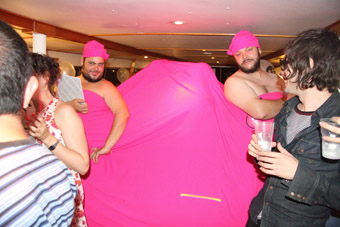
Julian Crotti, Chris Tamm Hard, Its Passing By Me (VIP ROOM), Willoh S. Weiland, Hard Party
photo Kathryn Barron
Julian Crotti, Chris Tamm Hard, Its Passing By Me (VIP ROOM), Willoh S. Weiland, Hard Party
ON JANUARY 15, A LARGE GROUP OF PEOPLE IN HIGH WAISTED JEANS, CHROMATIC TIGHTS AND EXCESSIVE EYE MAKE-UP GATHERED AT EAST CIRCULAR QUAY TO BOARD A BOAT. HYBRID PRACTITIONERS IN AN INTERDISCIPLINARY CONTEXT, EVERYONE RESEMBLED ONE ANOTHER SUFFICIENTLY SO THAT THE PASSENGERS COULD IDENTIFY EACH OTHER AMONGST THE PASSING TOURISTS ON THE CORSO WITHOUT EFFORT OR DOUBT. THEY MILLED AROUND SMOKING HAND-ROLLED CIGARETTES AND EXCHANGING FESTIVE GRIMACES, WAITING FOR THEIR SHIP TO COME IN.
The group in question was waiting for the Hard Party boat to dock. An exhibition on a boat and a “Harbour Cruise Party”, Hard Party was a three hour long irony-laced critique of how youth culture has become dominated by binge drinking, celebutards and meaningless glamour (note how important the placement of the inverted commas were to the meaning of that sentence, and how much it would have changed if they’d been placed around “boat” or “exhibition”).
The audience was free to roam the boat, mingle, dance to party anthems and fool around with a video juke box (a sort of video art parody of the endless video clips played in conventional night clubs). Post subverted wet t-shirt contests by holding a wet t-shirt contest, which I saw from behind, and involved a lot of endurance pogoing to orders given by the inimitable Zoe Coombs-Marr until the performers coughed blood all over their breasts. Brown Council stuck their heads in buckets of water every time the song “Take My Breath Away” played, in a sort of auto-erotic asphyxiation game, and looked correspondingly moist and refreshed. DAMP, a Melbourne based collective, wore rubber noses and talked amongst themselves. Every now and then, revellers received an anonymous SMS, like this one:
“Babe where are you? The DJ suck.. I just dropped my phone in the toilet!: Meet me in the sweat corner next to bar! Cum on!” 21:36
I don’t really know what a hybrid practitioner in an interdisciplinary context is any more than the next boatswain, but do you know what cognitive dissonance is? Cognitive dissonance is a psychological term that describes the state of mild discomfort caused by holding two contradictory ideas in one’s mind at the same time. It dates back to a classic 1959 experiment by psychologists Festinger and Carlsmith, in which three groups of voluntary test subjects were asked to perform an unutterably boring and tedious task, turning wooden pegs for an hour, and then requested to persuade a third party that what they had done was fascinating. The first group was paid nothing, the second group a dollar, and the third group twenty dollars. When asked to describe how they actually assessed the experiment, the second group was most likely to rate it positively. They’d been bribed, but with an amount so paltry that they’d been forced to internalise the lie they’d told, as they couldn’t reconcile their dishonesty with such small gain.
Full disclosure: I wrote a short essay for the Hard Party catalogue. That was my dollar. However I’d be lying if I pretended it was clear to me where the ‘irony’ stopped and the party started. That was clearly intended, but the problem that the event faced is that it couldn’t really succeed as a party without failing as a critique, not without some horrifying ship-of-fools climax in which the boat crashed into the pier. All the same, the crowd didn’t turn into the egregious drunken rabble the organisers might have feared or hoped for. That was chiefly due to the micro-economics of the situation. Most artsy types turn up to these sorts of events with less than $20 in cash (excluding tickets). Drinks were around $7 each, you couldn’t bring your own alcohol, and there was no ATM on the boat. Even the impeccably besuited Gilbert and George (Lucas Ihlein performing as George the Shit, and Mickie Quick playing Gilbert the Cunt, or vice versa), who were doing a reprise of the 1972 12-minute video “Gordon’s makes us Drunk” (for three hours), were only two sheets to the wind, as the ship’s purser had confiscated their 1 litre bottle of gin in the first half hour.
“I just saw somethin really full on I feel a bit sick, can we go now?” 22:28
Doubtless the best work of the night was Willoh S Weiland’s. Having cottoned on to the importance of exclusivity in maintaining glamour, she established a VIP room under extraordinary spatial constraints. The VIP tent consisted of a Leigh Bowery style confabulation of metres and metres of soft pink fabric held in shape by two huge burly gay genies. One of them was “security”, the other was “door bitch.” If one was lucky enough to get past “security” and could sweet talk “door bitch”, one was allowed to climb under the genie’s skirts into a synthetic womb, where the diminutive Weiland was eager to “do lines”, which consisted of repeating an arbitrary sentence, such as “there’s treasure in that sunken chest of yours”, over and over until it was perfect.
“i feel hot and heavy and everything. and weird. Do you know those kids who never made it through the party? xxxx” 23:22
Nothing much else happened. One of the members of DAMP, when I asked how they thought the night went, said that it was impossible to tell if it was good or bad because “Sydney is such a category error. Everything here is so wrong, there’s no point judging it.” Considering how lazy and boring their performance was, that just seemed like terrible manners. At least one drunken outlier who was actually wearing a cocktail dress had the audacity to confiscate Gilbert and George’s megaphone and boom at them, “You don’t even have any more gin. You guys are lame.” The ship came into dock. No one fell overboard, and the remnants of the exhibition drifted down to Jackson’s on George, a notoriously awful pub, for more ironic drinking. And that was it.
Hard Party, Artist interpretation of a party cruise, curator Lara Thoms, performers Brown Council, Post, Willoh S Weiland, DAMP, Teik Kim Pok, Tully Arnot, Hana Shimada, DJ V NRG, Lara Thoms, video jukebox Katarzyna Kozyra, Tara Marynowsky, artistas amistosos de neukölln, Corey Coda, Mathew Hopkins, Sally Rees, Rachel Scott, Emile Zile, TR Carter, Sue Dodd; Sydney Harbour, Jan 15
RealTime issue #89 Feb-March 2009 pg. 38
© Adam Jasper; for permission to reproduce apply to realtime@realtimearts.net
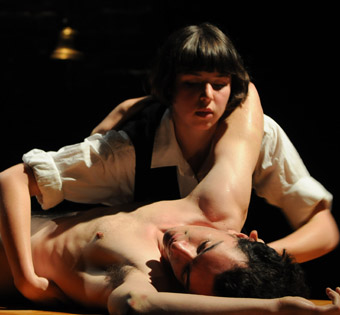
Sasha Cohen and Faustina Delany, The Three Minute Bacchae and other Extreme Acts
photo Heidrun Löhr
Sasha Cohen and Faustina Delany, The Three Minute Bacchae and other Extreme Acts
Each year, PACT Youth Theatre’s Impact Ensemble program provides eight months of regular weekly training and skills development sessions for young theatre makers. In the last three months the focus is on the development of a new work. Under the direction of Regina Heilmann, the 14 members of the 2008 ensemble created The Three Minute Bacchae and Other Extreme Acts. Drawing on motifs from Euripides’ tragedy The Bacchae, the performance is a poignant exploration of the nature of extreme acts and their impact on the everyday.
While we’re in the foyer, a young woman armed with a stopwatch delivers a three-minute synopsis of Euripides’ gruesome revenge story revolving around Dionysus, God of wine and inspirer of ritual madness and ecstasy. He cruelly punishes his cousin, King Pentheus, and his mother for not worshipping him. It’s an impressive feat of telling given the sprawling narrative and interminable lineup of characters. Once inside the theatre, the spirit of Dionysus is invoked by serving the audience wine. The performers engage in a series of everyday rituals of varying pace and duration—getting dressed, preparing a meal, chatting on the phone, brushing teeth, smoking a cigarette. These diligently executed actions seem controlled and considered but there is a sense of underlying threat, barely contained. There is a glimpse of it early on when a male performer drinking a longneck VB is suddenly grabbed and hosed down with water.
Firmly anchored in the here and now, a lot of the actions in the first half of the piece revolve around a ‘to do’ list written up on the wall, like a menu, with each task struck off once completed. Most of them have as their target a young man lying naked on a large wooden table, as if in a morgue. Yet references to The Bacchae are soon incorporated and proceedings take on a more pointedly theatrical tone. Short passages from the play are read and the line “I had a dream last night, mother; I dreamt I was decapitated” is transmuted into a song delivered by four chorus girls. It also becomes clear that the man on the table is Pentheus, victim of Dionysus’ revenge. Eventually the performers transform into a heaving mass of rolling bodies, gradually closing in on Pentheus, trapping him under the table. Fast, rhythmic hand drumming on the table is a prelude to the group turning into a violent mob. Pentheus is flung from side to side, and eventually lifted up and dropped to the floor. After a powerful, gospel-like chorale consisting principally of the line, “Oh savage truth, my son is dead”, Pentheus rises and, with a knowing look at the audience, lies back on the table as before.
Supported by a cleverly arranged soundtrack by James Brown and Emma Ramsay and sumptuous lighting by Frank Mainoo, The Three Minute Bacchae and Other Extreme Acts is a skilfully constructed, thought-provoking piece of contemporary performance. Heilmann’s direction is assured and sensitive, the ensemble perform with commitment and maturity.
The Three Minute Bacchae an other Extreme Acts, director Regina Heilmann, performers imPACT Ensemble 2008, sound design James Brown, Emma Ramsay, lighting design Frank Mainoo, dramaturgy Bryoni Trezise, scenic artist Robyn Higgins; PACT Theatre, Nov 19-Dec 7
RealTime issue #89 Feb-March 2009 pg. 38
© Martin del Amo; for permission to reproduce apply to realtime@realtimearts.net
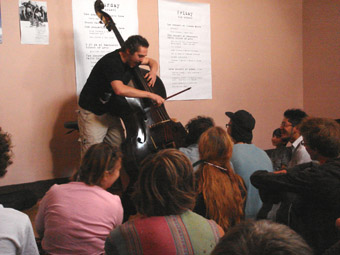
Mike Majkowski, the NOW now
photo Vivian Spadaro
Mike Majkowski, the NOW now
IN HOLLIS TAYLOR’S “THE MUSIC OF NATURE AND THE NATURE OF MUSIC”, A SATURDAY AFTERNOON LECTURE AT THE 2009 NOW NOW FESTIVAL, WE ARE INTRODUCED TO ZOÖMUSICOLOGY. USING EXAMPLES SUCH AS THE THEME AND VARIATION OF THE LYREBIRD, THE CUT AND PASTE OF THE PIED BUTCHER BIRD, OR THE SHIFTING PHRASING OF DINKY THE DINGO, TAYLOR QUESTIONS WHETHER ANIMALS ARE MAKING AESTHETIC CHOICES WHEN THEY SING. EDUCATIONAL AND ENTERTAINING, THE TALK FORMED THE PERFECT PREFACE TO THE NEXT 24 HOURS OF CURIOUS PERFORMANCES BY THAT STRANGE ANIMAL, THE IMPROVISING MUSICIAN.
The Saturday evening concert at Wentworth Falls School of Arts commenced with festival founders Clare Cooper and Clayton Thomas, on a brief return visit from Berlin, playing with Robin Fox and Martin Ng. Thomas leaps straight in, using his repetitive bowing technique to create a drone of harmonics, nicely matched by tumbling, crumbling static from Fox on laptop, while Ng manipulates his turntable producing pops, cracks and quick vinyl swipes. Cooper on guzheng provides a subtle, yet suturing layer, the timbre of her instrument intermingling with the bass but also mimicking electronic textures. The piece winds itself into a climax pushed on by high-pitched feedback coming from Ng holding his headphones to the stylus; and then it’s over. Thomas seems surprised…perhaps the improvisation might have gone somewhere else, but as it was, it was tidy and concise.
The next set featured Joe Derrick and Simon Ferenci on trumpets—a challenging combination for players and listeners. The musicians explore the possibilities of the instrument while trying to avoid playing too many notes: sustained breathy half rasps, the sound of clacking valves, various mutes and materials over the bell to vibrate and mutate, watery spittle sounds, scraping the brass. While both players are very thorough, the set never moves beyond a series of elements.
The extreme vocals grouping lived up to its title. Kusum Normoyle, Aaron Clarke, Rivka Schembri and Bonnie Hart all have their moments of screaming, the female banshee wails nicely tempered by the death metal bawls of Clarke. Normoyle alternates between screams and purrs, Schembri rocks on the floor out of sightline so it’s hard to attribute noises to her, but I suspect she is adding the more textural, animal sounds. Hart has a set of guitar effects pedals to augment her throaty utterances with feedback. The piece is interesting as a series of overlapping proclamations, but have they been trapped by being labelled as extreme? As with the trumpeters, I had a sense these artists in combination with other instruments might have produced more complex explorations.
Helmet Head is the audiovisual pairing of Anthony Magen and Rod Cooper. Cooper stands mid-stage wearing a white welding mask with a metallic frame attached—like a set of antlers—supporting a screen. Magen, in front of audience, uses an Elmo (a souped-up overhead projector) to create visuals displayed over Cooper’s head. The sound is played from tape, chopped up by manual fastforwards and reverses, with crunchy noises of curious origin. Magen places objects he has found around the area onto the Elmo—bubble wrap, a cauliflower, toys with lights—the extreme close-up and lighting shifts rendering all things alien. For many in the audience the directness of live visuals along with Cooper’s battle against gravity was enough, however I found the performance rushed and lacking trust in the materials—sonic and visual resonances were hinted at, but not quite achieved…though I’d like to see Helmet Head again.
Sandwiched between two hyperactive visual acts was the contemplative trio of Magda Mayas, Monika Brooks and Laura Altman. It’s very, very quiet, the overlapping of soughing and sighing from Brooks’ accordion and Altman’s clarinet creating a sustaining environment for the rattles and moans coaxed from the piano by Mayas, who without ego leads this concentrated exploration. This trio exemplifies what I find most interesting about improvised music: each musician equally in the moment, equally open to discovery, listening at the very deepest level and choosing their techniques in relation to each other, to create an absorbing, cohesive whole.
Originally from Brisbane, BOTBORG has been touring across Europe for a few years so it was great to finally see them in New South Wales. However the BORG has undergone a kind of mitosis, with one half—Scott Sinclair—remaining in Linz, while Joe Musgrove plays around Australia. Their early explorations were mesmerising as their cannibalistic process of audio feeding video feeding audio and round again created an aggressive cyberpsychedelia. The process has now been refined, Musgrove presenting a slick sculpting of synaethesic images and sounds: ever shifting horizontals and verticals eating each other to become voluptuous swirling patterns. The projections were on a side wall, both speakers on our left, and eventually the intensity of the process confounded the projector (or someone was sitting on the lead), but what we shared proved that BOTBORG have developed an enthralling audiovisual experience.
Then there was the late night gig at the artist run space Akemi a bit further into the mountains, where we all squashed into a big living room to watch an informative film about the Scratch Orchestra and experienced the wild country music of Eugene Chadbourne—quirky songs, weird instruments and playful extended improvisations by his supporting team of Monica Brooks, Clayton Thomas, Reuben Derrick and Neill Duncan (whose skiffle work on the washboard was amazing).
Sunday afternoon and no NOW now is complete without a performance by the Splinter Orchestra. With at least 20 players, individual elements rise and submerge again into the morass which is not so much murky as like a thick undergrowth of overlapping drones textured with scraping, grinding and jittering. There are no noticeable transitions yet somehow things change; the intensity waxes and wanes as subgroups slide in and out of consensus. There is an almost ending that a few extend into a coda illustrating that The Splinter Orchestra is a complex entity—it pursues a hive mind while allowing for individual provocation.
The Loop Orchestra (John Blades, Richard Fielding, Manny Gasparinatos, Hamish Mackenzie, Juke Wyatt) also played a rare gig. Using tape and video loops sampled from Blades’ electric wheelchair, the piece, titled Wheel to Wheel, is challenging in its relentless repetition, yet like good minimalism rewards the listener with subtle shifts that constantly recreate rhythmic structure.
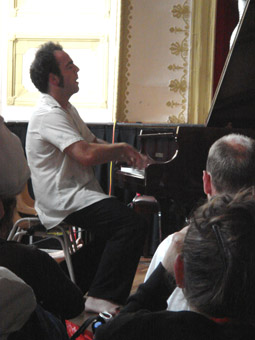
Anthony Pateras, the NOW now
photo Vivian Spadaro
Anthony Pateras, the NOW now
However the real highlights of the Sunday afternoon, and perhaps the festival, came from the solo performances of Anthony Pateras and Mike Majkoswki. Pateras is always good, but in this performance he was extraordinary. Closing his eyes, he adjusts the seat and jumps in, playing LOTS of notes. Emphatic and fearless, he starts at such a level of intensity we wonder where he can go from here. His fingers fly, he syncopates with his fist—energy not aggression—plays cascades of notes with his forearms that envelop the room until it is saturated with bouncing frequencies. Pateras knows his instrument and his own abilities and can shift pace, volume and tone, without losing any vibrancy or tension. It was literally awesome. He had to take two bows—unheard of in experimental music gigs!
When I first saw Mike Majkoswki play double bass in the early NOW now festivals I thought he was a shy young thing, however I couldn’t have been more mistaken. Majkowski is perhaps one of the most performative improvisers I’ve seen. A true showman, he sings along to the notes he is eeking out, whips the air with his bow, stamps his feet, dangerously thwacks the cap of a guy in the front row. It’s an angular approach of sudden shifts, sharp shocks and elegant sustains, constantly working the gesture. A bold, playful yet utterly serious exploration, Majkowski brought the concerts at the Wentworth Falls School of Arts to a perfect close.
The move to the Blue Mountains, initiated last year, suits the NOW now, giving it a slightly more casual and open atmosphere without any loss of rigour, and allowing for a greater engagement with environment and site, with activities like the early morning performances in Kings Cave and the interactive kites of Jon Rose. There is a truly festive feeling and audience numbers illustrated that there is also considerable local curiosity. Watching artists like Mike Majkowski develop through this scene indicate that the NOW now festival is providing a vital environment for these improvising creatures to grow and run free.
The NOW now festival, curators Jim Denley, Alex Masso, Mike Majkowski, Monica Brooks, Peter Farrar; Wentworth Falls School of Arts & Akemi, Jan 16-18
RealTime issue #89 Feb-March 2009 pg. 39
© Gail Priest; for permission to reproduce apply to realtime@realtimearts.net
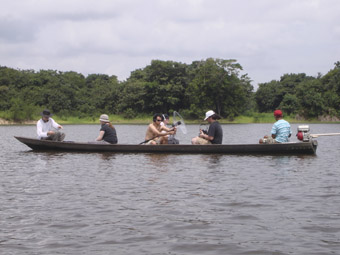
Mamori Art Lab
photo Lawrence English
Mamori Art Lab
THROUGHOUT WERNER HERZOG’S FITZCARRALDO AND AGUIRRE WRATH OF GOD, THE JUNGLE PLAYS A CENTRAL ROLE AS A PROTAGONIST OF THE HIGHEST ORDER. SHOT IN THE FURTHEST REACHES OF THE PERUVIAN AMAZON, EACH OF THE FILMS PLACES THE JUNGLE, BOTH ITS PHYSICAL AND SONIC CHARACTER, AS A FORCE TO BE RECKONED WITH, A POWERFUL AND OFTEN IMPENETRABLE WORLD THAT HIDES MORE THAN IT REVEALS.
As Herzog comments in the documentary Burden Of Dreams, the jungle is an all-encompassing world of the “prehistorical. It’s the only land where creation is unfinished yet…[a place that maintains] a harmony of collective murder. We have to become humble in front of this overwhelming misery and overwhelming fornication.” While typically Herzogian in its colour, this quotation does point to the drama that the Amazon jungle tends to draw out of people who encounter it.
Travel a good few days down from the headwaters of the Peruvian Amazon and you arrive at Manaus the capital of the Brazilian state of Amazonia where the confluence of Rio Negro and the Rio Solimoes takes place. It’s here field recordists, composers and sound artists from across the world gather for Mamori Art Lab.
Mamori Art Lab is a residency program overseen by Jordi Ilorella and Asier Gogortza, Spanish photographers whose preoccupations include the ways in which environments influence and ultimately shape art. Each year the pair collaborate with Spanish sound artist Francisco Lopez to produce two 14-day workshops that focus on the practice of field recording, concrete sound and other questions pertaining to the creation and exhibition of contemporary audio arts.
Field recording is a complex area of investigation that positions itself in histories of location recording, documentary filmmaking, bioacoustics and, as David Toop summarised it in Uovo Journal (Issue 14, 2007), “Bird watching and similar ocular pursuits, exotic sonic backgrounds, post Cageian environments.” The variations of the art form have expanded in recent years thanks to portable recording devices, leading to a mounting exploitation of natural sounds in a range of music and art practices. The intensifying mist clouding the art of field recording provokes questions as to why exactly this practice is undertaken—something strongly investigated by Francisco Lopez during the workshop.
The Art Lab’s physical presence is a collection of three small buildings on Mamori Lake, roughly four hours south-west of Manaus. The residency encourages discussion surrounding the creative use of found sound, provides opportunities for field recording excursions and participants are also encouraged to present works composed from recordings collected. It offers a chance for participants to engage deeply in one (albeit diverse) environment and explore a range of technical and theoretical ideas drawn from field recording practice.
For Melbourne based sound artist Camilla Hannan, among the residency group in 2009, “it was fantastic to be focused on the sonic environment for an extended period of time. Even when I wasn’t actually recording I was thinking about the sonic landscape, listening for different sounds, thinking about compositional structure and about how sound resides in space. Mamori offered a unique environment of sounds ranging from the cacophony of a thousand frogs to the delicacy of syncopated insects. At times, the ‘natural’ became truly bizarre.”
If one theme did permeate much of the residency it was the relationship between the natural and the synthetic—framed through Lopez’s insights into absolute concrete sound and the transformation of reality. Nights, dense with the high pitched clicks, whistles and sizzles of insects, bats, mammals and birds sounded like some highly orchestrated electro-acoustic composition. In fact if one aspect of Mamori’s sound world was to leave a lasting impression it was the sheer ‘weight’ of sound present—each square metre of jungle and swamp was loaded with countless sound emitters—making the location of individual elements quite difficult if not impossible.
Departing from the Mamori camp part-way through the residency for a three-day boat trip to the Lago Yuma, all participants were offered a chance to explore a range of new environments, including locations at which hydrophonic (and atmospheric) recordings of the Boto Rosa (the pink Amazonian dolphin mythologised as the shape shifter Encantado) could be made.
It’s difficult to convey the feeling of being in such articulate mammalian company, to hear these creatures communicating underwater and then gasping for breath as they emerge from the depths mere metres away from the small boats housing the participants. The intensity of engagement was unrelenting and brought into sharp focus a range of issues pertaining to the act of field recording and indeed listening. “Every minute (I was) hearing dolphins breathing loudly all around us,” recalls German artist Marc Behrens of the time on Yuma, “the sounds from the jungle further away and muted, the water surface completely still, no wind at all.”
As it came time for the final presentations to be made, each of the works told a story of impressions (and perhaps levels of connection) varying from participant to participant. For example, Behrens explored a concrete compositional approach using transformed sound against a backdrop of untreated field recordings. Cedric Maridet from Hong Kong took a more diarised approach, shifting between environments and illustrating the sheer diversity of sound collected. In contrast, Irish electronic composer Hillary Mullaney’s composition was a high-pitched oppressive drone that seemed to typify the harsher aspects of the environment—a work perhaps fuelled as much by her habitus as the jungle itself.
Leaving Mamori for Manaus at the conclusion of the residency was a surreal experience. Bodies were sore (following a harrowing soccer game with the locals; of course we lost, 10-4) and minds tired yet elated. It’s a difficult emotional jumble to summarise, one that reflected the rare chance for isolation from the modern world, as much as the sense of disconnection from any notion of ‘globalisation’—life had been extremely local and focused in a way that’s increasingly difficult to encounter.
Whether because of exhaustion, malaria medications and extreme environmental conditions, or simply the totality of experience itself, Mamori Art Lab provided a truly distinctive opportunity for collective understanding of explorations into sound art, field recording and the orbiting relationship of art and environment. The further the boat travelled from Mamori and the closer ‘civilisation’ became, the greater the yearning to return to that unique space and also the greater the dream-like quality of the entire residency.
Mamori Art Lab, November-December 2008, www.malab.net
RealTime issue #89 Feb-March 2009 pg. 40
© Lawrence English; for permission to reproduce apply to realtime@realtimearts.net
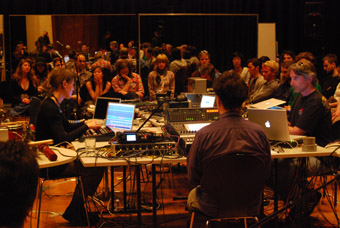
Tessa Elieff, Philip Samartzis, Interplay
photo Lenny
Tessa Elieff, Philip Samartzis, Interplay
INTERPLAY: LIVE SURROUND SOUND PERFORMANCES VIA COLLABORATION BETWEEN ACCLAIMED AND EMERGING ARTISTS WAS ORGANISED BY QUE NGUYEN OF THE ROYAL MELBOURNE INSTITUTE OF TECHNOLOGY STUDENT COLLECTIVE, WITHIN EARSHOT. THE EVENT CONSISTED OF FIVE PERFORMANCES FROM MEMBERS OF THE COLLECTIVE PAIRED WITH MORE ESTABLISHED MUSICIANS. THE STUDENTS WERE INVITED TO CHOOSE THEIR COLLABORATORS, GENERALLY RESULTING IN PAIRINGS WITH ARTISTS WITH WHOM THEIR OWN PRACTICE SHARED A GREAT DEAL.
Due to financial and time constraints (it was that time of year in universities after all) each pairing had limited opportunities to work together. Nevertheless the students and their counterparts undertook an informal mentorship process in preparing for the performances.
Cross-generational collaboration in Australia has been rare among musicians and sound artists. It is also reasonably uncommon to see more established artists in this area work consistently with younger artists. Interplay was an exciting and necessary step in attempting to further develop opportunities for young artists to work with, learn from and perhaps even influence their more established contemporaries.
Natasha Anderson and Que Nguyen opened the night. At the outset Nguyen had an interesting microphone setup with four positioned in a rectangle, each at a distance of a metre and a half. This allowed her to walk between them to effect panning of her vocals across the four speakers, while also processing her own voice with various effects from the now ubiquitous and quickly discernible Ableton Live software on her laptop. While visually fascinating this rendered the panning effect somewhat one dimensional and cumbersome, preventing Nguyen from being able to address all four speakers at once. Anderson meanwhile built on the signature staccato bursts of noise and low tones she coaxes from her contrabass recorder and laptop using a great deal of playback material, which she explained is sourced from the various theatre projects she has worked on in the last few years, lending the set a more dramatic turn than I had expected. Towards the end Nguyen took all four mics in hand and Anderson built an uncustomary crescendo which saw the sounds produced by the two begin to congeal and push toward a satisfying conclusion.
Philip Samartzis and Tessa Elieff performed the second set of the evening, both working with playback of various field recordings as well as various tones and, in the case of Samartzis, output from his EMS Synthi AKS Synthesizer, which the pair used to slowly fill the audible spectrum, starting with recordings of irregular rhythms which were gradually underpinned by bass notes and finally high frequency modulations. It was difficult to tell which sounds were coming from which performer, the palette of each overlapping to such a degree and providing an interesting ambiguity to their displaced concrete sounds. The various elements gradually extricated themselves and as the piece came to rest Samartzis looked up at Elieff with nothing but the recorded beep of a digital clock repeating alone until she hit stop, revealing their individual roles at the last possible moment.
The most successful set of the night was undoubtedly that of Darrin Verhagen and Martin Kay. It felt like a natural collaboration between two performers with a deep rapport and understanding of one another’s work. Strangely the set sounded much like the solo performances I have heard from Verhagen in recent times, gradually building to a violent crescendo from ambient beginnings. But it was in fact largely driven by Kay on laptop with the usually Pro Tools-bound Verhagen playing shakuhachi live with various processes and feedback setups, recalling his previous, more performative work such as Shinjuku Thief.
Robbie Avenaim and Nick van Cuylenburg were first up after the obligatory mid-evening breather and set out with an awkward beginning in which Avenaim waited to let van Cuylenburg set the tone for the set, producing grand granular sweeps from his computer. Eventually the two came together as the set began to build. Avenaim had positioned drums with his motorised drumsticks at either end of the room, seating himself opposite van Cuylenburg with more drums and devices. As the set developed van Cuylenburg produced a broadening range of percussive sounds which underscored the cacophony that developed as Avenaim activated all his various devices.
Closing the evening were Robin Fox and Vijay Thillaimuthu, performing on Max/MSP, oscilloscope and controllers and mixer, pedals and TV respectively with their individual setups linked into a recursive feedback network. Powerful and visceral, fully utilising the spatial potential of the surround setup at their disposal, the set started strongly but perhaps struggled to hold attention for its length. I was fascinated to see Fox’s processing of his collaborator’s output fold back on itself. The set forcefully demonstrated the possibilities for musicians of different generations to push one another in different directions.
It was clear throughout the evening that the younger artists did look to their more experienced collaborators for guidance and that deliberately transparent structures based around a central crescendo of some sort were the order of the night. This is to be expected with most first time collaborations when artists are sizing one another up and attempting to find common terrain. Overall the standard was very high and interestingly the most successful performances were the ones where the collaborations felt natural and the students pushed their mentors into new territories.
Interplay demonstrated the value of cross-generational projects in Australian experimental music and sound arts. It was clear that the opportunity to work with established musicians was invaluable to the students involved. Artists of different generations would clearly benefit from the opportunity to work with one another more regularly and hopefully more projects like this one will offer further opportunities in the future.
Interplay: Live Surround Sound Performances Via Collaboration Between Acclaimed and Emerging Sound Artists, Within Earshot Collective and Guests, supported by RMIT Union Arts, Horticultural Hall, Melbourne, Nov 9, 2008
RealTime issue #89 Feb-March 2009 pg. 41
© Ben Byrne; for permission to reproduce apply to realtime@realtimearts.net
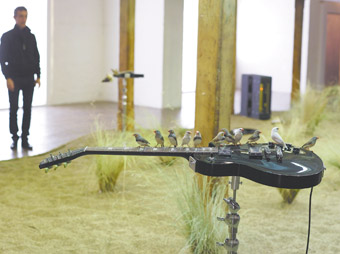
Céleste Boursier-Mougenot, From Here to Ear (2009), mixed media, Long Gallery, Hobart,
photo Peter Whyte, with thanks to Galerie Xippas, Paris
Céleste Boursier-Mougenot, From Here to Ear (2009), mixed media, Long Gallery, Hobart,
MONA FOMA ARRIVED QUICKLY IN HOBART, GESTATING AND HATCHING IN A VERY SHORT PERIOD. THERE WAS AN ODD MARKETING CAMPAIGN AND THEN IT WAS UPON US, ON THE STREET AND EVEN IN THE LETTERS COLUMN OF THE MERCURY, AS PEOPLE COMPLAINED AND PONTIFICATED ABOUT FUNDING AND TIMING. THE DAMN THING WAS EVERYWHERE.
MONA FOMA was something different. The convoluted acronym translates as: Museum of Old and New Art Festival of Music and Art. MONA is not yet open but when its mastermind David Walsh went public with the idea last year, the arts landscape in Tasmania changed dramatically—word spread of a collection of apparently incredible stuff in a unique museum that would be free for all to see.
Violent Femmes member Brian Ritchie emerged as festival curator, backed by the Salamanca Arts Centre. Suddenly an event was looming. The whole thing fell from the sky and Hobart was dazed and confused, which appeared to be the idea.
The festival opened with a huge free night-time show in Salamanca Place. Performances on a stage in a blocked off street, opera sketches by IHOS, aggressive, violent contemporary dance by Balletlab and a whole lot of art to see drew in a huge crowd. People voted with their feet, and given that it was all free (well, except for Nick Cave) that was easy to do.
The festival was fun and exciting and more than that, it felt like something we really need in Hobart—a big, bright, sprawling festival that isn’t about The Wilderness or Local Produce and doesn’t primarily feature nice music to have a pinot to. Instead we got art that wowed, charmed and seduced and the city loved it.
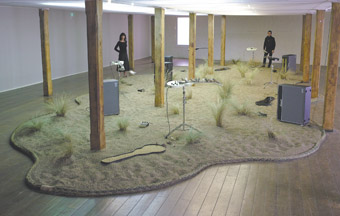
Céleste Boursier-Mougenot, From Here to Ear (2009), mixed media, Long Gallery, Hobart
photo Peter Whyte, with thanks to Galerie Xippas, Paris
Céleste Boursier-Mougenot, From Here to Ear (2009), mixed media, Long Gallery, Hobart
It was the content that did it. Hype and controversy made people curious but this would have backfired had the work not been so engaging, and exhibited so differently. The Roaming District Church, a mobile work by Jensen Tjhung, appeared and disappeared around the city. Its weatherboard exterior, polished interior and the calming psychedelic loops that oozed from the speakers evoked memory and a sense of time somehow; but if there’s something that music is truly about, then it probably is time—each beat and bar measures time passing. This thought became something of a theme for all the work for me. The little church was very evocative.
Time, again, was investigated by Manon De Boer’s short film Two Times 4’33”. Yes, it was the John Cage work and, yes, it’s about the other sounds that take place when a piano is not being played, and indeed the impossibility of silence. And we knew that, but the film took the ideas somewhere else by letting us watch the bars of no playing being read, and then for the second run through, a pan of the intent audience swiftly brought the experience back to oneself, sitting in a specially constructed screening room at the Tasmanian Museum and Art Gallery that had instructions for entry: not when the red light is on, thank you. Time and sound were pulled apart in very strict fashion.
The Long Gallery at the Salamanca Arts Centre was transformed entirely by the insertion of walls, headphones and a special room. The headphones contained a selection from the exciting 21:100:100 Sound Art exhibition from Gertrude Contemporary Art Spaces in Melbourne last year—by all accounts a truly thrilling exhibition, firmly stating the important place sound art has in Australia and the world (RT 88, p43). It’s such a wonderful installation—half the fun is watching people stoop and perch to listen, becoming monks for a moment.
In the Sidespace, just off the Long Gallery, Raef Sawford combined tiny screens on black plinths, an electronic rendition of Greensleeves and a fluttering projection around the darkened room into a work that wore time on its sleeve, entitled In Search of Lost Time. This work seemed to want to be larger and more all encompassing than allowed to be by the space, but the spread of darkness and its punctuation by differing use of light was neatly done.
Scot Cotterell’s work over in Kelly’s Garden, was a stark contrast, largely because it was rather funny. He combined black plastic, mirror balls, sludge metal sounds oozing from a 2001 style edifice and a joyously tasteless garden fountain spluttering Coca-Cola. The fountain was a lurid pink and the installation a monument to the awful glory of consumer crap everywhere.
Back in the Long Gallery there was a room within a room. Here was the centerpiece of MONA FOMA—From Here to Ear by Céleste Boursier-Mougenot. It featured 35 live zebra finches hopping about on cleverly tuned Les Paul guitars placed horizontally on stands for easy perching, scattered in an environment of sand and wild grasses. The guitars had amplification and even a little distortion, and as one moved about the room and the birds reacted, sound emerged. It was hypnotic and seductive to a high degree—this was the work Hobart really did fall in love with. People returned again and again to experience the fragile, beautiful creatures, colourful and fleeting like the perfect dream of a rock star. It was gorgeous.
The work that held me most, though, was outside: Cameron Robbins’ Marine Test Rig perched on the edge of the harbour. A little wooden cabinet containing pipes that stretched down into the river, it made sound as the motion of the water pushed air up into the cleverly constructed pipes. It hooted and blew with the imprecise rhythms of the sea, and it crept up on me-—what it was, how it worked and what it said about nature and time. The small music-making hut was all by itself, the sea playing it whether anyone was there or not. The motion of air and water came together and as my hair ruffled, I heard music that really was time and tide.
MONA FOMA Festival of Music and Art, curator Brian Ritchie, Museum of Old and New Art in conjunction with All Tomorrow’s Parties, Salamanca Arts Centre, Tasmanian Museum & Art Gallery, Hobart, Jan 9-12
RealTime issue #89 Feb-March 2009 pg. 42
© Andrew Harper; for permission to reproduce apply to realtime@realtimearts.net
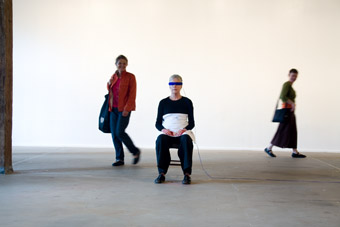
Joan Grounds, Artspace 24/25
photo courtesy Artspace
Joan Grounds, Artspace 24/25
ARTSPACE CELEBRATED ITS FIRST 25 YEARS WITH 24/25, A MARATHON WEEKEND-LONG PARTY OF INSTALLATION AND PERFORMANCES. OVER THE SATURDAY AND SUNDAY 24 ARTISTS WERE SHOWCASED IN A NON-STOP PROGRAM RUNNING CONCURRENTLY IN THE TWO MAIN GALLERIES. ARTISTS WERE GIVEN ONE HOUR EACH TO INSTALL, EXHIBIT/PERFORM AND TAKE DOWN. JOAN GROUNDS, WADE MARYNOWSKY, EUGENIA RASKOPOULOS, MARK TITMARSH, THE KINGPINS, KATTHY CAVALIERE, JULIAN DASPHER, JULIE RRAP, DENIS BEAUBOIS, LIZ DAY, MIKALA DWYER, MATTHYS GERBER, RICHARD DUNN, JIM ALLEN, BROOK ANDREW, DEEJ FABYC, GEORGE TILLIANAKIS, MARK BROWN, JILL SCOTT, NUHA SAAD, MIKE PARR, R E A AND DEREK KRECKLER PRESENTED A TRULY DIVERSE RANGE OF PRACTICES.
In the heady mix of full-hour performances, quieter installations and videos, the audience mingled or browsed the considerable Artspace collection of catalogue essays and press reviews which had been bound for the occasion. The mighty tome of essays from Nick Tsoutas’ long tenure as director was an impressive material remainder in itself, a reminder of the sheer number of artists and volume of work that has been produced or installed inside Artspace’s walls.
Representative of a quarter century of non-commercial art practice, the celebration more than aptly demonstrated Artspace’s committment to its mission to show conceptual/political work with little or no material remainder (nothing for sale). Twenty-five years on, Artspace, now directed by Blair French, is as vibrant as ever, a testament to the success of its mission and the collective worth of the work—ongoing and evolutionary in its exploration of issues, strategies, unlikely mediums and technologies. Initiatives such as Artspace have altered the perception of what constitutes art. Without it and other alternative venues, like Performance Space, would the Art Gallery of New South Wales have had its Level 2 program? Or MCA its strong local contingent? And would younger artist-run spaces like First Draft, itself now qualifying as a long-term establishment, have been viewed as necessary platforms for a tier of younger emergent artists?
Under Tsoutas’ direction, Artspace established a strong international agenda, with an important residency program, and a strong association with the Biennale of Sydney (housed upstairs in The Gunnery). Artspace nurtured and developed a style of practice which gave Australian artists the opportunity to rub shoulders with their international peers—and not just every two years at the Biennale. Tsoutas would seek out the weird and the wonderful, for example the handmade sci-fi of Finland’s Veli Grano, work you wouldn’t see elsewhere. His support for the gay community extended from Pope Alice to the music video generation of George Tillianakis and The Kingpins; and, equally important, through the catalogue essays he developed art writers and theoretical practice in an ongoing series of seminars and conferences.
Whatever your thoughts on the severe Marxist-revolutionary photocopy-styling of those Tsoutas-commissioned catalogues, the point was that he got them out quickly and economically with each and every show, and fostered serious artist-writer dialogues as assiduously as he collected reviews from the mainstream press. In those catalogue essays artists puts their work in dialogue with serious contemporary theory at an order of working through that was beyond mere review. The essays were a kind of conceptual testing ground for artists. Now, bound together, the essays are an invaluable research resource fittingly displayed in the foyer, central to the celebration.
Given the sheer volume of artists and projects, director Blair French is to be congratulated on succeeding in the difficult task of selecting a mix of established and younger artists to encompass both the gallery’s history and contemporary perspectives.
With a practice going back more than 30 years, Joan Grounds is a seminal figure in performance-installation in Australia. In her Sunday morning slot she was both performer and object in her own installation as she sat quietly, blindfolded by the skein of blue wool which wrapped her head, before trailing outside the gallery, along the footpath, and up a lampost where it secured a small, leafy branch. This tranquil, reflective work summed up a century of installation practice going all the way back to when Duchamp blocked access to a 19th century gallery by filling up the interstices between the paintings with a cat’s cradle of wool. The Duchamp mantra of “nothing to see” was echoed in Grounds’ blindfold: installation art is less about seeing per se and more to do with a conceptual understanding.
As such the historical dimension of this performance affirmed Artspace’s mission. Grounds’ exchange beween inside and outside, culture and nature, affirmed the history of happenings, the use of everyday materials (not the rarefied paint of high-born, sublimated ‘high art’), and the actions of artists whose site was very often the street (Gutai in white labcoats washing Tokyo’s pavements in the 1950s). In contemporary terms, Grounds’ performance ‘action’, though paradoxically calm, bound her to a tree and tall timbers, highlighting the sacrifice of nature to the city, and our blindness to its current state in the ongoing global warming and energy crisis.
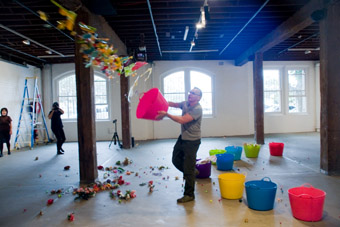
Mark Titmarsh, Artspace 24/2
photo courtesy Artspace
Mark Titmarsh, Artspace 24/2
Mark Titmarsh’s expanded painting likewise positioned Artspace in art history, playfully usurping the 1950s action painting of Jackson-the dripper-Pollock. With a diverse practice as both artist and writer (he co-edited the postmodern journal On the Beach in the 1980s), Titmarsh has a long history with Artspace and was an early experimenter in internet subjectivity (Space Invaders, 1992). Returning now to live action and to paint—not traditional painting, but painting in its expanded form as the lamella-thin surface of things—Titmarsh performed as a chucker of colour, flinging paint and all manner of bright and shiny baubles and multi-hued flat cards around the gallery. Colour dispersed in flight. Notably he later chaired the Artspace forum on expanded painting.
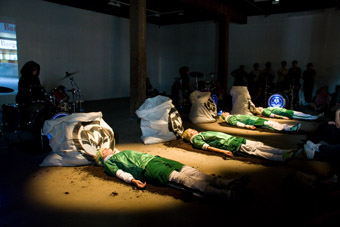
The Kingpins, Artspace 24/25
photo courtesy Artspace
The Kingpins, Artspace 24/25
Liz Day’s remarkably rapid installation of a square of riotous weeds in full bloom was contextualised by video documentation of her garden project inside a women’s prison. Her aberrant plants, like aberrant people, conjured the tensions between institutionalisation and freedom, bureaucracy and social formation of the self. Day, known for her slow practice of growing and exhibiting grasses and root systems within a conceptual frame of histories of power and colonisation (whitey’s patch of lawn eradicating Indigenous custodianship of the land), resorted to a shorthand of quite fantastical store-bought weeds to fit the one-hour timeframe.
For many established artists, the tight one hour of Artspace 24/25 was but time enough for a showbag sample of usual practice. Julie Rrap made time the focus when she set the heat to melt a line of ice stilettos (and in so doing recalled the iconic role of the shoe in her work on the female body and its fetishisation). Eugenia Raskopoulos’ dark and haunting video provoked the viewer to puzzle out what they were seeing (in synecdochal relation to her large scale 2007 Artspace installation where, inside a Mies van de Rohe styled glass box, she staged her smoke and red flares rebuke to Rumsfeld’s media lock-down on Gulf War Two).
Further samplings included Katthy Cavaliere’s discarded rag doll performance and Mikala Dwyer’s installation of an uncharacteristically non-floppy, rigid monotoned structure. Wade Marynowsky’s Dalek-inspired floor robots caught the mad flavour of his Artspace-installed masterwork, Autonomous Improv (which, in a nod to Bruce Nauman, combined video snippets of performance and sound artists with footage of the strangeness of clowns). The Kingpins donned their green tracksuits and inhabited their trademark boy rappers—live. Denis Beaubois showed a video of a soothsayer he had hired prior to the event to predict Artspace’s future and what would happen on the day.
Given the daunting, even impossible task of a full Artspace retrospective (simply too many good artists), Artspace 24/25 cannily consolidated its historical mission with a party offering a satisfying sampler of favourites.
Artspace 24/25, Sydney, Nov 1-2
RealTime issue #89 Feb-March 2009 pg. 43-44
© Ann Finnegan; for permission to reproduce apply to realtime@realtimearts.net
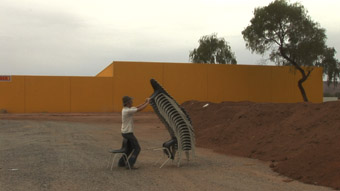
Alex Kershaw, One of Several Centres
VIDEO ART WAS ORIGINALLY CHAMPIONED FOR ITS DEMOCRATIC IMMEDIACY, WHICH ARTISTS JUXTAPOSED AGAINST THE COLD FORMALISM OF HIGH MODERNISM. EVEN TODAY, DIGITAL VIDEO TENDS TO BE MORE ABOUT CONTENT THAN FORM. LIKE AMATEUR NEWS FOOTAGE, THE IMPUTED REALISM AND BANAL YET OFTEN FORCEFUL MATERIALITY OF VIDEO CONTINUES TO UNDERPIN MUCH OF ITS POWER, EVEN AS DIGITALISATION ENABLES EVER GREATER DEGREES OF MEDIATION. THIS PLAYING OFF OF ‘REAL LIFE’ VERSUS ‘MEDIATED ARTIFICE’ ANIMATES ALEX KERSHAW’S INSTALLATION, ONE OF SEVERAL CENTRES, RECENTLY EXHIBITED AT THE FREMANTLE ARTS CENTRE, WHILE NOTEBOOK AT PICA BY THE UK’S JOHN WOOD AND PAUL HARRISON LIES FIRMLY IN THE REALM OF FABRICATED FORM.
Kershaw’s work, underpinned by vacant tones and marginally noisy field recordings mixed by Gail Priest, is a response to Australia’s mythic red centre. Filmed in and around Alice Springs, Kershaw presents a surprisingly urban vision. Indeed, as the title implies, there is a strange sense of decentredness to the installation. Kershaw’s sites seem eternally at the periphery, forgotten spaces nestled about a pleasingly rusted, semi-industrial circuit. We see, from inside, a local and her dog repeatedly circumnavigating an empty water tank; an all but deserted street roundabout being laid with rolls of grass; a Maori busker singled out against a concrete wall; an empty carpark behind a yellow warehouse (shades of Melbourne’s once neglected ‘Yellow Peril’ sculpture, Vault) wherein a young man, recalling Buster Keaton, noisily stacks cheap plastic chairs to a dangerous height; and even a darkened playground, illuminated by torchlight, as one man moves about its geodesic climbing frames. Like the field of yellow backing the carpark, the playground carries suggestions of Modernist failure, given that geodesic domes were proposed as utopian architectural forms.
At times, Kershaw’s vision recalls for me Agnès Varda’s Mur/Murs (Walls/Murmurs; 1980), notably where we see a figure carefully measuring a public mural. Both Varda and Kershaw worked with photography before shifting to moving images, and they share a liking for the locked-off, wide-frame shot, replayed with minimal sound, to effect both a re-enchantment of urban space as well as a wistful melancholy. These are fragile relationships between figure and surroundings, which might not survive beyond filming. The ordinary urbanity of these Alice Springs locals in their own environment gives the work the feeling of a poetic documentary, with extended viewing revealing a gentle artifice of framing, rhythm and space. Projection on two screens enhances this, giving a languid, minimalist flow to the work.
For all the subtle, slow moving delights of One Of Several Centres, Kershaw is not Varda, and his scenarios do not all match. The self-conscious, actorly performance of the chair-stacker and the rare use of a cut to an upper body close-up make this sequence jar with the others, which (as with the wanderer in the graffitied water tank) otherwise coil and stream more easily in their relaxed minimalism of editing, framing and performance. This is nevertheless a highly affective work for those with the patience to await its charms.
More striking is the installation by Wood and Harrison. The old joke about contemporary art—and in particular early video art documenting artists performing mundane tasks—was that it could be made by anyone. This is manifestly not the case with Notebook, whose visual precision (ironically) allies it with Modernism, Malevich, de Stijl, Bauhaus artists and their peers. Notebook consists of 101 shorts, each filmed in the artists’ crisp, white studio with featureless grey walls and evenly distributed light (largely from above). Most involve a perfectly rectangular, gleamingly blank table, and each starts with an initial pause or lull in which one has just enough time to evaluate the set-up. Then an event is triggered, in most cases with the artists (and even their hands) out of shot. Actions happen sometimes with a snap, but more frequently via a temporal arc in which the occurrence eases into realisation before a sharp conclusion. The camera then allows one to reflect on the consequences, before fading to black, and the next one-to-two minute event is played.
Humour—of the austerely blank type—hovers over these performances, spoofing in part the ideals of Modernist aesthetics. Painters such as Kandinsky and the French Cubist Gleizes often described their work as formalist experiments, as parascientific tests of what would happen if one related colour to shape according to a particular rule, or if one altered perceptual frames following precise principles. Wood and Harrison likewise relate a series of aesthetic and physical propositions. What happens if one drops a grid of uniform green apples, hung by fishing line, suddenly over the space defined by the tabletop? One is offered a rubber band affixed to the diagonal points edging the table and length of the band constrained about its rectangular margins, before it is released to define a dark line across the surface. This experiment becomes an aesthetic gesture akin to Mondrian’s lines and brushstrokes.
Drawing on both the history of performance art, and criticism about Pollock and Field Painting (their vast canvases as standing in for the artist’s body), the oeuvre of Wood and Harrison is animated by tensions around bodily absence and presence. This is highlighted by those rare pieces in which the artists themselves appear. I particularly enjoyed the sight of one, dressed in anonymous black, lying unemotional under the tabletop, before a shower of plaster from above scattered across its surface and onto the floor about him. Where the artists do not appear, objects and spaces are redolent of their displaced physicality.
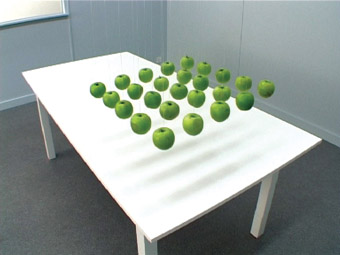
John Wood & Paul Harrison, Notebook
Notebook succeeds by its varied appeal. One can think deeply about its formalism, and its clear austerity gives it a look little video art attains. Or one can laugh at its comic physics lessons. Perhaps most importantly, this is not—to quote Adrian Martin—another “little black box [TV] inside the big white box” of the gallery, which insists one view it in the same way as one watches cinema or television. The visitor can enjoy the full duration of the 101 variations, or dip in and out, watch five minutes, leave, and return for another 30 seconds, and still appreciate this artwork—a welcome relief from the bloated durations artists such as Matthew Barney arrogantly demand. If only all video art was so crafted, yet unassuming.
For excerpts from Notebook and an interview with Harrison & Wood, see www.tate.org.uk/go/tateshots_issue12_harrisonwood.mp4 (This link will download the file, rather than taking you to a website.)
Alex Kershaw, One of Several Centres, 2-screen HD digital video & surround sound, concept, camera operation, editing Kershaw, sound designer Gail Priest; Fremantle Arts Centre, Nov 29, 2008–Jan 25, 2009; John Wood & Paul Harrison, Notebook, digital video; Perth Institute of Contemporary Art (PICA), Dec 3, 2008 –Feb 1, 2009
RealTime issue #89 Feb-March 2009 pg. 46
© Jonathan Marshall; for permission to reproduce apply to realtime@realtimearts.net
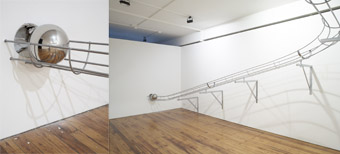
Busting Out, Kel Glaister
photos Christian Capurro, courtesy of Conical
Busting Out, Kel Glaister
AT MELBOURNE’S CONICAL INC., KEL GLAISTER INVITES US INTO A DE-CONSTRUCTION SITE THAT IS CLEAN AND BARE BUT FOR THE SLICK METAL RUNNER THAT CARRIES A GIANT BALL-BEARING TO ITS RESTING PLACE, EMBEDDED IN THE GALLERY WALL; WHILE ARLO MOUNTFORD OFFERS A COMFY SEAT AND FLUFFY WHITE ‘BEARSKINS’ AS THE SETTING FOR HIS QUIRKY FILM THAT FOLLOWS A RANDOM IDEA TO ITS LOGICAL CONCLUSION.
At face value, Mountford’s scenario is whimsical: a deer—well, a guy in an antler hat and ‘deer’ pants—wanders around the Victorian alps with a cuddly polar bear, discussing the making of art, until the two meet a real ‘Wanderer’, straight from C D Friedrich. They have a picnic in the snow, then wander some more. The work is the product of a filmed-but-forgotten late night conversation, which we see at the start of the piece: a drunken Mountford, inspired by a damaged neon sign that reads “—NDINAVIA”, paints a rambling verbal picture of a deer in a wintry forest, tossing snow with its antlers to the sounds of a massed chorus.
Mountford’s post-dubbed dialogue is a sardonic reflection on why an artwork is created and the inevitable compromises of its making. Artistic references abound—most markedly to Fischli and Weiss’s rat and bear films—as do self-referential loops of critique-within-critique. The cartoon-like bear seems to play the devil’s advocate, countering lofty statements with comments like “So you didn’t get funded.” (The deer replies, “Piss off.”) Mountford creates a clever, critical conversation about the artist’s pursuit of an idea: the culmination of this discussion is the ‘deer’ on his knees, ecstatically tossing snow, arching and turning in slow motion to a choir that sings ‘NDINAVIA’ over and over.
Return to Form: NDINAVIA seems to take the animated characters of Mountford’s previous works and bring them to life in the ‘real world.’ The mauve-tinted, snowy landscape is lush and alluring; and for all their absurdity, the hapless deer and cuddly bear padding through the wilderness are strangely appealing. As the rhetoric expounded by one so often falls comically flat against the banal response of the other, the theoretical weight that might otherwise alienate is lifted to another realm, one of sheer irony and playfulness.
The perfectly-drawn Wanderer in his cameo role gets the last laugh, in a sense, for the film’s sensual climax is a kind of sublime homage to all things Romantic; a triumph of ‘artistic vision’ that renders theory irrelevant. Beauty, in the end, reigns supreme and the artist stays true to his idea—even when the idea is an unremembered, drunken rant. Mountford’s film is completely engaging for its sheer oddness, and at the same time cleverly pulls off something both conceptually rich and visually seductive.
For Busting Out, a melting block of ice at the exhibition opening served to set Glaister’s ball rolling. Her elegant metal runner delivers it to its final destination, half-in, half-out of the gallery space it relies on for its existence. The work seems a streamlined version of the ideas that drove Glaister’s Immovable Object (2007, RT 80, p53). This time she uses polished steel rather than cinderblock, much as one might take up a well-tempered sword rather than a blunt club. The shiny, still sphere reflects the viewer, the room, the edges of the broken wall and the metal run itself. The space is empty and silent, but full of the imagined trace of the movement; the never-to-be-repeated gesture, the path of the ball through the gallery.
Far from Mountford’s directly tongue-in-cheek tone, Glaister’s installation appears to take itself seriously despite its claim to be “a bratty attempt to make itself defunct.” It is a deliberately futile effort: the wall itself is reinforced with steel plate so the ball can never in fact ‘bust out.’ The physical work is as sleek and sophisticated as the idea it articulates. The resulting hole is not random but perfectly round, an ‘embossing’ as much as a break—though this changed later in the exhibition’s run, when some gallery visitors mistakenly took the piece to be ‘interactive.’
Glaister’s piece is smoothly constrained, cool-headed, while Mountford’s film ultimately gives unashamed voice to the notion of beauty. But Glaister’s work has a seductive beauty nonetheless—where will her increasingly refined efforts lead in the future? Mountford seems indeed to be wandering in new territory, and it will be interesting to see what medium will be employed next in his exploration of the history of art and ideas.
Arlo Mountford, Return to Form: NDINAVIA; Kel Glaister, Busting Out, Conical Inc, Melbourne, Nov 8–29, 2008
RealTime issue #89 Feb-March 2009 pg.
© Urszula Dawkins; for permission to reproduce apply to realtime@realtimearts.net
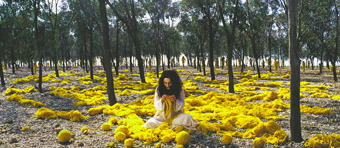
Mahdokht detail, Women Without Men Series (2004)
photo Larry Barns, Shirin Neshat, Courtesy Gladstone Gallery, New York
Mahdokht detail, Women Without Men Series (2004)
RECENT TALK OF PALESTINIAN “AGGRESSION” IN GAZA, AT A TIME WHEN HUNDREDS OF MEN, WOMEN AND CHILDREN WERE BEING SLAUGHTERED BY ISRAEL’S HIGHLY SOPHISTICATED MILITARY MACHINE, IS JUST THE LATEST EXAMPLE OF THE ONE-SIDED VIEW WE RECEIVE OF LIFE IN THE MIDDLE EAST. FOR DECADES THE WEST HAS POSITIONED ITSELF AS THE VICTIM OF ISLAM’S SUPPOSED ANTIPATHY TO DEMOCRACY, EVEN AS WE HELP STYMIE POPULAR MOVEMENTS THROUGHOUT THE MUSLIM WORLD. IN THIS CONTEXT, ARTISTIC VOICES FROM THE MIDDLE EAST PROVIDE AN IMPORTANT OPPORTUNITY TO SEE THESE CULTURES FROM THE OTHER SIDE. MIXING MAGIC, TRAGEDY, HISTORY AND POLITICS, THE FIVE-VIDEO SERIES WOMEN WITHOUT MEN BY US-BASED IRANIAN ARTIST SHIRIN NESHAT OFFERS A SHARP REJOINDER TO ONE-DIMENSIONAL IMAGES OF IRANIAN WOMEN AND THE NATION’S MODERN HISTORY.
Neshat’s videos are based on Shahrnush Parsipur’s 1989 magic-realist novel of the same name, set against the backdrop of the US and British-backed coup in 1953 that toppled the secular progressive Dr Mohammed Mossadegh after he nationalised the country’s oil reserves. It was partly her desire to explore this period that drew Neshat to the project. “I found I wanted to return to this historical moment and touch on how the American government had a direct relation to the overthrow of a democratic government, which eventually led to the deep resentment of Iranians against Americans, and indeed paved the road for the Islamic revolution. I had no interest in making a documentary film or an approach that would be a history lesson, but rather I found it interesting and a challenge to build these events as a background to my story.”
Each of Neshat’s videos portrays a female character from Parsipur’s novel, which traces the fate of five quite different women eventually brought together by chance in the city of Karaj, a short distance from Tehran. The videos vary greatly in approach, but none is strictly realist. “Parsipur’s style fit my work perfectly, as she is known for her surrealistic literature…all her work has one foot in society, history and politics, but is also profoundly timeless, philosophical and universal in expression,” enthuses Neshat. Described by the artist as one of Iran’s “foremost contemporary female writers”, Parsipur was imprisoned by both the Shah and the subsequent Islamic regime before fleeing Iran to live in exile in the US.
Neshat’s videos “give a glimpse into the nature of each woman” rather than extrapolating the plot of Parsipur’s novel. “I basically took each woman’s dilemma and tried to reveal her spiritual, psychological, social or sexual issues”, says the artist. “Since each woman’s problems and aspirations were different, I created totally different narratives and stylistic approaches.”
women without men
Mahdokht, the first video made back in 2004, is the most abstract in Neshat’s series. Playing out simultaneously across three screens, it explores the split desires and tormented nature of a young woman terrified by sexuality, yet obsessed with fertility and children. In the novel, the character resolves this contradiction by planting herself in a garden and becoming one with nature.
Although Mahdokht contains striking imagery—notably the crazed central character knitting in a forest strewn with yellow wool—the video is the least successful of the five. The thematic and narrative relationship to Parsipur’s novel is a little too elliptical, and the symbolism too wide open to interpretation. While the other works stand up as discrete viewing experiences, Mahdokht makes little sense without some prior knowledge of the character.
In contrast, Zarin (2005) is a striking horror movie exploring the psychology of a prostitute suffering from anorexia. She is so alienated from her work and her own body that her clients become blank, faceless monsters. In an unbearably visceral scene in a public bathhouse, the young woman attempts to erase her withered frame and sense of guilt through frenzied scrubbing, until she is reduced to chafed, bloodied mass.
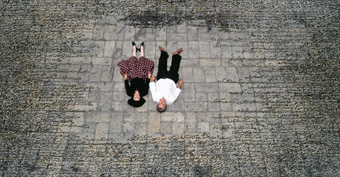
Munis, Women Without Men series 2008, Shirin Neshat
courtesy Gladstone Gallery, New York
Munis, Women Without Men series 2008, Shirin Neshat
Neshat’s final three videos were completed in 2008. Munis most successfully draws together the novel’s magic-realist style, the videos’ commentary on the lives of Iranian women and the historical backdrop of the 1953 coup. The central character is harangued by her conservative brother as she listens to radio broadcasts reporting unrest on the streets of Tehran. Unable to go outside and participate in the demonstrations, she anxiously paces the rooftop of her home. When she witnesses a fleeing protestor shot on the street below, Munis steps off the roof, engaging in a conversation with the man in their shared moment of death. The video beautifully weaves together her personal tale and the broader historical setting, in a quiet reflection on the frustrated possibilities of Iran’s shattered democracy.
Faezeh unfolds as a nightmare of brutality and ruined happiness. A young woman constantly returns to the scene of her own rape, an indictment of the impossible expectations placed on women to maintain their ‘purity’ in societies that often turn a blind eye to sexual violence.
In the final video in the series, Farokh Legha, Neshat adopts a more realist mode, and once again evokes the ’53 coup as a moment of curtailed possibilities. The middle-aged central character hosts a party in a grand house surrounded by an orchard—a symbol of life and fecundity in an otherwise barren landscape. The party is rudely interrupted by armed troops, some of whom sit down to enjoy a lavish meal while their counterparts hunt down and shoot ‘opponents’ outside.
Some time later, the host returns to her house, now deserted and coated in a thick layer of dust. Discovering a young woman lying prone in a garden pond, Farokh Legha takes her inside, where the girl flickers with life. As the camera slowly pans across the room, the cobwebs fade and flames dance in the fireplace once again. The final image seems to be one of hope, a sign that Iran’s culture, as well as the ideals of the nation’s short-lived democracy, live on despite the traumas we’ve witnessed.
book to video to film
While Farokh Legha marks the completion of the Women Without Men video series, Neshat is currently completing a feature film also based on Parsipur’s novel. Utilising the same actors and Moroccan locations as the videos, the artist says the feature will take a more narrative-driven approach that foregrounds the tale’s historical context.
Part of the attraction for Neshat of a two-stage project lay in exploring the mechanics of storytelling in two quite different environments. “I have been very interested in how the experience of viewing the story may change completely due to the setting—a theatre versus a gallery or museum space”, she explains. “So in my construction and editing of the videos and the film, I’ve tried to address this issue. Once I finish the feature it will be up to the audience to draw parallels and distinctions between art and cinema.”
In exploring Iran’s sexual politics and culture, as well as Western complicity in the crushing of Mossadegh’s government, Shirin Neshat has helped kick open the narrow window through which we typically view Iran in the West. Her videos stand as a provocative memorial to a crucial turning point in the nation’s modern history, and the women who have survived the vagaries of Iran’s political strife. The coming feature promises to be another intriguing thread in the tapestry of images Neshat has woven from and around Parsipur’s fantastical novel.
Women Without Men, video series, director Shirin Neshat, based on the novel by Shahrnush Parsipur; Faurschou gallery, 798 Art Zone, Beijing, China; Oct 25, 2008–March 1, 2009
RealTime issue #89 Feb-March 2009 pg. 17
© Dan Edwards; for permission to reproduce apply to realtime@realtimearts.net
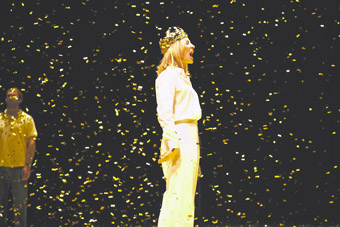
Cate Blanchett (Richard II), The War of the Roses, Sydney Theatre Company
photo Tania Kelley
Cate Blanchett (Richard II), The War of the Roses, Sydney Theatre Company
THE STANDOUT PRODUCTION OF THE 2009 SYDNEY FESTIVAL WAS THE SYDNEY THEATRE COMPANY’S THE WAR OF THE ROSES, A MAGNIFICENT CONFLUENCE OF VISION, SKILFUL EDITING, DIRECTION, ACTING AND DESIGN. IT WAS ALSO THE LAST PRODUCTION FROM THE STC ACTORS COMPANY (WITH GUESTS CATE BLANCHETT AND ROBERT MENZIES). WHAT FOLLOWS IS NOT A REVIEW SO MUCH AS AN EXTENDED APPRECIATION IN THE SPIRIT OF THE PRODUCTION, IN AN AGE IN WHICH REVIEWS (ONE OR TWO SIGNIFICANT BLOGGERS ASIDE) GROW SHORTER AND SHORTER AND THE CONVERSATION DIMINISHES.
act one: part one: richard ii
The stage heavens gently snow gold leaf over the court of Richard II (Cate Blanchett), a simple tableaux of seated king in elegant white slacks and shirt and modest golden crown, facing the audience; behind him an ordered array of courtiers and the lords-at-odds, Bolingbroke (Robert Menzies) and Mowbray (Steve Le Marquand), all in modern everyday dress, quite unglamorous, look out at us, expressionless. But the gold! It utterly fills the vastness of the undressed stage; it mesmerises; it engraves the scene in the mind; it undoes perspective; it suggests a paradise; it never stops.
Here is a king, firmly in control of rancorous subjects, demanding ceremony and obedience, and stillness. Some seven hours later, and several generations of English history on, it snows again over the same bare stage, this time dressed with the very real swings and roundabouts of a children’s playground, the domain of an utterly unceremonious Richard III—and this snow, now ash it seems, turns to deep slush around the bodies of the victims of civil war and its consequent tyrannies. This is the dark, descending arc of the Benedict Andrews-Tom Wright adaptation of eight of Shakespeare’s histories, a decline into the brutal genius of dumb tunnel vision that resonates (broadly here if not literally) with the Bush-Howard-Blair war on Iraq—our civil war, after all, on ourselves, our civil rights and consciences, where we become subjects again, instead of citizens. Pointedly, this production is titled The War of the Roses, the Wars of history reduced to one.
Between Richard II and Richard III of the House of York come the usurper Henry IV and his heirs, Henry V and VI of the House of Lancaster. Between the gold and the slush, there is civil war, war on France (and brief peace at home under Henry V) and then civil war again—bloody murder, here another form of ritual and play. In Henry VI, when the war begins in earnest, red liquid is swigged from plastic bottles and sprayed from the mouths of killers (a variation on the repeated insult of spitting) over their victims, followed by dusting with handfuls of flour. The true artist of this mortification is the soon-to-be Richard III (Pamela Rabe), casting spell-like clouds and arches of white around and over his victims. This Richard is a devious, malicious, loping child who, in the final act of The War of the Roses, chats with child performers in the playground: children witness to, even complicit in, his evil.
But the beginnings of this descent into disaster are already evident in the apparent paradise of Richard II, in another kind of childishness. Richard is kingly in manner but ultimately not in effect. By turns he appears distractedly interior, indifferent, flippant, callous and, worst, petulantly unpredictable. His sudden laughter is loud and inappropriate—as if mocking the passion of others or crudely covering for his possible complicity in the murder of the Duke of Gloucester. His elegance belies immaturity: impulsiveness and a failure to read his subjects lead to serious miscalculation. Instead of allowing Mowbray and Bolingbroke to resolve their quarrel in a chivalric joust he exiles both, but unequally—Mowbray for life, Bolingbroke for 10 years, then for six. On the death of John of Gaunt (John Gaden), Bolingbroke’s father, Richard is stupidly opportunistic, seizing all the old man’s property—Bolingbroke’s by right—and thus creating the grounds for insurrection that will see Bolingbroke become Henry IV and Richard dead—murdered by mistake or impulse, just as he had ruled.
Blanchett’s Richard is spellbinding. Still, authoritative, explosive, in control again, for the time being. We don’t witness the much reported, indolent gregariousness of the king: that is a given here in her detachment from the court with whom she resolutely refuses eye contact. Blanchett’s Richard is a loner at court, unlike, say, Fiona Shaw’s restless, fey Richard, directed by Deborah Warner for television in 1997, always in the arms of her courtier-hangers-on, passionately kissing her antagonists. Blanchett’s steely distancing and Andrews’ formal staging means we can believe in this king and be shocked when he errs. In this tautly edited version of the play, the focus is firmly on the personal trajectory of Richard from king to prisoner, a near tragic fall. So convinced of his right to be king, Richard cannot believe an insurrection is unfolding. But then the rain of gold, the golden reign, finishes abruptly, without ceremony: stage hands and actors with brooms and leaf-blowers drive the tiny, shiny rectangles into a deep pile at the back of the stage, an abject Richard in its midst. Fullness becomes extraordinary emptiness. When removed, Richard’s crown empties its accumulated, fallen gold. It is hollow indeed.
Soon Richard will surrender the crown to Bolingbroke, but it will be a deeply painful process, representing the push and pull between profound belief in his kingship, not just as divine right but as the core of his being, and emptiness, a doubting self. He demands his deposers understand what his giving up of the crown means. But this is the same man who failed to find compassion for Mowbray’s plea not to be separated from the language of his being—English; or the ageing Gaunt’s for the loss of a son he would never see again to exile (both speeches wonderfully delivered by Le Marquand and Gaden with passion constrained by the formality of the court).
In the end, Blanchett moves Richard beyond pathos, pushing him as close to tragic insight as possible as he struggles with an existential bind. When he calls for a mirror, he sees himself, not a king, smashes it to the floor and walks through the splintered fragments, littered, of course, with the last of the gold leaf. Blanchett fully realises the shock, anger and despair of a dislocated identity (“Thus play I in one prison many people,/ And none contented), a condition played to the very end with the requisite mix of ceremony (the surrender litany of “With my own tears…”), bitter irony (“I have a king here to be my flatterer”), self-awareness (“I find myself a traitor with the rest”) and too eloquent self pity. Blanchett give us all of this. Richard’s killer then empties gold leaf on him, like so much trash.
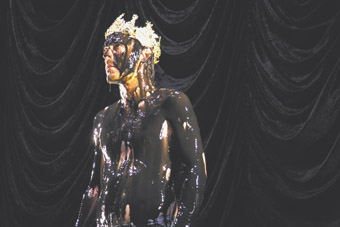
Ewen Leslie (Henry V), The War of the Roses, Sydney Theatre Company
photo Tania Kelley
Ewen Leslie (Henry V), The War of the Roses, Sydney Theatre Company
act one, part two: henry iv, henry v
The obdurate, aloof Henry IV is beset with, first, civil war which has prevented his planned atonement for deposing Richard—a pilgrimage to Jerusalem—and, second, a decadent son, Harry (Ewen Leslie) in the thrall of Falstaff (John Gaden). Henry appears to be ill, holds himself tight, almost stooped, as if, in Robert Menzies’ playing of the king, he is perpetually gripped by anger, disappointment and guilt—no mere bluff, pragmatic statesman but a wounded man who must push every word out into the world with effort.
Henry is still angered by the memory of “that skipping king”, Richard II, his undoing of the kingdom, and his son’s likelihood of doing the same. His lecture to Harry on how to play king is paralleled by a game that Harry plays with Falstaff, reversing roles of king and prince. Ironies abound: the bad father, Falstaff, has taught Hal (the older man’s name for the prince) much about people, in the way the king has not. Gaden seems at first an unlikely Falstaff, but just enough naked paunch, a flagon of malmsey, a blushing nose and broadened voice truly maketh the man. The relationship with Hal is very real, fluid, familiar, and momentarily if rather functionally sexual—Hal gives Falstaff a blow job, and dribbles the cum almost over the front row of the audience (already littered with gold). The sex seems almost incidental, but integral no less when we later witness Henry’s death struggle with Hotspur (Luke Mullins) and the courtship with Catherine of France (Mullins again, in falsetto).
For all his pragmatic wisdom about kingship, Henry IV fails, like Richard II, to see what is before him, thinking the chivalric Hotspur a better ‘son’ than his own. He does not recognise Mullins’ lithe, eager, feckless Hotspur as a challenge to the throne. Harry will, unnoticed, kill Hotspur, saving his father in a strange tussle (like bears wrestling on hind legs, with a convulsive, sexual shuddering). The kill is then claimed by Falstaff, and Hal lets that pass. not yet ready to reject the man.
As in Richard II, the editorial focus closes in on duets: here it’s Prince Henry and Henry IV at odds and in conciliation; Hal and Falstaff at play; Harry and Hotspur in battle. The deathbed exchange between the dying Henry and the prince is particularly affecting with its errors and accidents of judgment and perception. Harry, thinking his father dead, takes the crown; the waking Henry accuses him of virtual patricide. However, an underlying warmth between the two struggles to the surface in this finely played scene. They become one and the succession is guaranteed, by inheritance if not divine right and Harry’s promise of personal reform. Finally, there’s the rejection of Falstaff: Hal, now King Henry V, adds to the pain by spitting on the old man. These intense duets are interspersed with the brutal horrors of rebellion, antecedents to the protracted war in Henry VI.
There is another duet, unspoken, unacknowledged and principally between the king and a musician. Henry IV is given the sparest of stagings: an undressed stage and on it a lone, young electric guitarist (Stefan Gregory) with amplifier and foot pedals faces away from us and plays a long, raw solo we can’t ignore but which does not mess with the words. It grows in complexity and thickening harmonies, becoming beautiful, an eloquent dirge for the sad life of a guilty, disappointed king who bequeaths just enough stability for his son to succeed.
Ewen Leslie’s Prince/Harry/Hal is one of the remarkable character creations in The War of the Roses, a boy-man visibly crippled by his decadence—the hint of a limp, twitching when tense, a cough—but with an ennabling common touch, wit and the capacity to listen. He learns to play king, drawing from the lessons of both his fathers, Henry and Falstaff, without duplicating their weaknesses, if carrying within pain and doubt.
In Henry V that sense of woundedness we saw in Harry is sustained in a radical account of the play in which an ornate rust-red curtain is lowered downstage. There the play’s Chorus prefaces each of a series of solo speeches by the king. Henry performs without grand eloquence or heroics; there is no crowd, no army, just us, whom he addresses with a quiet, heartfelt intensity. First he appears covered in honey and glitter; then, as he invades France and his troops fall prey to bad weather and illness, he is coated in black oil; then as battle and victory ensue he is drenched in thick red blood. As with the falling gold in Richard II, a single, sculptural device in Henry V, a series of still, painted bodies of one man against a stage curtain (for that metatheatrical, most-chorused, pageant of a play) rivets our attention to a man playing the role of king with the utmost determination while something deeper, unspeakable within, quivers. The curtain rises, he is slowly washed clean for his courting of Katherine of France.
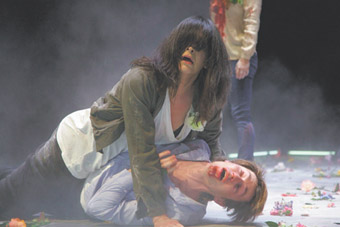
Pamela Rabe (the soon-to-be Richard III in Henry VI), Luke Mullins, The War of the Roses, Sydney Theatre Company
photo Tania Kelley
Pamela Rabe (the soon-to-be Richard III in Henry VI), Luke Mullins, The War of the Roses, Sydney Theatre Company
part two: act one: henry vi
If in Richard II and Henry IV, Andrews and Wright fix closely on their kings and the immediate dynamics of intimate if difficult relationships, and let those flow on to underscore Henry V’s solo turn, the challenge of Henry VI is quite something else. This act draws on three of Shakespeare’s plays in which the king, Henry VI, figures relatively little (the actual Henry became king at nine months, suffered mental collapses in the course of his 50 years, was sometime ruled by his warlike wife, Margaret of Anjou, founded colleges, including Eton, was in and out of power and finally murdered). But here he is central to the realisation of this part of The War of the Roses. It’s as if we witness the decline into civil war through his eyes and, sometimes, ears. It’s a reminder, too that Shakespeare would have known that the real king was found alone, distracted and unattended at the end of two major battles. Here, Henry wanders the battlefield seeing a father who has unknowingly killed a son, and vice versa—here the reversal is played by the same performers, adding to the sense of Henry’s, and increasingly our own, delirium.
This Henry VI is an autistic youth in a garden—a rectangle bordered by floor level fluorescent light tubes and awash with cut roses of many colours. It is here that the dispute between the Houses of York (white rose) and Lancaster (red rose) becomes full-blown and murders soon escalate into a rapid series signalled by digital readout suspended over the stage (“The Killing of York” etc). Thus three long plays become one briskly told tale about a tottering, giggly Lancastrian king, who suffers fits. His power is in the hands of the Duke of Suffolk (Steve le Marquand) who chooses for the king a wife, Margaret of Anjou (Marta Dusseldorp). She and Suffolk mate like playful dogs. Then Henry finds himself governed on the one hand by his wife and on the other by the Protector, the ambitious Duke of York (John Gaden), whose sons include the future Richard III. Tensions in the court mount, but they are beyond Henry, and us with him. In one passage, composer Max Lyandvert’s score calculatedly drowns out everyone’s words, as if Henry is lost in iPod land. He slips in and out of awareness, laughing when Suffolk is murdered, alert to the tell-tale extremity of Margaret’s grieving, amused when his brattish cousins buffet and kiss him in act of false fealty.
Henry’s world is increasingly a nightmare: the blood spray murders multiply, cruelties abound (York’s infamous offering of a napkin to damp tears when the very cloth is stained with the blood of his victim’s beloved); York’s sons play with bodies; roses are stacked high, like the gold become rubbish in Richard II. A cycle of vengeance spirals out of control, victims and murderers rise up to repeat themselves; a half dozen Margarets of various ages and genders appear across the stage; her son Edward is murdered by the soon-to-be Richard III. She washes Edward, as he stands before her (as the dead do here) but with blood, which will never clean the horror she too has unleashed. Richard murders Henry in a cruel disabling, severing the neck from behind. The last Lancastrian king is dead, Edward IV of York rules, the war is, in a way, over. Now Richard will eliminate members of his own family.
Amidst the horrors of the war, Henry VI remains a simple figure, Eden Falk affectingly conveying the varying degrees of innocence, detachment, horror and guilt (that he might be a cause of all this), with the body language of an undeveloped child. Gaden’s Duke of York is frightening in his growing resolution, Marta Dusseldorp is a relentless then distressed Margaret, Pamela Rabe emerges from the shadows as Richard, just another one of the boys, but much more dangerous.
part two, act 2: richard iii
The grim, wintry playground of Richard III is peopled with children, idle ghosts and those soon to be added to the dead as Richard play-acts and murders his way to the throne. Pamela Rabe’s idiosyncratic Richard is a lumbering adolescent attired in baggy clothing that obscures his hump while a mass of hair frequently hides his face if not his perpetual amusement. Rather than sharing his self-justifications and strategies principally with us, his confidantes, he spreads them about amiably, offering them to his playground fellows. He plays a game of murder with one child; both are delighted to have fooled us.
Richard is persuasive in his seduction of Anne (her dead husband, Edward IV, Richard’s victim, lies nearby buried in ash) but without ever losing his casual boyishness. Blanchett responds with the requisite anger but then a sense of astonishment that this could be happening, followed by grim acceptance, as if it is best to play along. Soon, true to the stark realism of this rendering of Richard III (no spraying of blood here), she hangs herself from the swing.
This Richard is greedy not just for power and the fun of the chase, but for food, tearing into a chicken with his fingers while planning his worst. Deceptively casual and slow, he soon moves dangerously fast. He springs into a cock-like strut (“I am not in the giving vein”) when turning on his partner-in-play-and-crime, Buckingham who is astonished at the sudden escalation of events—the murder of the princes in the Tower. Richard’s end is likewise near as Henry Tudor (a descendant of the House of Lancaster’s John of Gaunt) and army approach. Richard III’s state of mind at the end, like Richard II’s, is complex, here a momentary but deeply felt oscillation into fear and self-pity before a re-assertion of will. Defeated in battle, fallen, he slowly reaches out to Henry Tudor, offering the crown in what looks deliciously like a mocking invocation of Richard II surrendering the very same crown to Bollingbrook. Has the war finished, or another usurper of the same house taken the throne? At the end of The War of the Roses, a child stares out at us from an ashen landscape, the instruments of play draped in funereal black. A war has made malicious children of men and women and, true to Shakespeare’s vision, revealed the sheer fragility of sovereignty.
The Richard III with which Rabe, Andrews and Wright intrigue and fascinate us comes as a very real surprise after generations of rather like-bodied and minded villains. This murderous child may test the already limited but critical empathy that we feel for Richard at the end, but as the final part of a trajectory of increasing childishness from Richard II’s immaturity on, through Henry V’s delinquent youth, Henry VI’s naivety and York’s murderous sons, this Richard is an apt creation, not least because in our world children, willing or not, have increasingly become warriors. There’s also much of the victim child in Richard’s rationalisations. For all his assertiveness and defiance he sees himself as cheated, deformed by nature and by witchcraft and has turned this anger out on to the world with all the rational cunning of a psychotic. But, as with the other kings in The War of the Roses, we glimpse in this man disturbing moments of insight and complexity, the warring elements of the un-singular self.
whose world?
To achieve their vision of a kingdom’s inexorable decline into civil war, to present Shakespeare’s disparate body of history plays as one and to focus principally on the men who wore the crown (and only their immediate allies and antagonists) has meant Andrews and Wright have had to reduce the vast world of these plays (some 30 hours of stage time if you did them all), sweeping aside bishops, whores, taverners, mayors, mercenaries, ambassadors, popular rebels and petty criminals, and Joan of Arc, all part of the great canvas of Shakepseare’s innovation. It’s a large price to pay, but a small one too for the great achievements of The War of the Roses—the rigour and persistence of its vision across near eight hours, the sheer power of its ensemble playing (sadly, the last of the Actors Company productions) and the memorable, virtuosic and emotionally complex performances from Cate Blanchett, John Gaden, Ewen Leslie, Pamela Rabe, Robert Menzies and others. The descent into death of a kingdom and its people, so emblematic of The War of the Roses, resonates acutely with today’s states of war. It is brilliantly counterpointed with the production’s fidelity to Shakespeare’s skill in evoking psychological complexity and testing an audience’s capacity for empathy for these flawed kings and their families.
Sydney Theatre Company, The Actors Company, The War of the Roses, William Shakespeare, adapted by Benedict Andrews, Tom Wright, director Benedict Andrews, performers Narek Armaganian, Cate Blanchett, Brandon Burke, Peter Carroll, Marta Dusseldorp, Eden Falk, Holly Fraser, John Gaden, Louis Hunter, Michael Kilbane, Ewen Leslie, Steve Le Marquand, Haley McElhinney, Amber McMahon, Robert Menzies, Pamela Rabe, Emily Rusell, Billy Shaw-Voysey, Leo Shaw Voysey, set designer Robert Cousins, costumes Alice Babidge, lighting Nick Schlieper, music & sound design Max Lyandvert (Act 2, Part 1), musician and original music Stefan Gregory, Sydney Theatre, Jan 9-Feb 14; Perth International Arts Festival, Feb 27-March 12; www.perthfestival.com.au/theatre/waroftheroses
RealTime issue #89 Feb-March 2009 pg. 4-5
© Keith Gallasch; for permission to reproduce apply to realtime@realtimearts.net
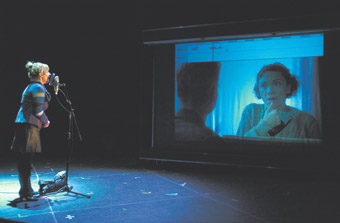
Frederike Bedard, Lipsynch, Ex Machina
photo Erick Labbé
Frederike Bedard, Lipsynch, Ex Machina
ALTHOUGH THE GLOBAL ECONOMY WAS IN STEEP DOWNTURN AND THE SYDNEY FESTIVAL WAS FEELING SOME OF THE CRUNCH, THERE WAS STILL MASS DANCING IN THE STREETS, LED BY GARRY STEWART, THE FONDUE SET AND OTHERS IN THE CITY ON THE OPENING NIGHT. WHEN WE ARRIVED AT THE HUMBLE ABRAHAM MOTT HALL IN THE ROCKS WE FOUND THE CO-DIRECTORS OF NEW YORK’S NATURE THEATRE OF OKLAHOMA MAKING US WHITE BREAD SANDWICHES—CHOICE OF PEANUT BUTTER AND JELLY OR HAM AND CHEESE WITH MAYONNAISE OR MUSTARD—AND THROWING IN A CAN OF DIET COKE OR A DR PEPPER. THESE WERE INCLUDED IN THE TICKET PRICE, BUT THERE WAS FOR A MOMENT A HINT OF THE BREADLINE, ACCENTUATED BY NATURE THEATRE’S LOW, LOW BUDGET FOUR-HOUR PRODUCTION, NO DICE, PERFORMED IN ALMOST OVERWHELMING, HUMID SUMMER HEAT. HERE WAS A SHOW THAT, UNLIKE CHRISTOPHER WHEELDON’S STRAITJACKETED MORPHOSES BALLETS, REALLY DANCED, IN WORD AND BODY.
Although No Dice yielded exhilarations and profundities that could not be approached by Lipsynch, the nine-hour Robert Lepage production also danced when it was not locked into an increasingly silly melodrama or hamstrung by superfluous effects. The complexly integrated set, operated by a huge team of visible stage hands and technicians, turned itself inside out and rotated in a waltz of overlapping lives and cultures, homes, hospitals and sound and film studios. Best of all was Lipsynch’s attention to sound and listening—the match, or not, between voice and body, the mismatch between seeing and hearing, the aural trickery of filmmaking, the loss of voice to a tumour and its recovery through song, and much, much more. In one scene we witness a female employee dealing with night-time customers in a bookshop. We see her though the window; we can’t hear what is said. We know she’s recently been released from psychiatric care. Outside the shop we see the two ghosts that haunt her, demanding her attention. She seems to ignore them, but we wonder if she is coping at all well with her customers. The set turns and we watch the whole scene again, hearing what is said. We wait anxiously for the ghosts to appear. They don’t. And what we hear contradicts all our expectations and projections. Here is a woman on the way to recovery, returning to engagement, listening and poetry. If only Lepage had applied this approach to his Dickensian plotting, where creaking predictability and deterministic Roman Catholicism make a saint of a Nicaraguan victim of the sex slave trade, but never a real person, always a cipher. Whereas the sonic world of Lipsynch floats and fascinates in tandem with the perspectives offered by the mutating set, Lepage nails his narrative to the stage floor.
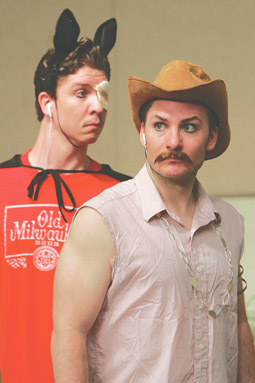
Zachary Oberzan, Jarid Rychtarik, No Dice, Nature Theater of Oklahoma
photo Prudence Upton
Zachary Oberzan, Jarid Rychtarik, No Dice, Nature Theater of Oklahoma
In No Dice, there was dancing towards the end of each of the two acts. It was inexplicable, but bracing, wild yet choreographed and as idiosyncratic as the rest of this remarkable show—as if a release from the incredible labour of human conversation we’d been witnessing. The Nature Theatre of Oklahama performs recorded conversations. Roslyn Oades directs similar work for Urban Theatre Projects but in a different way, resulting in a lyrical, revealing naturalism (p36). Nature Theatre does quite the opposite. The No Dice performers hear edited telephone conversations on their in synch iPods and deliver them according to a set of rules, which include a fixed number of strange gestures (sourced from a magician, disco dancing and blocking clichés from the stage and soap opera) as well as a range of accents. The pacing of the speech is slow and hyper-emphatic, the volume is high, the rhythm heavily accented, allowing for an aural slow motion analysis of conversational patterns and personality traits. Utterly shorn of context, apparently banal conversations about work (whether in call centres or in the theatre), family and the best performance of Hamlet (Mel Gibson; the others “made Hamlet look like a sissy”) become very funny but also assume a surreal gravitas—they seem crazy but deeply meaningful as we grow adept at listening and decoding. Conversational tropes recur, whole passages are repeated with roles reversed and accents dropped. But at all times the bespectacled Hasidic pirate, the New York, moustachioed cowboy and the sparky, fishnet-stockinged showgirl (and their Batboy hip-hopper-cum-sound artist, a lean keyboardist and the two guest-spotting directors) perform everyday talk as if every word is of the utmost importance. And so it is. In a late reversal, the hyperreal formula is dropped, the stage darkened, and the projected transcript of one of the conversations we’ve heard scrolls down. We hear it as well, at normal conversational pace. The key speaker turns out to be female, not male after all, and is the mother of one of the performers talking to the show’s male director. She’s idiosyncratic, quick and droll. She talks about dancing in a wheelchair. We’re now hyper-attentive, curiously moved. And then the company dances (“…dance will solve all the world’s problems”) and we celebrate as one.
The Belarus Free Theatre (see David Williams’ interview/review on page 9) in Being Harold Pinter also made us listen, and read very fast as the surtitles rattled by. Fragments from Pinter plays, from early works to late, took us from threatening moments in everyday life to the overt threats, tortures and murders of totalitarian states. What we heard was Pinter’s text delivered at breakneck pace, largely bereft of classic pauses, but when they did occur it was at great length, opening up chasms of anxiety and pure fear. What we saw was reminiscent of western radical theatre of the 60s and 70s: stark symbolism built from deployment of simple props and neatly choreographed correlatives to the text, here performed with subtlety and passion.
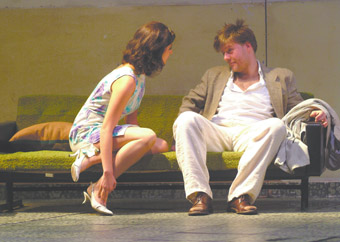
Krno Fekete, Adel Jordan, Ivanov, Katona Jozsef Theatre
photo Kata Schiller
Krno Fekete, Adel Jordan, Ivanov, Katona Jozsef Theatre
Reading the surtitles in the Katona Josef Theatre’s Ivanov was more leisurely and the unintelligible Hungarian a musical delight. This early Chekhov proved to be the festival sleeper (No Dice, on the other hand, was sold out almost as soon as bookings opened), a totally engaging, faithful account of the work. It too danced. The opening solos and duets involving Ivanov, his chair and the comings and goings of visitors are preludes to other intimate patternings and larger scale social events involving the 22-strong ensemble. Director Tamas Ascher deploys his actors with the eye of a film director, constantly shifting our perspective within the frame. The 1960s setting is a run-down building, doubling as Ivanov’s bankrupt farm and the local club, in the declining Soviet Republic of Hungary. So it’s not surprising that the production is reminiscent of films of the period, not least those of the Czech director Milos Forman. Every character, however minor, is closely observed, a touch eccentric and living in a bitter world eased by wonderful comedy, sometimes verging on slapstick, but always rooted in the absurdities of appalling local prejudices, a failing social system and personal weaknesses. The transposition of the play from late Czarist Russia to 60s Hungary works perfectly, and there’s much in Ivanov about racism, the destruction of nature, the challenges of rural life and the enduring agonies of love and indecision that seem utterly contemporary. What impressed about Ivanov were the unforced historical transposition, superb ensemble playing and rivetting principal players. It was above all a production faithful to the play but with the provocative visual and choreographic sensibility of 21st century performance and, at the same time, a disarming intimacy.
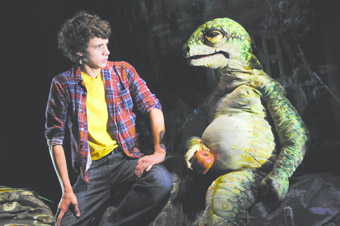
Tom Green & the Potkoorok, The Nargun and the Stars, Erth
photo Heidrun Löhr
Tom Green & the Potkoorok, The Nargun and the Stars, Erth
Erth’s The Nargun and the Stars, an adaptation of the famous Australian novel for children, also danced. Simon discovers spirit creatures in the bush around his cousins’ farm where he has been sent after his parents’ death in a car crash. There he encounters the spirit life of the local environment realised here as magical creatures: the monkey-ish Turongs, the boy’s lizardy confidante, Potkoorok, the cute fruitbat-like Nyols and the massive, stage-filling Nargun, a rock monster attracted out of its territory by its first sight of the stars. The Nargun is troubling the local spirit ecology while developers ruin the natural one. The puppeteering of Bryony Anderson’s wonderful creations is a delight, especially for the Nyols, flying in precise formation, settling on Simon, shaping his movements into comic dance. I subsequently learned that a number of the puppeteers have dance backgrounds. It shows.
The setting is realised virtually in Sam James’ projections of farm house, forests, cave, night sky and rain, and physically in Steve Howarth’s design, which includes a rock pool, a huge grader and tall inflatable trees. The two layers of design, aided by Bernie Tan’s necessarily discreet lighting, merge beautifully, allowing actors, puppets and images to magically live as one, not least in an underwater swimming scene. James’ images are multi-layered, rich in detail, animated and provide exciting shifts in perspective and depth of field. The performances are good, the puppeteering and the multimedia design are exceptional and the lucid direction by Wesley Enoch and Erth’s Scott Wright of Verity Laughton’s adaptation yields laughter, anxiety and surprise. While Wrightson’s tale was progressive for the 1970s and still has many strengths, its fictional imagining of an Aboriginal spirit world now seems culturally awkward (this is compounded by the voice-over narration). But that’s the challenge that comes with realising any classic in performance and, to their credit, the collaborators largely override these concerns with a vividly memorable creation.
Ex Machina, Lipsynch, director Robert Lepage, text Lepage, performers & dramaturg Marie Gignac, set Jean Hazel, lighting Etienne Boucher, sound Jean-Sebastien Cote, Theatre Royal, Jan 11-18; Nature Theatre of Oklahoma, No Dice, conceived and directed by Pavol Liska, Kelly Copper, performers Anne Gridley, Robert M Johansen, Zachary Oberzan, Jarid Rychtarik, Kristin Worrall, design Peter Nigrini, Abraham Mott Hall, Jan 11-16; Belarus Free Theatre, Being Harold Pinter (see p9); Katona Josef Theatre, Ivanov, by Anton Chekhov, director Tamas Ascher, set Zsolt Khell, Drama Theatre, Sydney Opera House, Jan 22-27; Erth—Visual and Physical, The Nargun & the Stars, from the novel by Patricia Wrightson, adapted by Verity Laughton, co-directors Wesley Enoch, associate puppetry director Colin Sneesby, performers Annie Byron, Tom Green, Bill Young, puppeteers Jacob Boehme, Joshua Bond, Johanna Clancy, Sharon Kerr, Colin Sneesby, set Steve Howarth, puppet design Bryony Anderson, composer Phil Downing, audiovisual artist Sam James, lighting Bernie Tan, producer Performing Lines, Parramatta Riverside Theatres, Jan 15-21, Perth International Arts Festival, Feb 18-March 1
RealTime issue #89 Feb-March 2009 pg. 6,8
© Keith Gallasch; for permission to reproduce apply to realtime@realtimearts.net
I KNOW WHY THE BELGIAN MAKERS CALL THIS WORK THE SMILE OFF YOUR FACE, YET EVERYONE EMERGING FROM THE THEATRE WORE EXACTLY THE SAME GRIN. I DON’T KNOW WHAT IT’S LIKE FOR MEN TO EXPERIENCE THIS SHOW, BUT FOR WOMEN, OR THIS WOMAN, THE WORK RECREATED THE MULTILAYERED SENSATION—THE BLISSFUL MELANCHOLY, THE PAINFUL PLEASURE—OF BEING IN LOVE. AND EVEN THOUGH WE HAVE TO LEAVE THIS WORLD AT THE END OF OUR 20-MINUTE TIME SLOT—BE WRENCHED AWAY FROM OUR LOVE—THE SHEER JOY OF HAVING THAT EXPERIENCE IS WORTH SMILING ABOUT.
There’s so little I can say without giving the work away (it’s rumoured to show in Melbourne later this year) but, suffice to say, blindfolded, confined to a wheelchair and hands tied, you are subjected to multi-sensual stimulations. Nothing in particular stands out, nothing is said that is truly profound, no sensory image is completely gobsmacking, yet it accumulates, and you must attend to the moment, trust in the moment to experience it.
For those accustomed to direct interaction between performer and audience, Smile Off Your Face will perhaps not be quite as mind-blowing as for the unwitting participant. Yet even for the most seasoned contemporary performance aficionados, the intimacy of this work is utterly disarming. And if you go with it and trust the makers of this world, a truly beautiful gift awaits you.
Sydney Festival, Ontroerend Goed, The Smile Off Your Face, AADA Pilgrim Theatre, Jan 14-Feb 1
RealTime issue #89 Feb-March 2009 pg. 8
© Gail Priest; for permission to reproduce apply to realtime@realtimearts.net
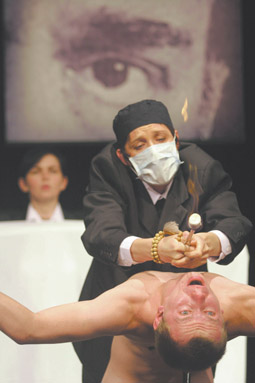
Being Harold Pinter, Belarus Free Theatre,
photo Trent O’Donnell
Being Harold Pinter, Belarus Free Theatre,
THE MINSK-BASED PERFORMANCE GROUP BELARUS FREE THEATRE MADE THEIR MUCH-ANTICIPATED AUSTRALIAN DEBUT WITH BEING HAROLD PINTER AT THE SYDNEY FESTIVAL, AND THIS WORK TOOK ON A GREAT POIGNANCY FOLLOWING HAROLD PINTER’S RECENT DEATH ON CHRISTMAS EVE.
Much of the excitement around this company’s work derives from its political context. Described by producer Natalia Koliada as “Europe’s last dictatorship”, Belarus under President Alexander Lukashenko is very far from a safe place to create political theatre. In a nation where every aspect of life, including artistic practice, is strictly regulated, Belarus Free Theatre work underground to produce uncensored accounts of life under the totalitarian regime. Co-founded in 2005 by Koliada and her husband Nikolai Khalezin, a playwright and journalist, the Belarus Free Theatre has created 11 productions, and regularly travels internationally, drawing attention to the plight of their homeland. For their efforts in daring to imagine a free and democratic Belarus, their audiences in Minsk have been arrested, performances broken up by armed police, actors denied exit visas, artists threatened and assaulted, writers banned from production and company members and their families fired from State-run institutions.
For Koliada, “it’s very complicated when you have family, when you have small children. When you get fired you cannot get any other job in our country…But we understand this. We have a very great teacher, who is Vaclav Havel, who told us we need to speak very loudly and openly in order to stop dictatorship. Otherwise we would just prolong this dictatorship.”
Attending a Belarus Free Theatre performance in Minsk is a clandestine experience. Performances take place in private homes, basements and cafes, rarely at the same place more than once. Performances often occur in the middle of the day, and audiences are notified by text message as to the time and location. According to Koliada, the desire has always been not only to resist oppression by using theatre to address forbidden topics, but also to produce a visceral and dynamic theatre aesthetic. “When we organise the theatre, we decided that it should be aesthetic opposition first of all. If we have a high standard of aesthetic opposition then…we could change aesthetically a society, and when we have such an artistic product then we could attract more attention for political changes.”
being harold pinter
When asked why Belarus Free Theatre chose to work with Pinter’s texts, Koliada replies: “when we read it we understood that he understands us better than many people who live in Belarus.” Even though the plays are not about Belarus, their inherent menace seemed to the company to perfectly capture the experience of contemporary life under Lukashenko. In Pinter, they found that there could be “an essence of violence in just words”, and Being Harold Pinter explores this in detail, using Pinter’s drama and commentary to sharply critique and devastatingly enact the violence that underpins intimate relationships and social institutions.
Adapted and directed by Vladimir Scherban, the performance incorporates Pinter’s Nobel Prize address as a springboard to analyse the hidden currents of his writing and simultaneously demonstrate the arbitrary demands that totalitarian regimes make upon the bodies of citizens under their power. Scherban’s textual montage blends Pinter’s speech with excerpts from six of his plays, and into this he inserts accounts from political prisoners in contemporary Belarus. It’s a startling interpretation, delivered at a pace that allows little space for the famous Pinteresque pauses. Questions swirl about the different needs for truth in art and politics, the possibilities of making political art, ways of negotiating the dissimilar responsibilities of the artist and citizen, and the violence inherent in dramatic language itself.
The performance begins with Pinter (Oleg Sidorchik) brandishing a cane, describing a recent fall he has suffered. As he speaks about his head hitting the pavement, and blood splashing, Sidorchik places a hand over his face. Another cast member sprays him with red paint and places a sticking plaster over his eye. Returning home, the news informs Pinter that he has died and, shortly afterward, that he has not, but rather that he’s been awarded the Nobel Prize. “So I’ve risen from the dead”, he declares.
Pinter reflects upon the beginnings of several of his plays, noting that “our beginnings never know our ends.” All he knew at the start were the opening lines. This reverie is radically broken as the Sidorchik turns on one of his colleagues. Cane pressed against throat, he makes a violent interrogatory demand: “What did you do with the scissors?” The world of the performance has disorientingly tilted on its axis. Is he still Pinter? The character Mac from the play The Homecoming (1964)? A secret policeman in Belarus? All of the above?
Being Harold Pinter is most effective in these early scenes—an utterly riveting, relentlessly paced and forcefully delivered theatrical presentation. Even simple exchanges bristle with menace and acquire accusatory overtones. The seemingly laid back opening conversation of Old Times (1970) reveals a deep vein of potential violence. “You lived with her” is transformed in the mouths of the Belarus Free Theatre actors from a question into a threat. Shortly afterward, an excerpt from Ashes to Ashes (1996) oscillates between intimacy and madness. “I’ve just paid you a compliment. In fact I’ve paid you a number of compliments.” The threats get less oblique as the performance continues, with Scherban’s treatments of Pinter’s The New World Order (1991) and Mountain Language (1988) recognisably mirroring the operations conducted in the name of the War on Terror. In The New World Order, a parade of torturers amuse themselves by first teasing, then mutilating a prisoner. One confesses to the other that these actions make him feel pure, and his comrade responds that this purity is because he is “keeping the world clean for democracy.”
Order itself becomes a form of amusement for the prison guards who populate Mountain Language, with violent acts deemed to have not truly occurred until they can be properly accounted for. A woman savaged by a guard dog has no injuries that can be recognised until she is able to name the dog that is to blame. Unless the dog gives its name, there has been no violence. Another woman’s husband has been mistakenly imprisoned, but the guards refuse to acknowledge that anyone but the Mountain people might be contained within the prison. Finally, after being punished for speaking in the forbidden language, the prisoner is advised that the rules have changed. They are now allowed to speak in their own language, but it is too late. The old mother has already been beaten to death for an infraction now deemed innocent.
Each of these sharp vignettes is introduced by the figure of Pinter himself, who reels from one desperate exchange to another, searching for truths about art and power. “Political language, as used by politicians, does not venture into any of this territory since the majority of politicians, on the evidence available to us, are interested not in truth but in power and in the maintenance of that power.” Coming as they do from a nation in which the maintenance of power involves the active repression of citizens, the Belarus Free Theatre are courageous theatre makers.
the pianist
In contrast to the dynamism of Being Harold Pinter, The Pianist is a largely static performance. In the dark Belvoir Street upstairs space, a grand piano sits centrestage with music stands scattered about. Within this simple staging, The Pianist is essentially a recital performed by Mikhail Rudy, intercut with narration from actor Sean Taylor.
Adapted from the memoirs of Polish pianist Wladyslaw Szpilman, the narration tells an extraordinary tale of endurance and survival in a world gone mad. Beginning with a series of portraits of life in the Warsaw ghetto in 1941, we follow Szpilman as he manages to escape transportation to the concentration camps, and finally traces his subsequent years in hiding in the deserted city. Concealed in an attic, lying quietly day after day, Szpilman kept himself sane by rigorously rehearsing every piece of music he had ever played, a silent discipline to help him ward off certain death. Music itself became materialised through memory, a way of mentally inhabiting better days and a means of survival through imagination. In an encounter with a German officer in the last months of the war, music literally becomes the currency ensuring life, as Szpilman successfully proves he is in fact a pianist by playing Chopin’s Scherzo in B Minor on an untuned, abandoned instrument.
As the voice of Szpilman, Taylor is suitably restrained, and Rachel McDonald’s direction is simple and uncluttered. The Pianist is hardly groundbreaking theatre, but is nevertheless quietly effective. Rudy’s passionate delivery of Chopin’s Nocturnes provides the emotional underpinning of Szpilman’s almost clinical account of his experiences. It’s as if Chopin’s music contained all that remained unsayable for Szpilman: the combination of the barely said and the emotive musical overflow makes The Pianist a frequently moving experience.
Belarus Free Theatre, Being Harold Pinter, based on the plays of Harold Pinter, adaptation, direction Vladimir Scherban, performers Nikolai Khalezin, Pavel Gorodnitski, Yana Rusakevich, Oleg Sidorchik, Hanna Solomianskaya, Denis Tarasenko, Marina Yurevich, producers Natalia Koliada, Nikolai Khalezin, lighting Stephen Hawker; Belvoir St Theatre, Q Theatre, Sydney Festival, Jan 6-Feb 1; The Pianist, based on memoirs of Wladyslaw Szpilman, concept, script Mikhail Rudy, director Rachel McDonald, performers Mikhail Rudy, Sean Taylor, design Jo Briscoe, lighting Stephen Hawker; Belvoir St Theatre, Sydney Festival, January 16-27
RealTime issue #89 Feb-March 2009 pg. 9
© David Williams; for permission to reproduce apply to realtime@realtimearts.net
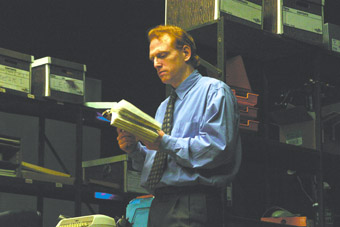
Scott Shepherd, GATZ, Elevator Repair Service
photo Chris Beirens
Scott Shepherd, GATZ, Elevator Repair Service
FROM NOW UNTIL JUNE THERE’S A WEALTH OF ADVENTUROUS ART TO EXPERIENCE ACROSS THE COUNTRY. HERE’S ADVANCE NOTICE OF SOME OF THE SHOWS THAT HAVE GRABBED THE INTEREST OF REALTIME’S EDITORS.
elevator repair service, gatz
You enjoyed the plethora of theatrical epics in this year’s Sydney Festival and you’re a fan of Scott Fitzgerald’s The Great Gatsby. Or you’ve never read it but would love to have it read aloud to you, word for word. Then GATZ is for you: a seven-hour show that’s travelled the world since 2006 from New York’s Elevator Repair Service innovatively tackling the very nature of reading and performance. Adventures, Sydney Opera House, May 15-31; www.sydneyoperahouse.com
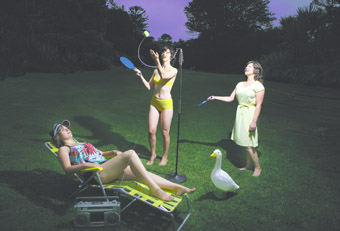
My Darling Patricia, Night Garden
photo Jeff Busby
My Darling Patricia, Night Garden
peformance space: my darling patricia’s night garden
Following the success of the award-winning Politely Savage, the long awaited Night Garden from My Darling Patricia looms (see photo page 2). This work furthers the company’s exploration of gothic Australia, distinctively fusing performance, puppetry, video and installation—here the skeleton of a burned-out house. The Australia-Japan photomedia collaboration, Trace Elements, is also on show until March 21. And in May, There Goes the Neighborhood, curated by Zanny Begg and Keg de Souza, explores the politics of urban space. Meanwhile performer Rosie Dennis’ highly anticipated new show Fraudulent Behavior premieres in June. Performance Space, Night Garden, CarriageWorks, March 6-14; www.performancespace.com.au
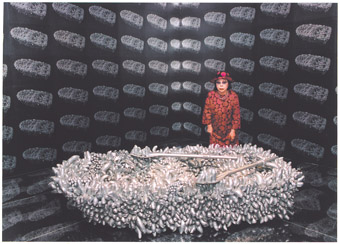
Yayoi Kusama, Walking on the Sea of Death, 1981
courtesy the artist, Victoria Miro Gallery, London and Ota Fine Arts, Tokyo
Yayoi Kusama, Walking on the Sea of Death, 1981
mca: yayoi kusama: mirrored years
You won’t see stars, but spots will certainly appear before your eyes when you enter the immersive worlds of Japanese artist Yayoi Kusama (see page 3). Single works have been exhibited previously in Australia but here is an exhibition on the grand scale: film, performance documentation, sculpture, installation work and painting, including 50 recent print works. A unique vision, a transformative experience. Museum of Contemporary Art, Sydney, Feb 24-June 7; www.mca.com.au
malthouse/arena: goodbye vaudeville charlie mudd
Some of the most innovative theatre of recent years (The Black Swan of Trespass, The Eisteddfod) has come from Melbourne’s Stuck Pigs Squealing underpinned by the collaboration of director Chris Kohn and writer Lally Katz. Kohn is now artistic director of Arena Theatre, but the creative relationship with Katz persists in a Malthouse-Arena co-production, Goodbye Vaudeville Charlie Mudd. With Kohn’s keen eye for the languages of theatre this show resurrects the vaudeville world of 1913 Melbourne but through the prism of Katz’s surreal imaginings. Malthouse, March 6-28, www.malthousetheatre.com.au; www.goodbyevaudeville.blogspot.com
clocked out: the wide alley
The dynamic Brisbane-based duo of composer-pianist Erik Griswold and percussionist Vanessa Tomlinson have an extensive 2009 program taking them to Sydney, Auckland, remote Queensland and Canberra. In March at Sydney Opera House’s The Studio and then at the Auckland Festival they will fuse traditional music from the street and opera of China’s Sichuan Province with their own avant-garde creations. Aural excitement is guaranteed in a Clocked Out gig. The Studio, Sydney Opera House, March 1, 5pm, www.sydneyoperahouse.com
stc: martin crimp’s country
Looking well ahead to late June, here’s one for the diary: Benedict Andrews’ production of The City by leading English playwright Martin Crimp (Attempts On Her Life, The Country). Those who saw Andrews’ engrossing production of Marius von Mayenburg’s Eldorado for Malthouse in 2006, will recognise what has doubtless attracted the director: everyday suburban life goes doggedly if bizarrely on while a ‘secret war’ rages. In the meantime STC’s offering a welcome revival of Tom Stoppard’s Travesties in March and two visiting Kafka shows in April: Kafka’s Monkey (from his Report to the Academy) performed by the UK’s Kathryn Hunter, and an Icelandic physical theatre rendition of Metamorphosis (p3, p16). STC, The City, June 29-Aug 9, www.sydneytheatre.com.au
casula powerhouse: nam bang!
Thirty four years after the Vietnam War, Casula Powerhouse is mounting a major show of works by 25 artists from Australia, Vietnam and beyond that reflect imaginatively on the experiences of those involved and their descendants. Artistic director Nicholas Tsoutas aptly asks, “When does war become art?” An international conference, with prominent arts writer and activist Lucy Lippard as keynote speaker, will take place April 17-18. Casula Powerhouse, Sydney, April 4 –June 21; www.casulapowerhouse.com
sound travellers 2009 and free cd
Now in its second year, Sound Travellers has a substantial touring program of sound art, improvised jazz and contemporary classical music.You can see the program on the organisation’s website and while there request a free CD of a collection of works by the touring artists—including Topology, Ross Bolleter (a featured artist in Ten Days on the Island), Pivot, Joel Stern, Ensemble Offspring, Mark Isaacs, Camilla Hannan, Klumpes Ahmad and more. www.soundtravellers.com.au
double take: ann landa award 2009
You may well do a double take when you see the list of artists competing for the 2009 Ann Landa Award for Video & New Media Arts: Cao Fei (People’s Republic of China), Gabriella Mangano & Silvana Mangano (Australia), Phil Collins (UK), TV Moore (Australia), Lisa Reihana (New Zealand) and Mari Velonaki (Australia). Yes, the award’s gone international. The mix of video, interactive robotics and digital photography will inherently tackle the big question, “How can we be both the self, and an other at the same time; both a self, and an out-of-body split self?” Art Gallery of New South Wales, May 7-July 19, www.artgallery.nsw.gov.au
the chauvel cinema does expanded cinema
As part of its Cinematheque program, Sydney’s Chauvel is showing an expanded cinema program “devoted to (mostly) Australian experimental art films that use multiple projectors.” The program includes Paul Sharit’s twin screen, looping Razor Blades (US,1968), John Dunkley’s pattern-play Rotunda, Dirk de Bruyn Experiments (1982), a veritable catalogue of techniques and “a scream from suburbia”; Arthur and Corinne Cantrill’s The City (1970), “a composite view of the city is created by three films screened simultaneously”; and from the same filmmakers, Meteor Crater—Gosse Bluff (1978). Also coming up at the Chauvel on March 6 is a rare opportunity to see two recent films by popular, award-winning Czech filmmaker David Ondricek. Chauvel Cinema, Paddington, Sydney, Feb 23, 6.30pm; www.chauvelcinema.net.au
blacktown arts centre: blind as you see it
We haven’t seen their work yet, but the emerging Shh Company are tackling a challenging subject with their director and composer Michal Imielski. Blind As You See It fuses puppetry, theatre, music and dance in an exploration of the experience of losing one’s sight. Blacktown Arts Centre, Sydney, Feb 27-28; www.artscentre.blacktown.nsw.gov.au
syncretism: lawrence english + no anchor
Brisbane’s No Anchor experimental duo “creates an utterly engulfing wall of sound” while Lawrence English generates immersive sound fields with material from his album, Colour for Autumn. With a guest appearance from Heinz Riegler. Judith Wright Centre, March 21; www.judithwrightcentre.com
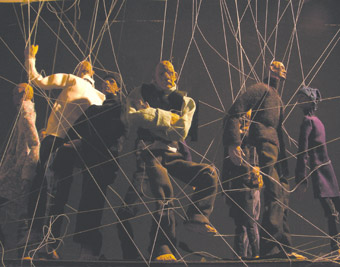
Fleur Elise Noble’s filmic-theatre production 2-Dimensional Life of Her
come out: 2-dimensional life of her
One of the many intriguing hybrid performances in the 2009 Come Out Festival is young Adelaide artist Fleur Elise Noble’s 2-Dimensional Life of Her (see photograph on page 2). An earlier version won the Best in Show award in the 2008 Brisbane Festival’s Under the Radar program. The work involves three projectors, animation, drawing and an audience immersed in paper, and will have an accompanying drawing installation at the Experimental Art Foundation. Come Out 2009, Adelaide, May 18-30; www.comeout.on.net
griffin theatre company: ross mueller’s concussion
In a co-production with STC, Griffin is staging Ross Mueller’s Concussion, an edgy comedy about a man who wakes up without a memory. Melbourne’s Mueller, like Tasmania’s Tom Holloway, is a distinctive and relatively new voice in Australian theatre. In the meantime, don’t miss Ranters’ Holiday at The Stables (it closes Feb 28)—a potent example of the strange paths opening up in contemporary theatre. Griffin Theatre Company, Concussion, Wharf 2, Sydney, March 17-April 4; www.griffintheatre.com.au
song company: tenebrae iii
An annual highlight has been the Song Company’s Good Friday event, a powerful fusion of song and dance, directed in the past by Kate Champion at Sydney Town Hall (2005, 2006), this time by Shaun Parker in the vast industrial spaces of CarriageWorks. Tenebrae III is based on Gesualdo’s Responsories for Holy Week, sublime music evoking the spiritual extremes of belief. And you don’t have to be Christian to appreciate the emotional power of Tenebrae III. CarriageWorks, Sydney, April 8, 10; www.carriageworks.com.au
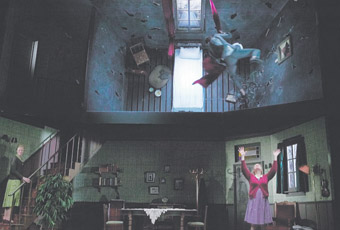
Metamorphosis, Vesturport Theatre
photo Eddi
Metamorphosis, Vesturport Theatre
10 days on the island
This unique across-the-island biennial event draws on its own and other island cultures to entertain and challenge us. It’s a wonderfully intimate live-in festival. In 2009 the festival includes a significant Indigenous dance program in Launceston and innovative performances all over, including two hot shows from Iceland. See page 16 for Carl Nilsson-Polias’ interview with Ten Days director Elizabeth Walsh. Ten Days on the Island, Tasmania, March 27-April 5; www.tendaysontheisland.org
RealTime issue #89 Feb-March 2009 pg. 10
© RealTime ; for permission to reproduce apply to realtime@realtimearts.net
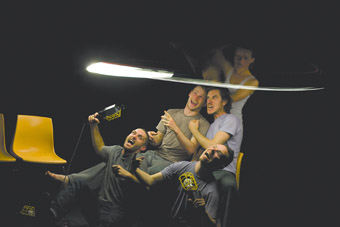
Byron Perry, Antony Hamilton, Lee Serle, Stephanie Lake, I Like This, Chunky Move
photo Genevieve Bailey
Byron Perry, Antony Hamilton, Lee Serle, Stephanie Lake, I Like This, Chunky Move
THE VARIOUS LABELS WE USE TO CATEGORISE THE CAREER DEVELOPMENT OF ARTISTS—EMERGING, PRO-AM, MID-CAREER, FRINGE, PROFESSIONAL—ALWAYS HANG UNEASILY UPON THEIR SHOULDERS, LIKE A RENTAL TUX THAT’S BEEN THROUGH THE WASH ONE TOO MANY TIMES. THEY’RE USUALLY EMPLOYED TO POSITION SOMEONE WITHIN A LARGER ‘INDUSTRY’, BUT THE AMORPHOUS NATURE OF THE ARTS, ALONG WITH FICKLE FUNDING, THE DIFFICULTY IN DEFINING A ‘MAINSTREAM’ AND THE WONDERFUL CROSS-DISCIPLINARY ACTIVITIES WHICH MAKE UP SO MUCH OF OUR CREATIVE LANDSCAPE CONTRADICT SUCH PIGEONHOLING. THREE PRODUCTIONS WHICH APPEARED AT THE TAIL-END OF 2008 ARE CASES IN POINT.
Byron Perry and Antony Hamilton are amongst the most recognisable contemporary dancers in Melbourne, having featured heavily in the calendars of Chunky Move and Lucy Guerin Inc for several years as well as popping up in the works of younger dancemakers. Their first original collaboration, I Like This, can’t really be classed as the debut of two emerging choreographers. There are two immediately apparent reasons: firstly, both dancers have distinct styles and interests which have been evident in their previous performances for others. Secondly, the influences of these earlier mentors have left particular traces in the witty, astute form of I Like This.
Billed as a choreographic conversation between Hamilton and Perry, the work is partly an exploration of the process of dance-making, in which their ideas of what the work is to become are played out around them by a cadre of talented performers. But while this kind of meta-theatre is hardly ground-breaking—and reached a superb apex in Guerin’s and Chunky Move’s respective contributions to the last Melbourne International Arts Festival (see RT88, p4), both starring Hamilton and Perry—I Like This takes its concepts in pleasing new directions. It’s not a navel-gazing piece of the sort presented in Wendy Houstoun’s Desert Island Dances, another MIAF event. Here, action supercedes analysis.
The duo clearly recorded their rehearsal process and used the result to produce a kind of remixed dance. The performers begin to move, then rewind, skip or become stuck in loops. All the while, Perry and Hamilton sit surrounded by lighting panels, power boards and snaking cables, orchestrating the handheld lamps carried by the dancers. In fact, Perry and Hamilton’s visual design for the work deserves particular mention, becoming a character almost in itself, with hundreds of perfectly executed changes whose sometimes stroboscopic effect makes lighting operation appear a form of choreography in its own right.
It’s self-reflexive dance, certainly, but by incorporating technology in such a sophisticated way it becomes something much more. And when the work ends with the two choreographers covered by a giant quilted doona, lights sparking underneath like flashes on a distant mountain range, the result approaches the sublime. Emerging artists? Far from it.
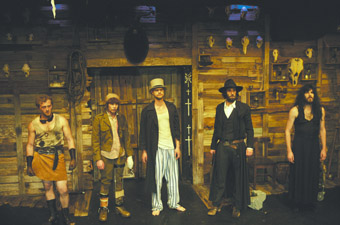
Avast, Black Lung
photo Jeff Busby
Avast, Black Lung
The Black Lung are another ensemble well entrenched in Melbourne’s independent arts scene while occupying an utterly, defiantly outsider space. But, testament to the inadequacy of such categories, they were picked up by the Malthouse for a residency in its Tower program.
The Tower season consisted of a remounting of Avast, first produced three years ago, and a new work entitled Avast II: The Welshman Cometh. The theatre itself was radically transformed during the three month residency, outfitted with dingy couches, graffiti-covered walls and a massive wooden set filled with animal skulls, worn leather, animated dummies and dusty ephemera. Both productions were equally ramshackle, eclectic and brilliantly detailed.
The Black Lung create the kind of anarchy that can only result from incredible precision, an effect most notably associated with Forced Entertainment. During Avast, a confrontation between two brothers haunted by a legacy of familial murder and betrayal is interrupted by a falling spotlight which crashes to the ground inches from the actors’ feet. They are visibly shaken as they attempt to continue the scene, and convincing the audience that this wasn’t a pre-planned moment only proves the astounding capabilities of these performers. Similarly, the constant sense of competition, potential violence and despair of the actors themselves creates a brilliant blurring of understanding—are we watching something taking place, or something failing to take place?
Underneath the deliberate chaos is a thick questioning of theatre, narrative convention and masculinity. The two works are almost entirely composed of pastiche, quotations from film, literature and generic devices overlapping constantly. It’s all brutally blokeish too, with the only female character killed in the opening moments of Avast (unless you count another male character’s inexplicable change in gender halfway through the second work). And while Avast II is evidently a new work, the three years of development accorded Avast have made it one of the tightest, funniest, scariest pieces of theatre I’ve seen in years.
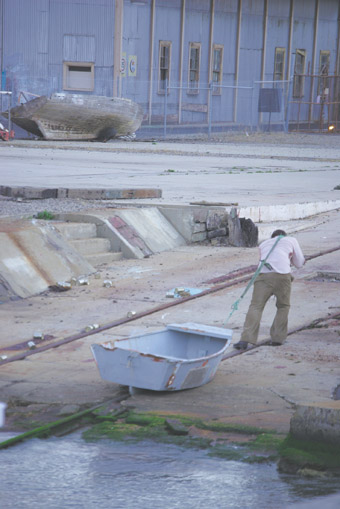
Collapse, Red Cabbage Collective
photo Matthew Scott–Cheeky Monkey Enterprises
Collapse, Red Cabbage Collective
Melbourne collective Red Cabbage might be the artistic equivalent of the Slow Food movement—like incidental fellow travellers such as Eleventh Hour Theatre, Red Cabbage eschew quantity for quality, creating one work per year. The time commitment was certainly evident in Collapse, an epic, large scale installation and performance located across a remote former maritime precinct in Williamstown. Audiences were transported by a 20-minute boat ride to a post-apocalyptic world both staggering and serene. Disembarking from the vessel, we were met by linen-clad survivors of some disaster dredging canned food from the ocean, hauling rotten row-boats across concrete as the twilight descended; we gathered in a vast, weed-strewn warehouse where women lyrically spoke around the mysterious disaster which had befallen the community; we roamed a maze of sheds, alleyways and ruined sites housing countless traumatised inhabitants coping with the new reality into which they’d been reborn. An alchemist conducted strange experiments in a bubbling lab while a babbling wreck spewed poetry in a nearby shanty. The enigmatic, voyeuristic voyage ended in a gargantuan warehouse-cum-cinema, a ragged corps of drive-in speakers standing to attention before the flickering celluloid images retrieved from a lost world. Gaps in the canvas screen revealed blue skies and drifting clouds, as much a memory as the filmic footage being projected. The survivors gathered before this iconic scene in reverential silence. Minutes later, it was all over.
Collapse’s narrative was piecemeal and its meaning kept obscure, allowing each visitor their own interpretation. The audience was allowed to wander individually; unlike the masterfully subtle control of attention exercised by another interesting company, Peepshow Inc’s similar The Mysteries of the Convent (2008), there were plenty of opportunities to miss a dramatic moment or provocative scene here. Collapse’s effect was a cumulative one, however—even the relatively uneventful prefacing boat ride worked to establish a mood of quiet distance and reflection, producing a sense of reverie.
It’s difficult to stamp any of these three works as “emerging”, though all fit a technical definition. But all are equally the products of artists who have been honing their crafts for years and all exceed journeyman status. The next evolutionary step for each will most likely prove just as hard to classify.
I Like This, choreography, direction, lighting, sound Antony Hamilton, Byron Perry, performers Hamilton, Perry, Stephanie Lake, Alisdair Macindoe, Lee Serle, costumes Paula Levis, Chunky Move Studios, Nov 20-29; Avast and Avast II: The Black Lung Theatre Company, The Welshman Cometh, performers Sacha Bryning, Gareth Davies, Thomas Henning, Mark Winter, Thomas Wright, Dylan Young, sound design, music Liam Barton, lighting design Govin Ruben,Tower Theatre, CUB Malthouse, Nov 12 – Dec 6; Red Cabbage, Collapse, creators Louise Morris, Tania Smith, Kirsten Prins, Anna Hamilton, performers Jason Lehane, Claire Reynolds, Maria Sirpis, Jason Cavanagh, Kate Boston Smith, Alice Claringbold, Ross Farrell, Krista Green, Portia Chiminello, Carlo Marasea; Seaworks, Williamstown, Melbourne, Nov 19-30, 2008
RealTime issue #89 Feb-March 2009 pg. 12
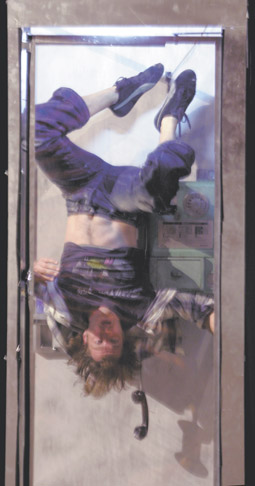
Grayson Millwood, Roadkill, Splintergroup
photo Tim Bates
Grayson Millwood, Roadkill, Splintergroup
REALTIME’S COVERAGE OF LAST YEAR’S MELBOURNE INTERNATIONAL ARTS FESTIVAL FEATURED AN EXCITING RANGE OF NEW DANCE WORK FROM LOCAL ARTISTS. FOR THE DEPLETED SECTOR IN SYDNEY, MASS MIGRATION WAS SERIOUSLY CONTEMPLATED. IN MARCH, IN A WELCOME JOINT INITIATIVE, THE THREE HOUSES OF MELBOURNE’S CONTEMPORARY PERFORMANCE CULTURE—ARTS HOUSE, DANCEHOUSE AND MALTHOUSE ARE THROWING OPEN THEIR DOORS TO CO-HOST TWO WEEKS OF CONTEMPORARY DANCE PROGRAMMING IN THE FORM OF DANCE MASSIVE. THE GENEROSITY IMPLIED IN THE EVENT’S TITLE IS REFLECTED IN A PROGRAM OF 15 WORKS FROM WITHIN AND OUTSIDE THE HOME STATE.
Part of the function of such events is for audiences to survey the form, to muse on its preoccupations. What strikes me in promotional literature for the programmed works is the language constellating around oppositions, the difference between states of being and, biting at those binary ankles, ideas of liminality and hybridity. These spaces of uncertainty and possibility occur both in the form and subject matter of the works. Live performance meets film and installation in Russell Dumas’ Huit à Huit. In Lucy Guerin’s Untrained, four men—two dance trained, two not—“show what each of those bodies can do with the same set of instructions, what they have in common and where their physical histories set them apart.” In 180 seconds in (Disco) Heaven or Hell, “speed dating meets pomo disco” and comes with The Fondue Set’s customary warning of “possible bad dance moves.”
Oppositional themes abound: circadian rhythms underscored by driving beats; population growth and the auditory phenomenon of feedback” (Rogue’s A Volume Problem and The Counting); Australians homesick in Berlin (Splintergroup’s Lawn); a couple stranded in the middle of nowhere (Splintergroup’s Roadkill); the monster within (Jo Lloyd’s Melbourne Spawned a Monster); two performers/two viewers (Inert); the substitution of real life for imitation (Luke George’s Lifesize). Shelley Lasica’s Vianne tests the fissures; in Limina, Michaela Pegum dances at the point where one thing becomes another and is for a time both; Helen Herbertson’s Morphia Series takes us directly to dreamstate (do not pass go); The Fondue’s No Success Like Failure playfully lays bare the schizophrenic state of the dancing life and Chunky’s Mortal Engine dares to come between the performer and her light source.
Steven Richardson, Artistic Director at Arts House, sees Dance Massive as “creating some essential critical dialogue around contemporary dance, setting a national context to present work in a concentrated cluster of programming” and also as offering the chance to host some international guests, “either presenters or potential co-producers, to really enter into that dialogue (and possible co-production) with Australian artists, many of whom are at the leading edge of contemporary dance internationally.” Currently in Australia, according to the Dance Massive program, there are around 50 dance companies and more than 200 choreographers investigating a range of techniques, culturally diverse forms, contexts and media. “Australian contemporary dance is in demand internationally. It has a strong track record for touring work,” says Richardson.
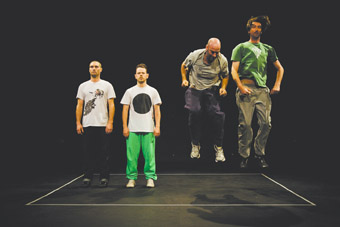
Byron Perry, Anthony Hamilton, Simon Obarzanek, Ross Coulter, Untrained, Lucy Guerin Inc
photo Untrained Artists
Byron Perry, Anthony Hamilton, Simon Obarzanek, Ross Coulter, Untrained, Lucy Guerin Inc
Dance Massive also represents for the partners “a broad audience development strategy, the possibility to create a strong concentration of work over a specific time period…We don’t have the resources to mount a festival but a concentrated program has some added benefits over and above an annual program.”
“Having companies like Chunky Move co-operatively program at the same time as some of the more emerging companies”, says Richardson, gives younger companies and independent artists a chance to have their work seen in the broader context. “I think there’ll be some interest and benefit around the positioning of different kinds of work over the same time period.”
Visiting guests will have an opportunity to see complete works rather than excerpts. “The Australian Performing Arts Market does a terrific job in terms of a kind of broad brushstroke picture of the Australian cultural landscape. But I think having a genre-specific showcase, for want of a better term, creates all sorts of other possibilities. And the fact that we’re able to invite presenters or potential co-producers who have a very strong interest in dance, who can see 12-15 works over a six-day period—that’s a fairly attractive proposition for someone who’s engaged in looking at Australian work.” It’s also a less competitive environment for artists. “Presenting a full-length work with full production values is really important. It honours the work, honours all the effort that’s gone into making it.”
As well as the dance program, there’s an industry forum day on the Monday where artists who may not be in the program will talk about their work. “Australian dance is in a position now where artists have a greater degree of self-esteem and can just talk about upcoming work.”
“Since the demise of Greenmill”, Richardson observes, “there hasn’t really been a dedicated event focusing on contemporary dance. There have been a number of ancillary programs associated with arts festivals. But I think having a stand-alone contemporary dance project is timely and Melbourne is the place to host it. There’s already a critical mass and an ecology of dance in Melbourne that can support this practice. We have a very nice temporal moment, a good confluence of presenters in Melbourne who are open to this idea, so it’s time to give it a go.”
And if it all goes well, Dance Massive may well become a biennial event. Says Richardson, “We’ll certainly undertake some evaluation once we get through the first one and see if we’ve got the design close to right and make some adjustments after that. It may be we’re trying to do too much, or too little. And there are some gaps in the program. Contemporary Indigenous work is something we haven’t really been able to support this time. That’s the tyranny of distance, of resources, of funding. There’s some intercultural, cross-cultural work that, for various reasons, both to do with funding and resources but also to do with the availability of particular works, we haven’t really been able to present. But they’re definitely on the agenda. In fact, if I had to say where the gaps are I’d have to highlight those two areas of potential strength in Australian dance that we haven’t been able to support this time round. We hope to run three Dance Massive episodes as a pilot and see how we go after that.”
Dance Massive, March 3-15; www.dancemassive.com.au
RealTime issue #89 Feb-March 2009 pg. 14
© Virginia Baxter; for permission to reproduce apply to realtime@realtimearts.net
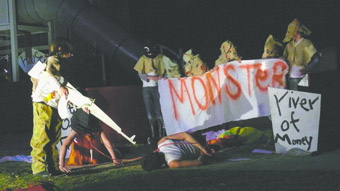
play:ground
photo Irene Rincon
play:ground
IN 2008 I SAW A LOT. ONE HUNDRED AND NINETY EIGHT LIVE PERFORMANCES BY MY RECKONING, NOT INCLUDING LIVE MUSIC. AND I SAW A LOT OF KIDS ALONG THE WAY. I SAW KIDS SHOT OR GARROTTED, DRENCHED IN BLOOD (THE WOMEN OF TROY; THANKS BARRIE KOSKY) OR SCREAMING THEIR INJUSTICES AT ME. I ALSO SAW KIDS BARING RICTUS-LIKE SMILES AS THEY BEGAN PAINFUL BALLET CAREERS, AND KIDS WITH NO DREAMS OF STARDOM RELUCTANTLY DRAGGED ONSTAGE DURING FAMILY SHOWS. I SAW ADULTS ACTING AS CHILDREN, BUT THAT’S RARELY INTERESTING.
Maybe I’m presuming, but I’m pretty sure we were all kids once. I don’t have any children but I think childhood is a fine subject for any artistic worker. This opinion piece—and that’s all it is—is not really a comment on the Bill Henson debate, though it will necessarily intersect with the murky issues that case brought to public attention. What interests me here is less about the depiction of children in art and more about their participation.
Last year I attended a performance directed by a VCA masters student entitled play:ground. Claudia Escobar created the work as a response to the child soldiers who exist around the world, including in her homeland of Colombia. The piece was performed in a twilight-bound park by primary school children who engaged in mock battles, were terrorised or recruited by sinister authority figures, and turned upon each other in savage fashion as they became inured to the reality of violence.
For these child performers, as for real child soldiers, killing bore no more reality than a videogame or schoolyard playfight. This was the point of play:ground, in part. But the spectacle of pre-adolescent kids riddling each other with machinegun bullets or emerging from the trees covered in the sackcloth hoods of terrorists and toting fake semi-automatic weapons was authentically disturbing for its adult audience. An effective and deeply provocative evocation of a very real contemporary horror, yes, but also more unsettling in its involvement of real children playing out—and thus vicariously participating in—the problem.
Barrie Kosky’s Women of Troy was an equally violent spectacle. Its unending cacophony of ear-splitting gunshots was either traumatic or numbing, depending on your response. And near the work’s climax, as dictated by Euripides himself, the figure of a dead young boy appears, carried in a bloody cardboard box. As with play:ground, I doubt that the child in question was adversely affected by the performance. I played dead when I was a kid.
But I’m surprised that the spectacle of violence towards children doesn’t raise hackles in the way that sexuality does. I’m sure it’s something to do with our troubled notion of consent. Children are assumed (legally at least) to be unable to make informed, adult decisions regarding certain aspects of their lives, and laws and safeguards are in place to make those decisions for them. I have no problem with this. But the Henson affair barely touched upon a more challenging aspect of this system of protection: is a child’s right to self-determination also taken out of their hands in the realm of representation? That is, can an adult decide whether and how a child’s image may be presented in the public sphere?
An Anne Geddes calendar featuring babies in pot-plants or dressed as watermelons is a commercial goldmine, but how would the same buying public feel about similar shots featuring people suffering dementia or Alzheimer’s? Not so cute, sure. But ethically on the same level. Former UN Secretary-General Javier Pérez de Cuéllar has suggested that “a society is judged…by the quality of life which it is able to assure for its weakest members.” I wonder if that concept can be extended to the rights we accord others to control their self-representation.
For several years I tutored tertiary students in a subject on art and censorship. Every new class arrived with a surprisingly regular set of opinions on the topic— censorship was unequivocally wrong, and freedom of speech was an essential component of our culture. Western liberal democracy is founded on this rhetoric, though a little nudging suggests limits most people would agree with. Censorship might not be so bad when it comes to child pornography, religious vilification or racial discrimination, for instance. And indeed, if we broaden our notion of censorship from the simple state-imposed variety to the more organic forms of censorship—the way we censor our own thoughts and comments, or the community censorship that exerts an influence on the discursive relations amongst any social group—the black ban on capital-C censorship becomes more muddled.
And what irked me most about the Henson debate and its offshoots was that a most pernicious form of censorship was exercised by even the artist’s most strident defenders. What was absent from discussions was the voices of those in question, for whom we’re all happy to speak. Children simply do not have a public voice in the way that a mature white male artist or a newspaper columnist or a prominent politician has. The censorship of a child’s voice is not legally enshrined but it’s no less institutionalised. And I suppose my concern here stems from the fact that despite all the kids I saw onstage last year, I’ve never had a sense that anyone is particularly interested in speaking to, rather than for, a demographic whose minority status stems from age alone.
The one exception could have been Tim Etchells’ That Night Follows Day, which appeared at the Melbourne International Arts Festival. Here, a few dozen children of various ages chanted a litany of complaints to their audience: “You teach us that in the world there are bad men/ That monsters are not real/ That words are only words/ That the shadows are nothing to be frightened of.”
My sister has recently been working on a documentary called Eleven, which features interviews with 11-year-olds from around the world. Her theory is that kids at that age are no longer children but not yet adults. The results are compelling. Her subjects speak about sexuality, terrorism, cold fusion technology, romance, action movies and politics, often in the same sentence. They are thoughtful and generous, mostly startled that someone would care to hear their opinions on things that are normally considered the discursive province of grown-ups alone.
I recommended That Night Follows Day to my sister, who attended a showing followed by a public discussion of the piece. She was disappointed to learn, as I had, that the text itself had been written by adults. A producer explained that the thoughts of the juvenile participants wouldn’t have produced the effective, impactful political statement which the work ended up delivering. They would have talked about rainbows and boyfriends. I have to disagree.
RealTime issue #89 Feb-March 2009 pg. 15
© John Bailey; for permission to reproduce apply to realtime@realtimearts.net
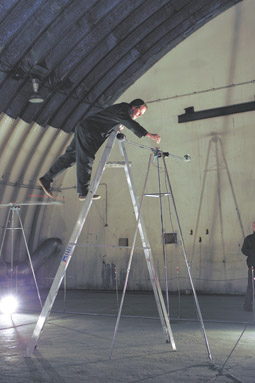
Siren, Ray Lee
photo Steven Hicks
Siren, Ray Lee
ITS UNIQUE BREADTH OF GEOGRAPHICAL LOCATIONS AND ITS DISTINCTIVE SENSE OF PAN-ISLAND FRATERNITY HAVE ALWAYS SET TEN DAYS ON THE ISLAND APART FROM ITS MAINLAND FESTIVAL COUSINS. FOLLOWING ON FROM HER WORK IN 2007, ARTISTIC DIRECTOR ELIZABETH WALSH SEES THIS YEAR’S PROGRAM AS “GOING A BIT FURTHER” WITH REGARD TO PROVIDING AN EVEN MORE INNOVATIVE AND CHALLENGING PROGRAM OF EVENTS.
When I interviewed her, Walsh was in Melbourne for the opening of Woyzeck at the Malthouse Theatre. This particular translation and adaptation of the Georg Büchner play is by the Icelandic writer, director, actor and former gymnast Gisli Örn Gardarsson, whose version of Franz Kafka’s Metamorphosis is one of the headline productions at the Ten Days festival. The popularity of Gardarsson’s work on our shores, though seeming rather sudden, has been only a matter of time. With his theatre company, Vesturport (see page 3), Gardarsson has become a darling of the British theatre scene thanks to the extreme physical acrobatics he employs in his theatrical adaptations—the result of bringing his gymnastic skills and aesthetic to bear on projects from Romeo and Juliet to Faust. And, on most of these pieces, he has collaborated with Australian musicians Nick Cave and Warren Ellis, whose output in recent years has increasingly included scores for stage and screen. In terms of theatrical antecedents, Gardarsson’s Metamorphosis is a very different dish to that served up by Steven Berkoff in 1969. Where Berkoff used his physical alacrity and invention to construct Gregor Samsa’s entire world from lights and a few bits of scaffolding, Gardarsson’s vision is grander and locates Samsa within a much more traditional theatrical design. Nevertheless, both are very much vehicles for physical virtuosity and, in that respect, Gardarsson’s pedigree is hard to fault.
On the topic of pedigree, Wu Hsing-kuo’s company has the potentially hubristic moniker of Contemporary Legend Theatre. However, having studied Chinese opera from the age of 11 and performed as lead dancer for the extraordinary Cloud Gate Dance Theatre, Wu Hsing-kuo has earned the title. He brings to Tasmania what Walsh describes as his “party piece”—a solo performance of King Lear. Though Lear is not what everyone would call a party, there is something undeniably attractive about seeing such an outrageously ambitious project undertaken by such a capable performer. This kind of transcultural adaptation of Elizabethan drama into other equally strong theatrical traditions has some great forebears, such as Akira Kurosawa’s use of Noh elements in his acclaimed films Ran and Throne of Blood. In Wu Hsing-kuo’s version, the narrative arc of Lear’s fall from regal pageantry to barren essentialism is echoed in the costumed glory of traditional Chinese opera being gradually stripped away as the old king’s mind unravels before us.
On the musical front, Ten Days on the Island is flying Perth composer Ross Bolleter back and forth in search of Tasmania’s most attractively derelict pianos. John Cage made the ‘prepared piano’ popular and Bolleter does the same for ‘ruined pianos.’ In other words, he takes those weathered wrecks that have been sitting in a galvanised iron outhouse for a few too many decades and uses their unique aural fingerprint of decay to create his own particular brand of composition. For Walsh, this has been the perfect opportunity for the festival to interact both with the colonial heritage of Tasmania and smaller regional communities. For Bolleter, it is an opportunity to interrogate the idiosyncratic resonances of some truly decomposed ebony and ivory. And for the audience, it is a potentially inspiring call to arms and good reason to lift the sheets from those long-forgotten instruments. Having toured to Stanley, Derby and Ross, the pianos will eventually be installed in the equally neglected and remarkable Bond Store at the Tasmanian Museum & Art Gallery in Hobart, where their stories and their sounds will both be on show.
In a strangely beautiful parallel, another installation-cum-concert takes its aural inspiration from a far more modern instrument—the siren. Created by English sound artist Ray Lee, Siren stretches the possibilities of the Doppler effect to an enticing extreme. Presented at Launceston’s Queen Victoria Museum & Art Gallery, Walsh points out that the venue’s role as a nexus for science and art makes it the perfect place to install this musical experiment. Set on giant tripods, sirens and lights rotate on long arms to create a finely tuned field of sound that is interspersed with inevitable beats and natural harmonics. Within this space, the audience is encouraged to move around, adding another level of sonic mobility and distortion and thereby affording each listener an entirely personal experience of the sound. Together with fellow performer Harry Dawes, Lee moves around the space with the audience, operating the sirens and adjusting their tone. Lee is interested in what he describes, with a nod to outmoded physics, as the “circles of ether”—the invisible forces of electromagnetism and the like. In Siren, he creates an appreciable representation of these forces using the invisible yet sensible nature of sound to make manifest the waves and concentric spheres of radiation.
Someone else who radiates their own special brand of electromagnetism is the pluridisciplinary artist Hiroaki Umeda, who sneaks into the festival program with only a few performances. Bringing two dance works, Duo and ‘while going to a condition’, as well as a short video work, Montevideoaki, Umeda is one of the more exciting prospects in the festival. Watching Umeda dance in ‘while going to a condition’ is like seeing a human oscilloscope, as he builds his movements from Butoh-like restraint into frenetic climaxes. All of this occurs in front of a flickering wall of light and with the audience enveloped by an intensely loud field of electronic crackles and whirs. In Montevideoaki, Umeda’s dance is placed in front of the backdrop of the eponymous Uruguayan capital. The elementary wordplay of the title ought not obscure the fact that it was made in collaboration with Octavio Iturbe, a video artist who has previously made award-winning screen adaptations of Wim Vandekeybus’ choreography.
From the shores of another island-off-the-mainland comes Terra Che Brucia. This Sicilian combination of jazz and projected archival footage is led by saxophonist Massimo Cavallaro. The music fits quite safely into that mode of European electrojazz popularised (and done better) by the likes of Nils Petter Molvaer but the footage itself is a fascinating collection of documentaries on everyday Sicilian life made by Panaria Film between 1948 and 1950, when Italy, especially the impoverished South, was still recovering from the wreckage of the Second World War.
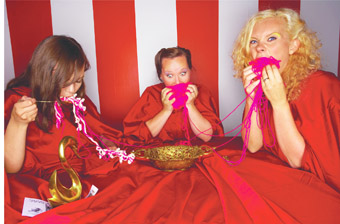
Icelandic Love Corporation, Hospitality
photo Bernhard Kristinn Ingimundarson
Icelandic Love Corporation, Hospitality
One of the more enigmatic forces in Ten Days on the Island will be the Icelandic Love Corporation. This trio of female artists (Sigrún Hrólfsdóttir, Jóni Jonsdóttir and Eirún Sigurdardóttir) produce installed happenings. Walsh met the group in Iceland and invited them to come to Tasmania largely on the basis of the way in which they made coffee. She is gleefully ready to admit that she has no idea what they are bringing to the festival, apart from the title of the show, Hospitality. One suspects there might be a few cups of something involved but the piece will undoubtedly have the wry whimsy that is bred in a country where everyone is related and the banking system has collapsed. You can catch the Icelandic Love Corporation’s particular brand of hospitality at Contemporary Art Services Tasmania in North Hobart for the duration of the festival and a few weeks afterwards.
Ten Days on the Island, Tasmania, March 27-April 5; visit www.tendaysontheisland.org for the full program
RealTime issue #89 Feb-March 2009 pg.
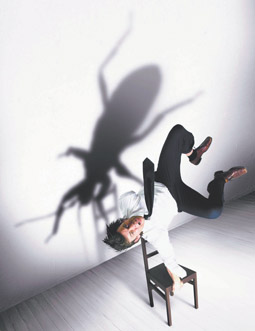
Gisli Örn Gardarsson, Metamorphosis, Vesturport Theatre, photo Eddi
Like Gisli Örn Gardarsson in this image from Vesturport Theater’s Metamorphosis (from Iceland touring to Tasmania’s Ten Days on the Island, Sydney Theatre Company and Brisbane Powerhouse), RealTime 89 dances. We preview the forthcoming Dance Massive in Melbourne (a rare attempt to build a sustained event that brings together dance artists and markets their work internationally); review performance in the Sydney Festival (celebrating choreographic intelligence and passion in theatre works); and take in dancefilm in Brighton (UK) and the remarkable brand new performance and media arts centre, EMPAC, in New York. Virginia Baxter notes in her Dance Massive preview the range of choreographic/directorial preoccupations in the event but also the way they turn on the points of transformation and mutability. John Bailey applauds Byron Perry and Anthony Hamilton’s I Like This in which visual design is “a character almost in itself, with hundreds of perfectly executed changes whose sometimes stroboscopic effect makes lighting operation appear a form of choreography in its own right”. Likewise Doug Leonard in Brisbane revels in James Cunningham and Jondi Keane’s Tuning Fork’s dance of men and objects—or are they just working? Philipa Rothfield observes the architectural imperatives that play a shaping role in Shelley Lasica’s Vianne: “There is a play between the ways the bodies are shaped by their context and the agency of those bodies. The audience is also held accountable for its engagement with the work”. In New York, Deborah Lieser-Moore finds that the work of performance group Witness Relocation is rooted in dance, just as we did when we saw the Nature Theatre of Oklahoma’s amazing dance outbursts in No Dice in the Sydney Festival. Elsewhere in this edition, the evolution of the screen is a recurrent theme, in urban spaces, in museums and in the sky and on footpaths in the magic of Adelaide Film Festival guest Rafael Lozano Hemmer. But there are other moves in art than dance and screens, like DV Rogers’ earthquake art in California, Joyce Hinterding and David Haines explorations in odour and Melinda Rackham’s in organic and intelligent materials for the Samstag Museum. Steps forward, steps sideways; intriguing moves. RT
RealTime issue #89 Feb-March 2009 pg. 1
© RealTime ; for permission to reproduce apply to realtime@realtimearts.net
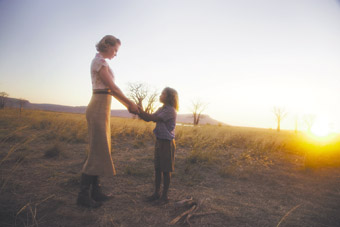
Nicole Kidman, Brandon Walters, Australia, courtesy Twentieth Century Fox Home Entertainment
TITLING A WORK AFTER ONE’S COUNTRY IS A DESPERATE MEASURE, EITHER BORN OF CAUSTIC CRITIQUE OR BOUND BY PATRIOTIC TRAUMA. THE FORMER CREATES THE PALIMPSEST OF NEGATION WHICH DARKENS ANY COUNTRY’S FLAG AND ANTHEM; THE LATTER IS DEDICATED TO CLEANING, BRIGHTENING AND GENERALLY WHITENING THE SAME. ONLY THE DEAD WOULD MISS THAT BAZ LUHRMANN’S AUSTRALIA (2008) EVIDENCES THE LATTER. YET, UNEXPECTEDLY, I FIND THE FILM TO BE ADDRESSED TO THE DEAD: TO SPEAK TO THE GHOSTS OF THIS THING CALLED ‘AUSTRALIA’ WHO HAUNT THE PSYCHE, THE MEDIASCAPE AND THE POLITICAL FORUM WHICH FORM THE AUDITORIUM FOR VOICING THE NAMING OF ‘AUSTRALIA.’
While leftist-leaning critique of the film has centred on its inaccuracies in Indigenous historicism (which completely misses the hyper-iconic self-mythologizing purpose of Australian cinema in general), Australia offers an ulterior reading in its depiction of racial hierarchy. Ultimately, death haunts the film—particularly in its mega-melodramatic final act where the dream family of Australia’s future is thought to become extinct. There’s probably a White Paper (sic) floating around Canberra’s mindscape that dreams of genetically joining anal uptight colonialism (Nicole Kidman in 100 costume changes) with iconic post-convict machismo (Hugh Jackman at the gym again) with a para-animatronic Aboriginal kewpie doll representation of Indigenous culture (Brandon Walters and his flashing teeth). When they all hug at the end, it was like watching white zombies engaged in an unknowing ritual. I felt an overwhelming sense of how utterly dead Australia is and will likely be for a few millennia still. Australia is thus more a speculative sci-fi about a dying gene-pool attempting to forge a nation according to an inane self-politicising blueprint (not to mention a telling historicist aversion to Asia). The opening and closing statements about the Stolen Generations are less solemn reflections on forced Australian nationhood and more semiotic memes that invert that socio-genetic program within the film’s Hollywoodesque melting-pot of universalising (or market-maximising) story-telling. Like all maximal cultural artefacts, Australia says nothing that it thinks it’s declaring, but volumes of what it cannot hear itself saying.
Australia is neither an embarrassment of glazed nationalistic vulgarity, nor a flailing vision of grand auteur onanism. Sure, it’s bursting with flashy neo-camp affectations inseparable from Australian prerogatives to entertain (c1970s’ camp theatre revues). Sure, it’s driven by a pseudo-PoMo flaunting of artifice (c1980s’ art photography revelling in faux-cinematic tableaux). Sure, its full of dumb journalistic paraphrasing of white guilt and patronising enshrinement of Indigenous mysticism (c1990s’ pre-millennial reassessment of post-colonial politics). But what else should we expect from this film? Indeed—what else does a nation that cried over the bloated pomp of the Sydney 2000 Olympics deserve? And what else should an industry that reads a self-centred magazine subtitled “For Australian Content Creators” require from a $130m movie chowing down on a hefty tax rebate and a financial adrenaline shot by the ATEC (Australian Tourism Export Council)?
The film is inevitably an easy target—but using a narrow-gauge shotgun is an ineffective critical strategy when aimed at the nationalist mirage within which Australian cinema’s self-image has shimmered for over quarter of a century. A wide-spray Uzi handled by a blind drunk is a better tactic. Don’t shoot the film or the filmmakers: shoot the whole context within which they are positioned.
To deride Australia yet engage in polite and earnest dinner conversation over films like Phillip Noyce’s Rabbit Proof Fence (2002), Rolf de Heer’s The Tracker (2002) and 10 Canoes (2006) invokes a simplistic binary reaction typical of the Australian intelligentsia’s support of worthy ideals in ignorance of any semiotic evaluation of the works bearing those ideals. To me, it’s straightforward to view Rabbit Proof Fence, The Tracker and 10 Canoes as humanist universalising, artsy, wannabe-informed examples of post-Mabo cinema at its most obsequious. Australia takes those themes and tizzes them up like a Tivoli burlesque revival. Of course, the film’s core impulse to ‘pizzazz’ an audience is an artistic gesture retrieved from the mouldy stage attire of Reg Livermore and his 70s ilk. Indeed, Australia is like Betty Blokk Buster Follies meets Kevin Rudd’s televised ‘Apology.’ But if that’s what Australians want: give it to them.
Any film that starts with a voice-over telling you that you are about to be told a great and wonderful story is bound to induce nausea in anyone bar script doctors. And despite Australia’s relentless bludgeoning of the senses with its mock-crème production design, mum-look-at-me digital compositing, Venusian fantasy goddess costume design and Australian Tourism’s unending dome of panagliding cinematography, Australia’s foregrounded reflexivity amounts to false genuineness through having a half-breed cute-feral androgyne regurgitate Spielbergian monologues of childhood wonder. Having stated that, I nonetheless find that Australia does effectively compress and express its melodramatic heart, and successfully tugs at the appropriate emotional strings. Ciphers that they are, Kidman, Jackman, Bryan Brown, David Gulpillil, Jack Thompson and Ben Mendelsohn can and are allowed to project précised altruistic ticks of empathetic consonance within the film’s swirling artifice. But—as with Spielbergian templates developed in the first wave of Hollywood revisionism in the mid-70s—the effectiveness of such manipulations merely testifies to how any amassed audience is but a throng of humanised puppets responding to strings tugging their collective heart.
To align oneself with the Australian film industry as a ‘content provider’, a mortgage-paying ‘technician’, or a pithy ‘movie reviewer’ and remain uncritical of the cultural implications of the medium’s multiple crafts is unacceptable. If Australia has a ‘film industry’ then let it be a ruthless industry. Make pornography with girls who look like your first-year-uni daughter. Tell stories about footballers on drugs; bogans killing their kids; Dungeons-and-Dragons nerds massacring tourists. Cast wildly and inappropriately and tabloid the hell out of the production’s sensationalist drive. Write scathing comedies about law students who become topical panellists on national TV and wear chambray shirts; bourgeois ABC journalists who become bourgeois politicians; arthouse distributors claiming to know about cinema. Forget the international market because they care as much about you as you do about Finnish historical drama. Find any niche no matter how unsavoury and exploitatively hammer it to death. Do all this and damn everything that Rudd and his Creative Australia (gag!) think-tank proposed, and Australia will have a real industry—one that would dare its practitioners to stand up for the contentiousness of their work rather than allow them to hide behind the giant phantasmal puff-ball of proud ignorance that spawns gaudy carnivales of patriotism like Australia.
Each year, there’s a polite round-up in the mediascape about ‘Australia’s performance at the box office.’ A successful film receives a disingenuous slap on the back. It sounds like a fly-swatter hitting soggy Weetbix. The ‘worthy’ films that didn’t make a dent in the box office excite a plethora of reasons for their criminal neglect. No-one mentions the possibility that the films were simply not interesting as concepts in the first place. The upcoming year’s roster will be optimistic, and articles like the one you’re reading will be posed as ‘part of the problem not the solution.’ Yet those upcoming films will smack of the same insular ‘Aussifying’ themes which smell like state theatre company ‘finger-on-the-pulse’ productions or social studies curricula foisted on Year 11/12 inmates.
This may seem completely off-topic. Wrong. The context which creates then evaluates the likes of Australia is the problem. If all the other forms of alternative non-nationalistic exploitation were allowed in the industry, then Australia would simply be another option for entertaining an audience. And at such a chosen task, the film completely succeeds. What’s missing is all those other films. (Written on Australia Day.)
Australia, director Baz Luhrmann, writers Stuart Beattie, Baz Luhrmann, Ronald Harwood, Richard Flannagan, cinematography Mandy Walker, editing Dody Dorn, Michael McCusker, production design Catherine Martin, 2008
RealTime issue #89 Feb-March 2009 pg. 18
© Philip Brophy; for permission to reproduce apply to realtime@realtimearts.net
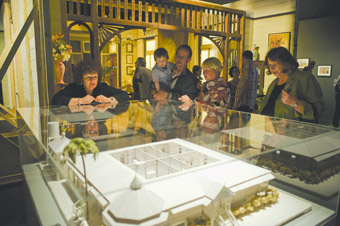
Australia exhibit, Setting the Scene, photo Nolan Bradbury
THE AUSTRALIAN CENTRE FOR THE MOVING IMAGE’S EXHIBITION SETTING THE SCENE: FILM DESIGN FROM METROPOLIS TO AUSTRALIA SHATTERS THE CINEMATIC ILLUSION TO UNCOVER THE IMPACT OF ART DEPARTMENTS, FILM ARCHITECTS AND SET DESIGNERS ON THE HISTORY OF CINEMATIC STYLE. THIS EXHIBITION EXPLORES THE PROCESSES OF CREATION IN THE CONSTRUCTION OF ILLUSORY SPACES AND REVEALS HOW AESTHETICS INFLUENCE TONE, MOOD AND ATMOSPHERE IN THE CINEMA.
Setting the Scene is based on the Deutsche Kinemathek’s Museum für Film und Fernsehen exhibition Moving Spaces: Production Design + Film. The German and Australian curators collaborated to develop a series of diachronic “spatial constellations”, emphasising the evolution of art design and the impact of old and new technologies. ACMI’s exhibition is organised into interrelated zones including: Spaces of Power, Private Spaces, Labyrinth Spaces, Transit Spaces, Stage Spaces, Virtual Spaces and Location Spaces. What emerges is a heterotopia of design with more than 300 exhibits of still and moving images, concept artwork, storyboards, computer visualisations and scale models that coalesce and collide, producing dynamic contrasts and connections by prioritising art design.
The Spaces of Power constellation illustrates the signification of control in the depiction of vast spaces, minimalist design, monumental architecture and access to vision. This area is dominated by a large film still showing the prodigious elevated office designed by Erich Kettelhut for Fritz Lang’s Metropolis (1927). The graphic symmetry of the gigantic window combined with heavy furniture supporting futuristic communications technology renders Jon Fredersen (Alfred Abel) a God-like figure, able to survey and control the city. Images of the subterranean war room set for Dr Strangelove or: How I Learned to Stop Worrying and Love the Bomb (Stanley Kubrick, 1964) display a space filled with screens showing maps the size of walls, extending the connection between power and magnitude into the realm of parody. Both upper and lower spaces are constructed for surveillance and to inspire paranoia through cinematic revisions of Jeremy Bentham’s Panopticon.
While these images are striking examples of control built from monumental set design, one of the smaller artefacts included in Spaces of Power reveals how illusions of entrapment can be created in miniature. A glass box protects a small set built by the production designer Herman Warm for Robert Weine’s The Cabinet of Dr Caligari (1919). This model is the location of the prison scene, its black background with parallel white lines descending towards a spot on the floor are used to direct the eye to the hypnotist/murderer and to radiate a sense of his torture. This exhibit also underlines the influence of the German Expressionist visual style with its high contrast, painted light and shadows, absurdly dysfunctional architecture and its cities built on jagged lines.
The first screen of the Private Spaces zone features a scene from Jacques Demme’s recitative musical The Umbrellas of Cherbourg (1964). Demme’s art director Bernard Evein and costume designer Jacqueline Moreau collaborated to develop scenes based on a specific colour palette. The design of wallpapers and fabrics complement costume, resulting in a visual style so inextricably bound to mood and tone that textures become as expressive as characters. In one scene blue floral wallpaper in the bedroom seems to imply that Geneviève (Catherine Deneuve) sleeps in a watery interior garden. A scene from Jacques Tati’s Mon Oncle (1958) shows a neighbour touring the sterile, empty spaces of the villa Arpel, teetering across the concrete floors on her stilettos, barely able to sit on the furniture which exists for its design, not for comfort. This dysfunctional modernism barely conceals the social critique created by Jacques Lagrange’s spatial design and inherent in Tati’s cinema. The exhibition includes a model of the candy coloured modernist cube house with its obsessively manicured garden surrounding a giant fish water sculpture. The model has buttons that tilt a garage door open and animate a terrier in a tartan coat.
Research photographs, film stills, sequences and a model of the maze from Stanley Kubrick’s The Shining (1980) are the most compelling aspects of the Labyrinth Spaces constellation. In Kubrick’s film, the Overlook Hotel is transformed into a site of terror with labyrinthine corridors carpeted in alarmingly contrasted colours, elevators filled with gushing blood and hallucinatory images of decay and death behind the doors of hotel rooms. Ray Waller’s production design reveals how cinematography and Steadicam can be used to insert a gliding spectral presence in interior and exterior mazes. Dante Ferretti’s film design, inspired by the Italian artist Giovanni Battista Piranesi, is also exhibited here, with production photographs and a wooden model of his staircase leading in all directions, but ultimately nowhere, from The Name of the Rose (Jean-Jacques Annaud, 1986).
Transit Spaces become visual signifiers of Marc Augé’s notion of “non-place.” Steven Spielberg’s The Terminal (2004) is filmed on a bespoke, full-sized airport terminal set built by Alex McDowell and including escalators, elevators, furnishings and 35 retail franchises. Spielberg used a periscope camera to check camera angles. The airport terminal set is a heightened non-place, its depersonalised sites of transience and anonymity emphasise movement rather than stillness. Such a transit space becomes a home for the protagonist. A model of the set, sequences from the film and interviews with the production staff reveal the film’s base in the story of the Iranian refugee Merhan Karimi Nasseri (aka Sir Alfred) who was condemned to live in a Parisian airport for 10 years.
Whilst the 1.5 scale model of the Mach 5 car in Speed Racer (Wachowski, 2009) looks like a toy, it represents the zenith of futuristic set design. For this film the Wachowski brothers and their production designer, Owen Patterson, used “virtual cinematography” to create “reality bubbles.” Curator of Setting the Scene, Kate Warren, explains that Speed Racer’s composite spaces were built from digital images of locations including Italy, Morocco, and Death Valley. These panoramas were then stitched together, manipulated and composited resulting in the creation of an artificial global space that is both everywhere and nowhere.
Australian art directors have high profiles in Setting the Scene. The highly stylised visual aesthetic developed with Tracey Moffatt by Stephen Curtis on studio sets for Night Cries: A Rural Tragedy (1989) and beDevil (1993) created surrealist inspired hyper-stylised landscapes. But some of the most striking images are shot on location, using few visual effects. A montage of research photos of post-apocalyptic locations shot by Chris Kennedy reveals images of New Orleans post-Katrina, Mount St Helens, mines in Pittsburgh and a deserted theme park in Pennsylvania, all preparation for The Road (John Hillcoat, 2009, based on the Cormac McCarthy novel of the same name), a film yet to be released in the cinema.
All paths in Setting the Scene lead to the showcase exhibit, Baz Luhrmann’s Australia (2008). This constellation includes topographic maps and interviews with art director Catherine Martin describing her initial ideas for the design, the impact of the landscape and the ways that design signals a narrative turn and implies cultural change. The most imposing and intriguing exhibit in Setting the Scene is the living room set of Faraway Downs, a key location for Australia. The set has been recreated specifically for ACMI’s exhibition and the visitor can peer into the domestic space and see the combination of European influenced heavy leather furnishings and pristine cut glass decanters sitting alongside woven baskets, boomerangs and bark sculptures. In Australia, visual design enables a subtle shift towards the inclusion of Indigenous cultures.
Setting the Scene provides a heterotopia of visual design constructed from an array of art and artefacts representing disparate times, spaces, ideas and possibilities. This exhibition highlights the visual affect, privileging the pathways, networks and rhizome-like connections between contemporary art direction and visual styles of the past and the future. With Setting the Scene, ACMI has curated a dynamic archive of the work of local and international art directors, revealing film design to be a radically evolving art form.
Setting the Scene: Film Design From Metropolis to Australia, Australian Centre for the Moving Image in collaboration with Stiftung Deutsche Kinemathek, Museum für Film und Fernsehen, Berlin; Melbourne, Dec 4, 2008-April 19, 2009
RealTime issue #89 Feb-March 2009 pg. 19
© Wendy Haslem; for permission to reproduce apply to realtime@realtimearts.net
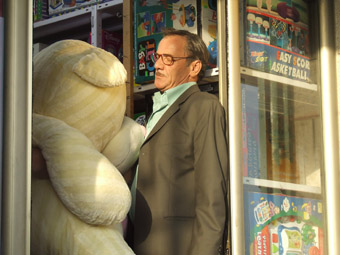
Laila’s Birthday
CULTURAL MEDIA’S MISSION IS TO STRENGTHEN INTERCULTURAL UNDERSTANDING BETWEEN DIVERSE AUSTRALIAN COMMUNITIES THROUGH THE PROMOTION OF ARAB ARTS AND CULTURE. THE FIRST PALESTINIAN FILM FESTIVAL, A NEW INITIATIVE FROM CULTURAL MEDIA—A NOT FOR PROFIT ORGANISATION ESTABLISHED IN 2007—SCREENED OVER TWO WEEKENDS IN DECEMBER AT PALACE NORTON STREET CINEMAS AND SIDETRACK SHED THEATRE IN MARRICKVILLE. IT DREW LARGE, DIVERSE AND ATTENTIVE CROWDS WHO DEMONSTRATED THAT THERE IS INDEED A GREAT HUNGER FOR MORE OPPORTUNITIES TO ACCESS AND ENGAGE WITH PALESTINIAN LIFE AND CULTURE.
The program showcased a broad spectrum of films ranging from six acclaimed feature films to independent documentary production and university sponsored educational materials. The feature film with the highest profile was Annemarie Jacir’s Salt of This Sea. It had screened in Un Certain Regard at the Cannes Film Festival in 2008, was Palestine’s 2009 Academy Awards submission for Best Foreign Language Film and has won a number of awards at international festivals.
Shot in Palestine under difficult conditions, Salt of This Sea follows Brooklyn born and bred Soraya (Suheir Hammad) as she lives the dream to return to Palestine, from which her family was exiled in 1948. Stubbornly trying to reclaim her grandfather’s savings, frozen in a bank account in Jaffa when he was exiled in 1948, she is slowly taken apart by the reality of Palestinian life around her. She meets Emad (Saleh Bakri), a young man whose ambition, contrary to hers, is to leave his home in Palestine forever.
The other fiction feature film in the program, Laila’s Birthday, directed by Rashid Masharawi, follows a complicated day in the life of Abu Laila (Mohammed Bakri) an unemployed judge currently driving his brother-in-law’s taxi to make ends meet. His quest to get a present and a cake in time for his seven-year-old daughter’s birthday is constantly interrupted by surreal, sometimes comic events.
This film captures the streets of Gaza through the windows of Abu Laila’s taxi. The conversations with passengers, and the ordeals to which the taxi is submitted, capture the state of affairs in the territory in all their absurdity and poignancy. Each unpredictable daily difficulty cumulatively begins to wear on Abu Laila, unbeknownst to those he encounters, who continue to make their insistent demands. He finally cracks as he waits for his taxi to be refuelled, unleashing a tirade through a megaphone wrestled from him by its policeman owner. Returning home, Abu Laila finds peace as his daughter giggles at the state of his taxi, accidentally decorated for a wedding during the course of the day’s many events.
On a different note, Reel Bad Arabs and Edward Said on Orientalism, both directed by university professor Sut Jhally, were built around interviews with the authors of significant books on the representation of Arabs in the West. Both films provided sophisticated discussion about the politics of representation. The publication of Said’s Orientalism in 1978 resulted in major shifts in contemporary thought, still reverberating around the world today. However, although Said talks here about the context in which his argument was first conceived and extends his discussions of the concept of Orientalism to media representations, the film shows its age and does not extend the late writer’s insights to the contemporary political situation subsequent to his death.
Sut Jhally’s other film is based on the book Reel Bad Arabs: How Hollywood Vilifies a People, written by Jack Shaheen, Professor Emeritus of Mass Communication at Southern Illinois University. The video successfully integrates interviews with Shaheen and clips from myriad movies ranging from blockbusters featuring the likes of Arnold Schwarznegger right back to some of the earliest representations in the history of cinema—an excellent companion piece to Said’s Orientalism.

Sling Shot Hip Hop
The most talked about film of the festival was Slingshot Hip Hop, directed by Jackie Reem Salloum. This unique documentary deftly intertwines stories of young Palestinians living in the West Bank, in Gaza, in refugee camps and inside Israel as they discover the power of hip hop as a tool for self-expression and cross-border communication.
Slingshot Hip Hop traces the origins and development of hip hop amongst two distinct groups, one located in the West Bank, the other in Gaza, its members young, male and female, who initially struggled against Israel’s stringent travel restrictions to meet each other. That was until they gained the support of an organisation promoting youth development projects across Palestine. These groups build hip hop into an educational tool to teach young people, to provide an outlet for self-expression and connectedness, which throughout the film is voiced in entirely non-violent terms. After the recent devastating attacks on Gaza, no doubt many who saw the film will be worried about the current circumstances of the young men and women from the group, whose stories imprinted themselves so strongly.
Writers on the Borders: A Journey To Palestine(s), directed by Samir Abdallah and Jose Reynes, likewise travelled across Palestine following artists and storytellers. It documented the journey of eight writers from the International Parliament of Writers who travelled to Palestine to visit renowned poet . Darwish, who could not leave his own country to attend their international festivals. This film continues Cultural Media’s focus on Mahmoud Darwish, following an event celebrating the life and work of the Palestinian poet at the NSW Writers Centre in October 2008.
Writers on the Borders incorporates the diverse perspectives of the international writers on the trip, each of whom muses on their experiences of Palestine in an impressive array of languages. This is integrated with readings by Darwish and others at events set up throughout the film and exciting to witness. Relentless in its documentation of almost every detail of the delegation’s journey, Writers on the Borders also successfully produces a series of intense eyewitness accounts of Israel’s ongoing, systematic project to devastate and disrupt the everyday lives of ordinary Palestinian people. It provided a useful context for understanding the relentlessness of Israel’s most recent attack on Gaza. Among many injustices, the writers encounter roadblocks designed to prevent access to universities and homes and farmland freshly bulldozed to make way for the ever-expanding Israeli incursion into Palestinian territory. Such details tend to make it to our television screens only in times of crisis.
The Palestinian Film Festival successfully brought together a diverse array of people to share many different encounters with Palestinian life. Let’s hope it becomes a regular event on the Sydney screen culture calendar and has the opportunity in the future to travel to other parts of Australia.
2008 Palestinian Film Festival, festival artistic director Sohail Dahdal; Cultural Media, Palace Norton Street Cinemas, December 5–7; Sidetrack Shed Theatre, December 13–14
RealTime issue #89 Feb-March 2009 pg. 20
© Megan Carrigy; for permission to reproduce apply to realtime@realtimearts.net
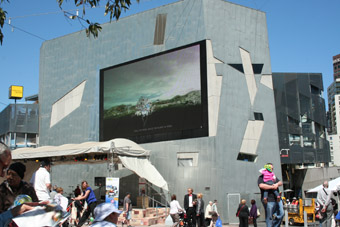
Seed Collective, www.seedcollective.org
photo Gabe Sawhney
Seed Collective, www.seedcollective.org
THEY’RE IN OUR POCKETS, THEY’RE IN OUR HOMES, IN OUR CARS, AND THEY’RE ALL AROUND OUR URBAN ENVIRONMENTS. IT’S HARD TO THINK OF A METROPOLITAN EXPERIENCE THAT ISN’T THOROUGHLY OVERLAYED AND INTERLACED WITH A HUGE VARIETY OF DIFFERENTLY SCALED SCREENS. THIS IS WHAT FIRST CAUGHT MY EYE AND LED ME TO ATTEND THE URBAN SCREENS EVENT IN MELBOURNE AT THE START OF OCTOBER 2008. HOW DO WE DEAL WITH ALL THESE IMAGE SURFACES AND NETWORKED DISPLAYS THAT TYPIFY THE PRESENT GLOBAL PUBLIC SPHERE?
When we think urban screens (as opposed to sub-urban, ex-urban or non-urban ones?), we typically conjure images of oversized projections strangely attached to Gehry-like buildings in hypermodern CBD plazas. Think Seoul. Think Times Square. Think Fed Square.
While the Bladerunner-scale of the moving image takes hold of our imagination and tends to hog centrestage, Urban Screens Melbourne 08 took a broader and more expansive view of the spatial impact of screen technologies in contemporary culture and cities. Urban screens can be seen as providing a new digital layer to the city, an augmented media space that folds and flexes its way into and out of contemporary urban experience. It was the event’s engagement with this broad field that made Melbourne’s Urban Screens 08 such an engrossing and stimulating event.
The third in an ongoing series of international projects (the first was held in Amsterdam in 2005 and the second in Manchester in 2007; RT84, p30), the Melbourne program focused its conference and related events around the theme of “Mobile Publics.” Consisting of a series of keynote addresses, panels and discussions, the conference provided a framework for the presentation of a wide variety of media works presented in public urban contexts. This multimedia program was developed by Mirjam Struppek, who was one of the originators of the Urban Screens conference in Europe, and a founding member of the newly established Urban Screens international network. The Mobile Publics Conference was jointly developed and presented by Scott McQuire, Nikos Papastergiadis and Sean Cubitt from Melbourne University’s School of Culture and Communication, and set the intellectual scene for the event as a whole.
It could be argued that Fed Square houses one of the most successful implementations of a large screen in a public mall/piazza space. Filling up an entire city block, the square was purpose-built in 2002 as a public meeting place for Melbourne. As Kate Brennan (CEO of Federation Square) noted in her opening remarks and comments during later discussions, the Fed Square screen has been programmed by the authorities/managers of that space at the same time as it’s been claimed by the general public. We see this most clearly in the public assemblies and displays of mass emotion around major sporting events and significant moments in our collective political and social history—witness the crowds around this and other large public screens for the Prime Minister’s Apology.
But does this mean that these outdoor screening spaces are appropriate for contemporary artists and media makers? Through the multimedia program, film screenings and joint broadcasting initiative, curator Struppek strove to engage audiences in the social/technical space of the Fed Square environs. This extended from the main 65-square metre Barco screen in the outdoor plaza to numerous indoor and outdoor public LED screens, interactive ticker screens and temporary projection installations. The scale of the programming, and the scope of the works was impressive, though ultimately impossible (for this reviewer at least) to see it all.
The large screen space was used to engage passersby in contemporary interactive works such as MobiToss—MobiLenin by Jurgen Schelble from Finland, SEED by Canadian artists Napoleon Brousseau, Gabe Sawhney, Galen Scorer, Dave Reynolds and Adam Bacsalmasi, and Troy Innocent’s x-milieu abstract interactive installation.
This context and curatorial strategy for works presented in Melbourne is not at all like the infamous SPOTS media façade in Berlin which began showcasing large-scale interactive artworks in 2005. Although this ‘screen’ and others of its kind in Europe were (for some time at least) devoted exclusively to electronic art and experimental/alternative content, the standard large TV format of Fed Square provides a very different, and arguably more difficult set of constraints for artists to work with. Many of the attempts I witnessed to involve the public in this kind of interactive engagement were not particularly successful, and highlight the complexity of making urban scale works that connect with ‘random’ publics.
The interactive program was complemented by a series of projection-based works that played open-air-cinema style in the evening. This is where the scale of screen, urban context and bodily rhythms of the audience fell into sharpest relief. It is incredibly difficult for these works to grab the attention of the casual passerby who has to find an entry point and an acoustic space for linear works such as these. A bit like outdoor cinema for the avant-garde, these works struggled to connect with the mobile and disengaged audience. Without the organising principle of a public political or sporting event, our bodily engagement with this form of public/social space collapses.
A number of speakers at the conference demonstrated these dilemmas from a variety of angles, focusing in on the ways media, art and technology collide with the practical construction and experience of urban space. Saskia Sassen’s opening night keynote was one of the highlights. Her talk, entitled “Heavy Metal and Fuzzy Logic”, neatly contrasted the liquid potential of media with the solid steel structures of the heavy architecture so predominant in the BMX Theatre where the conference took place. Building upon much of the work she has done as an investigator into global city/global slum (she invented the term), Sassen opened up a series of questions that were echoed by other presenters throughout the conference.
ANAT Director Melinda Rackham gave a beautifully illustrated overview of the types of work that artists and designers have been producing for a wide range of public spaces over the past few years. This helped set the scene for more culturally specific presentations by Yoshitaka Mori on “MobileTechnology Culture and the Emergence of ‘Mobile’ Subjectivities” in Japan and Aaron Tan’s impressive discussion of recent work from his Hong Kong design firm RAD. Other international speakers (such as Andreas Broeckmann, who spoke on the “Intimate Publics. Memory, Performance, and Spectacle in Urban Environments”, particularly as it applies to the contemporary reconstruction of Berlin’s social/screen space), and Leon van Schaik’s talk, “Spatial Intelligence”, expanded the theoretical horizons of the conference. Case studies presented by Manray Hsu on the Taipei Biennial and Soh Yeong Roh’s presentation on “The City as Open Creative Platform” were also noteworthy contributions to the discussions.
While it was difficult as a conference participant visiting from another city to find time to see all of the works presented around Fed Square in a couple of days, the informative display in the foyer outside the main conference theatre gave an interesting snapshot of the innovative ways that artists, designers and architects are dealing with screenspaces in urban settings.
It was apt to stage Urban Screens 08 at Fed Square, itself something of a success story in the unfolding narrative of large scale screens in public spaces. This event offered a number of provocative and fruitful ways into thinking about the claims made on behalf of public screenspace, and will provide stimulus for local endeavours in this field for some time to come.
Urban Screens Melbourne 08: Mobile Publics, Federation Square, Oct 3-5 www.urbanscreens08.net; www.seedcollective.org
RealTime issue #89 Feb-March 2009 pg. 21
© Ross Harley; for permission to reproduce apply to realtime@realtimearts.net
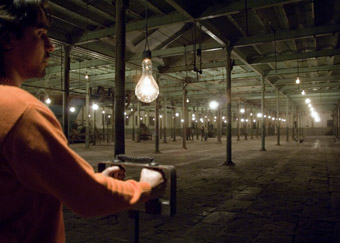
Pulse Room (2006), Mexico, Rafael Lozano-Hemmer
photo Antimodular Research
Pulse Room (2006), Mexico, Rafael Lozano-Hemmer
IN MARCH, RAFAEL LOZANO-HEMMER WILL BE ONE OF THE KEYNOTE SPEAKERS AT THE 2009 ADELAIDE FILM FESTIVAL. WHILE NOT A FILMMAKER IN ANY TRADITIONAL SENSE, LOZANO-HEMMER’S ART PRACTICE, WITH ITS INNOVATIVE USE OF LIGHT AND PROJECTION, IS HIGHLY RELEVANT TO THINKING ABOUT CINEMA IN A CONTEXT WHERE OLD DISTINCTIONS—BETWEEN FILM, PHOTOGRAPHY AND VIDEO AS SPECIFIC MEDIA, BUT ALSO BETWEEN CINEMA AND ART AS ZONES OF PRACTICE—HAVE ERODED.
Although he has been exhibiting for over a decade and half, Lozano-Hemmer’s only work so far shown in Australia was Homographies at the Sydney Biennale in 2006. (Fortunately, he maintains an excellent website with an archive of works, including extensive still and video documentation.) This should change over the next year or two, with projects under discussion for Melbourne, Sydney and Adelaide, as well as the acquisition by Tasmania’s MONA of the Pulse Room installation shown at the 2007 Venice Biennale.
One thing immediately evident in reviewing Lozano-Hemmer’s practice is his interest in working in series. This is signaled firstly in naming, notably the titling of his large-scale public projection works as “relational architecture” and his various gallery-based works as “subsculptures.” It is also manifested practically in the restaging of works in new locales and conceptually in the reconfiguration of elements of a work to explore a particular line of thought. Lozano-Hemmer notes: “Often I work parasitically: I scout a site, for instance, meet local eccentrics and stakeholders, and learn about its constraints and peculiarities. The project uses any of that information as a starting point for development. Other times I am interested in a phenomenon or an effect and pursue variations of that in different scales, or speeds or contexts.”
For instance, Vectorial Elevation (Mexico City, 1999-2000), Amodal Suspension (Tokyo, 2003) and Pulse Front (Toronto, 2006) all involved the utilisation of powerful searchlights in public space. Unlike the dominant modern aesthetic of centrally-controlled urban light spectacles, exemplified by Albert Speer’s notorious “light dome”, Lozano-Hemmer designed forms of public access, making operational the Lettrist proposal that “All street-lamps should be equipped with switches; lighting should be for public use.” While all three projects are united by the aim of redistributing social agency in public space, each deployed a different interface. In Vectorial Elevation, the lights were manouevered via an internet webpage which also became an open platform for comment; in Amodal Suspension the protocol centred on the mobile phone and SMS; while Pulse Front utilised a network of sensors to align the rhythm and orientation of 20 searchlights around the Toronto harbour with the pulses of passers-by.
Series also overlap. The sculptural interface for Pulse Front was similar to that initially developed for Pulse Room (2006), and the biometric principal has also informed recent works such as Pulse Tank (New Orleans Biennale, 2008) and Pulse Park (Madison Square Park, New York, 2008). Lozano-Hemmer comments: “I have done so many pieces with a pulse interface that I have been criticised for ‘recycling’ the interface and not truly innovating; my feeling about this is that it is an experimental approach where you must undertake these variations to get closer to developing a language or typology of interaction. Until a particular combination of media is in concert one does not really know how effective it will be.”
Interest in exploring the typology of interactions is also evident in his subsculpture series, which often involve the movement of massed identical objects. Homographies consisted of 144 fluorescent lights arrayed in a conventional modernist grid. Distributed at ceiling level above the Art Gallery of New South Wales’ main entrance court, the lights were mounted on moveable fixtures controlled by computerized surveillance systems. Seven cameras tracked the movement of visitors, triggering the rotation of the individual light tubes. A series of plasma screens along one wall showed visitors seen from the perspective of the tracking system overlaid with positional data. Wavefunction, which was first staged in Venice during 2007, consisted of nine rows of four chairs arrayed in a grid. The chairs, which combined the classic Eames plastic seat with the famous Saarinen base, filled most of a small rectangular room. As the audience entered the room and walked around, the chairs responded to their presence by moving up and down their vertical axes, generating complex ‘waves.’
Automated movement of objects often generates a strong sense of the uncanny. With works like Homographies and Wavefunction, surprise at the fact of movement is quickly overtaken by interest in the nature of the movement. It is not the position of any one object that is significant, but the movement of the set. What is being actively defined in the interplay between observer and set of objects is a field of relations. If the science of non-linear causality can be understood as the attempt to reconceptualise apparently random phenomena, this undertaking has been paralleled by the increasing importance that contingency and chance has assumed in modern and contemporary art. For Lozano-Hemmer digital media raise new possibilities of “programming without teleology.”
It is the uncertain nature of this encounter between the human and the technological which continually animates Lozano-Hemmer’s art. It also propels him into new forms of collaboration with both peers and audiences: “I programmed enough to know that I am a lousy programmer and thus I work with people who are very specialized…My model is similar to the performing arts: I am the director but there is also a composer, a programmer, a designer, a photographer or whatever other specialisations are required by the piece. In the end, though, there is a definite bias or idiosyncrasy that must be followed in order to ensure that the project has consistency.”
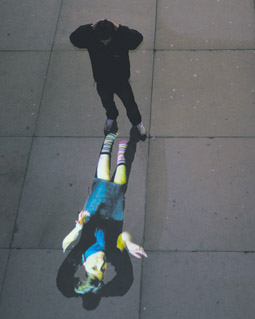
Under Scan (2008), London, Rafael Lozano-Hemmer
photo Antimodular Research
Under Scan (2008), London, Rafael Lozano-Hemmer
His large-scale public space works such as Body Movies and Under Scan demonstrate the potential for counter-intuitive uses of surveillance technology such as motion tracking systems to generate novel and creative forms of affective sociality. Body Movies involved the projection of a database of large-scale portraits onto the façade of a cinema in a public square. However, the portraits were rendered invisible due to powerful xenon lights directed on them at ground level. It was only when pedestrians walked through the square and interrupted the light that the projected portraits were ‘revealed’ in the silhouettes of their shadows. Similarly, Under Scan involved thousands of ‘video portraits’ projected onto the ground in central city thoroughfares and public spaces. The portraits appeared intermittently in the shadows cast by pedestrians, their absent subjects turning and then looking away as the passer-by left the scene. Both works used sophisticated ‘real time’ monitoring of pedestrian movement: in Body Movies, to switch to another set of images whenever all the portraits in a given scene were revealed, in Under Scan to ‘place’ portraits in a pedestrian’s predicted path. This design shifted the nature of ‘interactivity’ from its common reduction to choice from a menu of relatively predictable consequences to a far more open horizon in which contingency and unpredictability assumed a greater role. Instead of the logic of ‘taking turns’, where single users control the apparatus and produce representations that others watch, multiple users could simultaneously explore a multitude of different pathways.
These projects are not just about watching images, but depend upon the co-presence of the crowd— on interaction with others—in order for things to happen. Lozano-Hemmer stresses the active role of the public in ‘completing’ these works: “That’s a collaboration that has often been identified (for example in Duchamp’s maxim “le regard fait le tableau”) but now it is inherent to any interactive proposal. In the end Body Movies or Vectorial Elevation are platforms that are taken over by the public…If no one participates the pieces simply do not exist.”
Lozano-Hemmer’s platforms are notable in achieving a deft balance between individual agency and collective interaction, between active engagement and reflective contemplation. While technically sophisticated, they promote modes of interaction that are not simply instrumental. Passersby aren’t initially sure what is going on, but can best learn by joining in. Habit is suspended in favour of experimentation. When Under Scan was staged in London last November, Lozano-Hemmer found the location improved this experimental aspect: “The project in Trafalgar Square benefited greatly from the fact that there is already a lot of foot traffic at night. This meant people would just ‘encounter’ the work as they went home after work, for instance, rather than having to go to a specific site to see it.”
Despite their scale, the aim of these works is to initiate playful encounters rather than sublime experiences. Lozano-Hemmer observes that Under Scan “is quite underwhelming if your expectations are to see a grand cathartic spectacle in the tradition of son et lumiere or fireworks shows. Yes, we did use the world’s brightest projectors and covered 2,000 square metres with interactive portraiture, but the goal was in fact to create a situation of intimacy not intimidation. Technologies which are used for advertising, or Olympics or rock concerts are here transformed to deliver discrete, individual experiences with no proscenium, no preprogrammed narrative, no privileged vantage point.”
Intimacy is also a hallmark of the recent ‘pulse’ works such as Pulse Room which featured at the last Venice Biennale. The work consists of a grid of 100 incandescent light bulbs suspended in a room. The rhythm and intensity of each discrete light varies in response to the pulse of visitors measured when they grasp a sensor. As new users contribute data, the traces of past visitors move to the next position along the grid. Eventually, the room is filled with a complex pattern made from the mixing of 100 different heartbeats. It is a breathtakingly beautiful work which offers a profound image of the weaving of individuals into a collective without the loss of their uniqueness: an image of multitude rather than mass.
Adelaide Film Festival and Samstag Museum of Art, Art & Moving Image Symposium, Feb 27, 6pm, keynote address Rafael Lozano-Hemmer
RealTime issue #89 Feb-March 2009 pg. 22
© Scott McQuire; for permission to reproduce apply to realtime@realtimearts.net
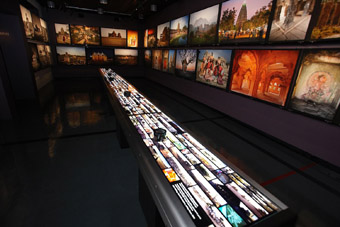
The Photography Room in the Ancient Hampi exhibition
photo Ben Healley, Museum Victoria
The Photography Room in the Ancient Hampi exhibition
VISITORS TO MELBOURNE’S IMMIGRATION MUSEUM HAVE AN OPPORTUNITY TO IMMERSE THEMSELVES IN PLACE-HAMPI, AN INNOVATIVE MULTIMEDIA, MULTI-SENSORY EXHIBITION THAT REVEALS THE WONDERS OF AN ANCIENT WORLD HERITAGE SITE IN INDIA. ON MY FIRST VISIT TO PLACE-HAMPI, A SMALL GROUP OF EXCITED INDIAN STUDENTS FILLED THE SPACE, THEIR VOICES DROWNING OUT THE SOUNDS OF THE EXHIBITION, THEIR SENSES ALIVE WITH THE FERVOUR OF THEIR INTERACTION. THESE STUDENTS WERE CREATING VIRTUAL JOURNEYS INTO CULTURAL HISTORY BY CONNECTING SPATIAL FRAGMENTS AND CONSTRUCTING NARRATIVES FROM THIS MAGICAL LANDSCAPE.
Place-Hampi is an exhibition that combines the imagery of archaeological sites and discoveries of ancient remains and relics with the sacred and the mythological. Experiments with new media technologies developed by Sarah Kenderdine and Jeffrey Shaw at the iCinema Centre for Interactive Research at the University of New South Wales have resulted in the convergence of archaeology and dreaming. Place-Hampi was commissioned for France-India year (Lille3000) and installed at Lille’s opera house in 2006.
Place-Hampi is divided into four interrelated exhibits presented across adjacent rooms. At the entrance, a topographical aerial map spread across the floor reveals a scaled down version of ancient Hampi. The map details Hampi’s terrain, the proximity of its monuments and denotes architectural features and historical locations. It also invites viewers to project themselves into the space by walking across the landscape. This hints at the interactivity to follow. Place-Hampi visually redefines Michel de Certeau’s differentiation of place and space. For de Certeau, while place is a geographically given and can be mapped, space is constructed by presence and engagement. Place-Hampi begins by defining geographic place and then invites the participant to construct their own sense of this space through movement, interaction and immersion.
The first room houses an exhibition of photographs shot by researchers over a 25-year period. This collection features Hampi’s vivid ochre and pink temples, monumental stone structures and elaborate architectural ruins. Some landscapes are illuminated by direct daylight while others are intensified by hazy sunsets. Layers of panoramic photographs fill the walls orienting visitors to the site, while smaller images spread across a tabletop light box can be inspected using a magnifier. Here the viewer shifts from tourist to investigator, scanning the photographs and focusing on details.
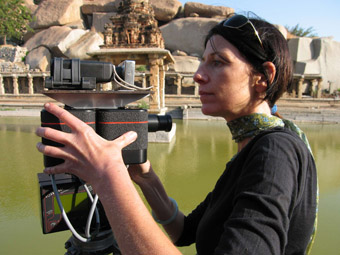
Preparing the Seitz VR Roundshot stereographic panoramic camera for photography at the Krishna Tank
photo S. Kenderdine
Preparing the Seitz VR Roundshot stereographic panoramic camera for photography at the Krishna Tank
The darkened central room requires interactive participation. A circular screen surrounds a user-controlled projection system that invites the participant to step on to a motorised platform and begin an exploration of the ancient landscape. Once on the platform, the user selects from a range of cylindrical dioramas, which are captured and navigated laterally. The driver has the ability to traverse the space and zoom in to investigate buildings and objects within the site. This virtual tour is created from “immaculate shots” of Hampi—images recorded using two stereoscopic 3D cameras. The visceral immersion that results offers a journey into a landscape where tourists can discover relics, visit ruins and explore the wonders of this sacred site.
Virtual tourists share the space with visitors to Hampi, both material and mythological. On the console, an LCD screen displays an alternative map of Hampi emphasising its symbolic links to Kishkinda, the mythological kingdom of monkeys. The surrounding screen reveals composited images of the Hindu deities Shiva, Ganesha, Sita and Durga, adding a hallucinatory vision to the experience. Artists at the Paprikaas Animation Studio in Bangalore created impressions of these Hindu gods, capturing and modelling their movements on the motion of classical Indian dancers. Sarah Kenderdine describes encounters with the mythological as “somatic engagement”, an embodied affect inspired by the Indian aesthetic tradition of chromolithography. The inscription of mythology over archaeology produces magical realism, connecting present with past to emphasise temporal continuity.
The final room repositions the virtual tourist as a researcher, presenting an impressive collection of the fieldwork that underpins Place-Hampi. Images of archaeological artefacts, newspaper articles, historical photographs and journal entries are imprinted onto plastic pages, which can be projected onto a large screen. The four rooms of the exhibition combine to present an experiential, exploratory (rather than didactic) connection with this ancient landscape. This virtual journey invites an embodied engagement, animating historical artefacts and Hindu gods with the use of new technologies. With their commitment to Place-Hampi, Melbourne’s Immigration Museum invests in new forms of exhibition to offer a unique experience and new imaginings of an ancient site, challenging its visitors to create space from place.
Place-Hampi: Inhabiting the Cultural Imaginary, Sarah Kenderdine and Jeffrey Shaw with John Gollings, Paul Doornbusch, Dr L Subramaniam and Paprikaas Animation; Immigration Museum, Melbourne; Nov 13, 2008-Jan 26, 2009;www.icinema.unsw.edu.au/projects/prj_hampi.html; www.place-hampi.museum
RealTime issue #89 Feb-March 2009 pg. 23
© Wendy Haslem; for permission to reproduce apply to realtime@realtimearts.net
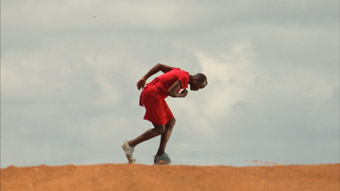
Nora
FILM DIRECTOR DAVID HINTON WAS IN SYDNEY IN NOVEMBER 2008 TO FACILITATE THE SECOND DANCE SCREEN LABORATORY RUN BY CRITICAL PATH AND REELDANCE. UK-BASED HINTON HAS DIRECTED NUMEROUS AWARD-WINNING DANCEFILMS MADE WITH ARTISTS SUCH AS DV8 PHYSICAL THEATRE, RUSSELL MALIPHANT, WENDY HOUSTOUN AND ROSEMARY LEE. HE HAS MOST RECENTLY MADE THE POETIC BIOGRAPHICAL FILM ENTITLED NORA, ABOUT AFRICAN DANCER AND CHOREOGRAPHER NORA CHIPAUMIRE, COMMISSIONED BY EMPAC IN NEW YORK, AND MADE IN COLLABORATION WITH RUSSIAN DANCE SCREEN CURATOR AND FILMMAKER ALLA KOVGAN (SEE JUSTIN SHIH PEARSON’S REPORT ON THE NEW YORK DANCE ON SCREEN SHOWING, P25). HINTON HAS ALSO DIRECTED MANY NON-DANCE DOCUMENTARIES ON ARTISTS SUCH AS FRANCIS BACON, BERNARDO BERTOLUCCI AND JOHN CLEESE.
When did you start to work with choreographers and, as a documentary filmmaker, what drew you to dance?
I knew nothing at all about dance until my early twenties. When I was at university I studied literature and thought I was going to be a writer. So dance wasn’t anywhere in my orbit or the orbit of my friends…I came across it basically because I went to work in television as a researcher on the South Bank Show. A colleague of mine, Geoff Dunlop, made a very good documentary on Merce Cunningham in the 1980s…and it really opened my eyes onto a whole new world that I never knew existed, and which I found very exciting.
Then when I started directing documentaries for the program, one thing became clear to me very quickly…If you make a film about a writer, it’s fundamentally a journalistic exercise rather than a cinematic one. The writer may be a fantastic interviewee but there’s not much you can do, film-wise, apart from setting up a shot of them talking. Dance was by far the most cinematic of the art forms. The minute you walk into a dance studio it’s all about what you can articulate through image and movement. So coming from a literary background, I quickly realised that film can’t really carry much literary content and that if you want to make something very powerful in a cinematic sense, then words are not the way to do it. I needed to find non-literary ways of working, and dance seemed to offer the best possibilities.
The cinematic influences you revealed thoughout the Dance Screen Lab—it seems you came to those after you had discovered dance and found the relevance of those directors to making the most of the cinematic potential of dance?
The influences have been progressive: as the years go by you discover new things and have new concerns. One of the first things that made me interested in film at all was seeing Werner Herzog’s Aguirre, Wrath of God (1972). Up until that time I thought of the cinema as being James Bond movies. So, just as I’d grown up without dance in provincial towns in England, neither was film a big part of my life, certainly not art films. Someone like Herzog relates to dance because of the physicality of the work. He famously said, “film is the art of the illiterates”, and I suppose that relates to dance because its power is not literary.
What models of film were useful in adapting dance work that has narrative elements, or has specific things to say, such as the work of DV8 Physical Theatre?
An important thing to say about Dead Dreams of Monochrome Men (1989) is that we never thought we were making a dancefilm. When we made it I had no sense of there being a dancefilm culture such as there is now. In fact, one thing DV8 were emphatic about was that they hated the word ‘dance’ and called themselves physical theatre. So it is kind of ironic that that film is now talked about as an iconic dancefilm.
But isn’t the success of the film because of the connection or affinity with cinematic traditions? It was physical theatre, physical cinema, not dance.
For me what it represented was a chance to make a silent movie. It was a fantastic exercise in what can be expressed purely through action and image. Up until the end of the 1920s, every film was a dancefilm in the sense that it was all about what could be expressed through the body. There’s the issue of intertitles but, fundamentally, it was about the body. All the people that made cinema into an international success story—Keaton, Chaplin, Gish, Fairbanks—they are people who are very articulate with their bodies. All those references were in my mind when I did Dead Dreams…

Mko Malkhasyan, David Hinton and Alla Kovgan on the shoot of Nora
Let’s jump from there to your new film Nora and the idea that Sergei Paradjanov—an Armenian filmmaker—was a reference point for you and Alla Kovgan. That hardly represents an African aesthetic.
Well that whole production was a kind of cultural melting pot, which was one of the things I liked about it. Alla wanted to work with Mko Malkhasyan, a cameraman from Armenia, and Nora wanted the male lead to be played by Souleymane Badolo who comes from Burkina Faso. On the set there were five languages being spoken. Apart from his tribal language, Souleymane could only speak French, Alla was speaking Russian to Mko, I was speaking English to Nora, the line producer was speaking Portuguese to the police because that is the official language in Mozambique. Then Nora was speaking Shona to the local tribal people who were taking part in the film. So just practically speaking, communication was glorious if nightmarish.
We knew we weren’t going to make an ethnographic film. We weren’t making a documentary about Shona culture. Nora is a Shona who grew up in Zimbabwe, but she’s spent many years living in New York, absorbing a lot from ballet and American modern dance which had a big effect on the movement content of the film. And behind the camera we weren’t pretending to look at the world purely passively like a documentary maker, or to look at it with an African eye. Alla’s a Russian living in America and I’m English and Mko is Armenian and it was very interesting for us to find a vision for the film that we all agreed on—but we found it a strong aesthetic, very vivid, that we all really like.
It reminded me of the Haitian footage that Maya Deren shot—in slow motion and trying to get inside this trance dancing that’s so powerful. And I’ve been thinking about the specificity of bodies, exemplified in the solo dancer in Nora—you are not watching an actor embodying a character, you are watching someone using their ‘real’ body and gestural world. So there is an affinity between dance and documentary.
Yes, it’s become a big issue for me. I’ve been thinking a lot about authenticity in dance which is a huge part of its appeal; the fact that they are actually doing it. That’s what makes it different from acting, which is pretending. And it’s a massive issue how you achieve authenticity in dance on film.
So we are not talking about documentations of dance but the way in which the poetic film structures you find in dancefilm can still contain these very real and authentic film performances.
I’m really interested in both extremes. Paradjanov and Bresson—he’s another one—these directors are basically control freaks. It’s the same with Busby Berkeley. The person making the film has a very clear vision of what they want to create and I kind of like those creative visionaries; people who find the performers they need to fulfil their vision and that’s all they require of their performers…anything else they give is just a nuisance.
And that’s exactly how choreographers can operate.
Absolutely, and often a lot of the tension between choreographers and directors is that they are both used to being tin gods in their professional worlds. It can be hard for them to give it up when they collaborate.
But a director who has a choreographic way of working with moving bodies and staging them for the screen—the way Paradjanov and Bresson do—that’s something you are able to do.
There’s a lot of different ways to make good work. The freedom is there to experiment as much as you like and take your influences from anywhere you like. Working in dancefilm now is like working in Hollywood in 1910—the rules haven’t been invented yet. You might make good work by being very controlling, or by allowing your performers lots of freedom. What interests me is when people really make up their minds, really make a decision about what they’re trying to do, and then push it as far as it will go. Then the result won’t be bland. I’m fundamentally incredibly optimistic about the future of the form.
RealTime issue #89 Feb-March 2009 pg. 24
© Erin Brannigan; for permission to reproduce apply to realtime@realtimearts.net
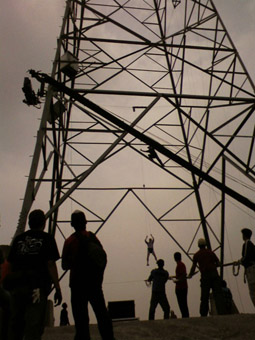
Mysteries of Nature, Dahci Ma
IT IS A COLD GREY DAY IN EARLY JANUARY, AND I AM WINDING MY WAY NORTH ALONG THE HUDSON RIVER TO TROY IN UPSTATE NEW YORK. AMIDST HARD-PACKED SNOW LITTERING THE SIDE OF THE ROAD AND SLEEPY INDUSTRIAL BUILDINGS AWAITING REVITALISATION RISES THE BRAND NEW CURTIS R PRIEM EXPERIMENTAL MEDIA AND PERFORMING ARTS CENTER (EMPAC)—AN AU$300 MILLION ARTS, TECHNOLOGY AND SCIENCE CENTRE FOUNDED BY RENSSELAER POLYTECHNIC INSTITUTE AND OPENED IN OCTOBER 2008.
A monumental glassy structure perched on the side of a hill, the building contains an acoustically awesome 1200-seat concert hall, a theatre, two large studios able to be used as residency spaces, recording studios or flexible presentation environments, and a clutch of offices. With an emphasis on research and a healthy slate of commissions and residencies to date, EMPAC seeks to provide both a place and program in which technology and the arts can inform and transform one another. A curatorial team led by director Johannes Goebel together with the new building’s state-of-the-art facilities—from custom-designed soundproofing panels to its connection to Rensselaer’s own on-campus supercomputer—promise exciting opportunities for audiences, artists and scientists alike.
On the day of my visit concentrated activity was taking place in the theatre, as filmmaker Brent Green prepared for the coming season, and in one of the studios as a team of people experimented with 3D cameras and a live feed. New media artist Sophie Kahn and choreographer Lisa Parra had set up residence in a tiny blacked-out space high in the building where they were working on a new video installation, body/traces, one of this year’s EMPAC DANCE MOViES commissions.
A project started by EMPAC’s Dance/Theater Curator Hélène Lesterlin in 2007, with a gift from the Jaffe Fund for Experimental Media and Performing Arts, the commissioning program supports new work from the Americas in the field of experimental dance film and video. The commissioning program has now been through two highly competitive open calls for proposals, helping to produce four dance films in 2007/08 and three films and body/traces in 2008/09. For a field of practice that has been dominated by European makers, and (given our relative sizes and access to funds) is well represented by Australian and New Zealand practitioners, the EMPAC DANCE MOViES initiative provides a welcome boost to dance screen production in North and South America.
If the inaugural EMPAC commissions are anything to go by, there is a strong and diverse field of activity waiting in the wings. Last year’s four films premiered at EMPAC’s opening in October where they drew capacity crowds to the concert hall. I had the opportunity to see them at the 37th Dance on Camera Festival at New York City’s Lincoln Center one late night in January this year.
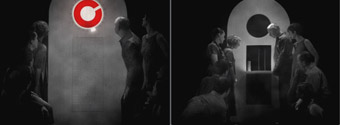
Matchbox, Daniel Belton
The program included Victoria Marks and Margaret Williams’ Veterans, a film featuring five young US veterans with post-traumatic stress disorder who play out memories of combat on the streets and beaches of LA. In Joby Emmons and Elena Demyankenko’s Kino-Eye a lone dancer’s moves through a Moscow apartment building are captured via video surveillance. Using split screen techniques to emulate the layout of security monitors and grainy, glitchy footage produced by the equipment, Emmons reminds us of the surface of the screen as both a flat assemblage of time and colour as well as a voyeuristic window in on the action.
PH Propriedad Horizontal is an excellent short from Argentinean team David Farías, Carla Schillagi and Maria Fernanda Vallejos. An abstract study of holding and being held, gravity and counterbalance, and the geometry of a long narrow alleyway, PH uses close-ups, extreme camera angles and editing to explore rhythm and relationship between the dancers, and between the dancers and their architectural space.
A highlight of the festival was the final EMPAC commission, Nora, directed by Alla Kovgan and David Hinton. Based on the life of Zimbabwean-born dancer Nora Chipaumire, this film is part biopic, part fable, part dramatic cinema and part dance film. Filmed on location in Southern Africa and lusciously coloured, Nora engages with concepts of self and memory, and the active process of remembering, using a language of dance. The traditional tools of filmmaking—lighting and landscape, pacing and movement—draw out story and character, and a searing performance by Chipaumire as herself, her mother, her father and other characters provides a strong emotional centre. Tableaux are carefully composed within the frame and in a gesture towards silent film scenes are punctuated by brief and sometimes humorous intertitles.
Cinema history emerged as one possible theme for this year’s Dance on Camera, with packed houses jostling elbows and braving sub-zero temperatures for a tribute to Busby Berkley, and several shorts in other sessions recreating early cinema aesthetics in new ways. Of these, Richard Move’s Bardo, a study of light on the human form after Martha Graham’s 1930s recording of Lamentation, and New Zealander Daniel Belton’s films Matchbox and After Durer were most notable. Belton, also a finalist in last year’s ReelDance Awards, has developed a highly distinctive style of dance filmmaking in which his dimly lit cast of characters is cleverly manipulated through speed and scale to create a flickering, black and white, Buster Keaton-like world of games, strange instruments, construction and toy theatre.
Korean filmmaker Dahci Ma’s Mysteries of Nature was the winner of the Festival Jury Prize. An accomplished and poetic contemplation of primordial and urban environments, Ma follows fingers probing at a downy skin, children emerging from mud and a man who becomes a torn plastic bag blowing in the wind. Unconventional screen proportions, a sharply dissected frame and inverted camera angles create dizzying but ultimately intriguing perspectives.
37th Annual Dance on Camera Festival, New York, Jan 6-17
RealTime issue #89 Feb-March 2009 pg. 25
© Justine Shih Pearson; for permission to reproduce apply to realtime@realtimearts.net
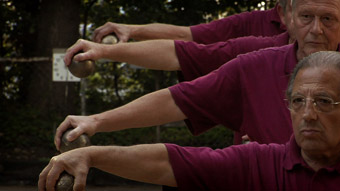
La Boule d’Or
photo Mario del Curto and Marc Perroud
La Boule d’Or
ALL FESTIVALS ARE ESSENTIALLY WORKS IN PROGRESS, WITH NEW DIRECTIONS AND DEVELOPMENTS EVOLVING AND ADAPTING FROM YEAR TO YEAR. NOW IN ITS ELEVENTH INCARNATION, DANCE FOR CAMERA, RUN BY SOUTH EAST DANCE AND SCREENED UNDER THE UMBRELLA OF BRIGHTON’S CINECITY, IS THE LONGEST ESTABLISHED OF THE BRITISH SCREENDANCE CIRCUIT, WITH NEW INITIATIVES THIS YEAR SIGNALLING A SHIFT BEYOND THE REMIT OF TRADITIONAL PROGRAMMING.
Proceedings began with Screendance Expanded, a one-day symposium, jointly organised by University of Brighton, providing a gathering point for the otherwise geographically scattered screendance community, and attracting an internationally representative mix of students, artists and academics. Following keynote speeches from Vena Ramphal and Sarah Wood, sessional focus shifted between funding, providing for youth and distribution, with a discussion forum highlighting the currently narrow range of opportunities—including Birminghan-based Dance TV and BBC commissioning—for televised and cinema-based screening. A workshop on future trends underlined the importance of advocacy and artist-led curation, with former BBC producer Bob Lockyer emphasising the need for bridge-building between contemporary production models. In addition, a panel exploring modes of discourse included visual arts writer Sally O’Reilly and dance critic Donald Hutera, foregrounding the potential of critically-led cross-pollination for a genre hindered by lack of specialist writing.
Within festival scheduling, sell-out status required an immediate repeat screening for a newly introduced, experimentally oriented program of predominantly short, single mood works. These included Christina Von Greve and C-Schulz’s intensely-focused abstraction of intermittent light sources in the monochromatic Flicker (2006); Phil Harder, Rosanne Chamecki and Andrea Lerner’s pleasingly fanciful use of stop frame animation in Flying Lessons (2007); Yves Ackermann’s deconstruction of shoot-em-up mores in Prototype (2007); and the opulent spectacle of Shelly Love’s The Forgotten Circus (2008). A complementary program of work in longer form featured Danièle Wilmouth’s A Heretic’s Primer on Love & Exertion: 29 Incidents of Dual Consequence (2007). Here, a highly-coloured picaresque world evolved from recurrent episodes of poker-faced text and task-based playfulness, with a movement vocabulary of clicks, swings, hops and jumps, linked and punctuated by a deftly rhythmic grammar of camera motion.
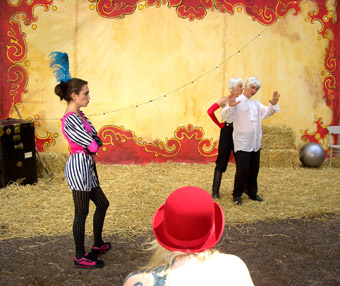
Heretic’s Primer
Also new to the festival, a quartet of documentary influenced work, selected from open call, uncovered a range of understatedly effective screen conceptualisations. Film editor Walter Murch has described the process of editing as “a kind of frozen dance” and Jonathan Perel’s 5 (Cinquo) (2008) skilfully utilised the potential of the kinetic bridge by intercutting between separately filmed versions of the same studio-set sequence. Bruno Deville and Philip Saire’s La Boule d’Or (2008) combined talking head interview with quietly assured camera positioning, alternating overhead and point of view shots as Saire coached four impassive, middle-aged boules players through stylised still positioning and elegantly composed walking patterns. Dirk Hilbert and Kasturi Mishra located the visual richness of Kathak-based studio footage within a contemporary Indian, city-based cultural context in Krishna’s Dancer (2006), while Gideon Obarzanek and Edwina Throsby’s Dance Like Your Old Man (2007) set voice over against front-on framing, as a series of young women inhabited the movement patterning and stylistic tics of their fathers’ social dancing styles, gently illuminating the complex blend of amusement, irritation and affection of one generation for another.
The first of two programs exploring non-traditional curation showcased work created in partnership with, and selected by, adults with learning disabilities. From Oska Bright, Oliver Turnbull, Miriam King and Simon Wilkinson’s The Man in The Hat (2007) reversed the workings of time and gravity as a single male figure negotiated an ambiguous, grey-scaled landscape of leaves and sky in a strikingly effective use of retrograde motion.
Meanwhile Fresh Takes—a parallel program selected by Youth Jury—drew attention to the intense physicality of the young male experience and to the integration of movement and location. Film theorist Siegfried Kracauer believed that screen-based dance should arise from context “as part and parcel of physical reality”, and in Craig Viveiros’ Stereo Step (2006), an apparently continuous Michel Gondryesque follow shot tracked street and social dance tropes through a densely populated series of exterior and interior spaces, additionally highlighting camera journey as choreographic device.
In a significant example of inter-genre lineage, a through-line was clearly traceable from Peter Anderson and Rosemary Lee’s physical and psychic interrelation of protagonist and surroundings in boy (1995) to Sergio Cruz’ visually sophisticated blending of still image and point of view shot in Animalz (2006), which imagined into being a natural context for the heightened physicality of pre-teen b-boys. Evoking the fluidity of adolescent identity, both works inhabit a liminal, shore-set landscape of scrub, sand and waves, with the “ramifications of the moment” layered into a poetically-oriented, non-linear mesh of elements and imagery, as outlined in Maya Deren’s notion of vertical narrative progression.
Of particular significance, an expanded program of installations sited in and around the Lighthouse building moved viewing engagement beyond a sit-down, front-on, single screen model. Work ranged in scope from mobile-phone-created, one-minute pieces to Jeremy Radvan’s digitised chalk-and-slate-style reinvention of Victorian visual forms in MyrioRama (2008), and Billy Cowie’s continuing experimentation with 3D imagery in The Revery Alone (2008). Here, in contrast to the highly realised environment integral to In the Flesh (2007), the traditional signifiers of performance—music, codified movement, costume—were stripped away, confronting the floor-bound viewer with their own response to the life-sized, hologramatic image of a naked female figure, suspended from four ceiling-fixed hand and foot grips, and silently shifting through gymnastic contortion in an uneasy exploration of the power dynamic central to the interchange of gaze.
Elsewhere, the highly polished visual stylisation of the Quay Brothers, shown as part of Cinecity programming in Eurydice—She, So Beloved (2007), combined large scale screen-based images with peephole-glimpsed miniaturised models, housed within a coffin shaped interior.
Luke McKernan has observed that the origins of cinema are tied to “the study of motion”, and new initiatives at Dance For Camera held up a mirror to the range of territory currently opening to pioneering artists and audiences within contemporary models of production; curation; presentation and discourse in an ever-expanding range of 21st century potentiality.
–
Dance For Camera, Brighton, UK, Dec 5-7, 2008; www.southeastdance.org.uk/danceforcamera2008
RealTime issue #89 Feb-March 2009 pg. 26
© Chirstinn Whyte; for permission to reproduce apply to realtime@realtimearts.net






































































